
Preface by Gary Gauer
Read this long, wonderful and emotional life story of a Lake Lillian farm family.
The first part of this story starts with Wilton and was posted here November 19 2016
The rest of the story includes Eleanor with their 4 children and grand children is added below January 11 2017
Another 42 photos inserted January 16 2017 and 18 more on January 19 2017
LaVonne begins:
This is the story of my dad’s childhood and up through his first year of marriage. His mother died when he was 9 years old. He was deeply affected by this and always had a soft spot in his heart for kids who lost a parent.
Wilton Malcolm Bomsta was born on July 22, 1917, the fourth child born to Henning and Hattie (Flann) Bomsta.
Wilton lived his whole life on his farm located on Sections 31 and 32 of Lake Elizabeth Township. (His wish was to die in the house he was born in but that did not happen.) He was baptized at the home of Ole and Mary Solomonson who lived near the lake across from Hanson’s by Rev. John O. Reitan from the Tromso Church. (Hattie’s family were early members.) The Tromso Lutheran Free church was heated with wood and a piano was used for music. There was a barn for the horses. They went to church for special holiday services if the weather permitted. Ice cream socials were a big event.

He attended District #43 Country School in Fahlun Township. This school was where four generations of Bomstas were educated; Adela, Henning, Wilton and three of Wilton's children, LaVonne, Annette and Stanley. Wilton and his brothers and sister walked two and one-half miles cross country to school. In the winter, they walked or skated along the ditch to get out of the wind. On occasion they only had left over pancakes with syrup on them in their lunch pails. Syrup came in pails. When the pail was empty, they were cleaned and used for a lunch bucket. Sometimes Wilton and Orville rode a horse to school bareback. There were barns at school and at the church in those days for the horses. On occasion the teacher would be late and the boys would open a window, climb in and start a fire in the wood stove. Students would have to stay after school as punishment for poor behavior. Wilton had to stay after school several times but one time he and Vernal & Donald Hanson were walking home after their detention time was finished when they came to the aid of their teacher, Mrs. Miles Peterson, who had a flat tire. The boys fixed her tire. She never kept him after school again and she gave each boy a nice new pencil.
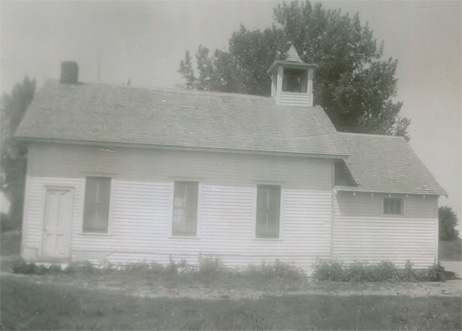
During recess in the winter Wilton would run across the "rubber ice" on the ditch that ran near the school. If he stopped he would fall through the ice. The students played Fox and Goose in the Pie, Blind Man's Bluff and other playground games.
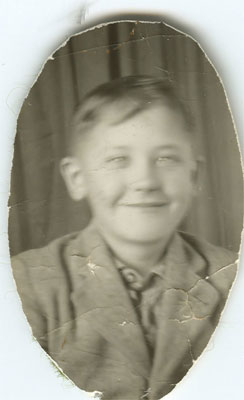
Wilton was good in arithmetic but poor in spelling. He didn't like English or Geography. He remembers being graded with numbers on his papers and is not sure if his report cards were number graded or letter graded. He did not go to school after eighth grade because there wasn't any bussing for students to go to High School in Willmar. He stayed home to help his dad on the farm.
Henning didn't have extra money to buy toys for his family so Wilton was creative and would make his own toys. He remembers using a board and putting on wooden spools for wheels to make toys. Wilton could buy new overalls at J.C. Penney's for $1.00 -1.50 and a pair of shoes for $3.00.
Wilton remembers attending an ice cream social at Tromso Lutheran Church after his mother had died. He overheard a woman asking about the Bomsta kids in Norwegian. Wilton was sure this woman wanted him so he ran and hid. He tells about the time in church when she sat eating an onion. At the end of the service, she got up to give her testimony. She talked so long that finally the Pastor and Harry Hawkins got up and led her out of the church.
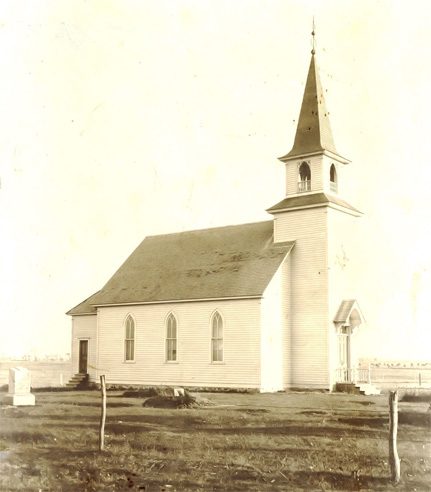
Celebrations were held at Swenson's woods by Lake Lillian on the 4th of July and at other times. They would dance all night. Wilton remembers going there while his mother was still living. They set up food stands and built a platform by the lake for dancing. Lester Hofstad, the Methodist preacher’s son would play the saw and the "mouth organ" at the same time. Joe Nielson, Guy Nielson and Andy Bomstad played the fiddle. Dave Swenson played the violin, also. He had the concession stand. He made an icehouse and hid liquor in it. Several people had a still in their woods to make "moonshine".
Dave Swenson, Alfred Anderson, Ninus Nelson and Axel Bomstad sang in a quartet from the Methodist Church. The Men's Quartet from Tromsø Lutheran Church was: Roy and Guy Nielson, Harvey and Gust Schelin. Lake Lillian was known for having good baseball games, plays and concerts for people to attend.
Occasionally, Henning borrowed his bull to his neighbor, August Carlson. One day as Wilton and Orville were walking to school the bull got loose and was headed for home. Wilton saw the bull coming so he and Orville climbed a near-by tree. They sat up in the tree for a long time watching the bull snort and paw the ground. Finally the bull went to the barn. When the boys were sure that the bull couldn't see them, they came down and continued their walk to school.
As a child Wilton was expected to help with chores. He helped to milk cows by hand when he was eight years old with his mother. In the summer they would milk the cows out in the yard. He would set up his stool and pail and begin to milk. If the cow moved, Wilton would follow and start up again. He also helped to feed chickens, pigs and turkeys. He drove the horses and walked behind the drag all day. The colts followed along in the field. Henning bought some work horses called “Hamilton.” They were crossed with Belgium horses. They had long legs and were fast walkers. When he was 8 years old, the new gravel road, County Road #4, was built. Wilton remembers going north to the Lake Elizabeth Creamery to deliver milk with his father. Henning would go in with the milk. Wilton never got to go in. His job was to stay and attend to the team of horses. Sometimes Wilton went with his dad in the Model T to the store at Rosendale.
When a farmer was working out in the field someone would be expected to bring a lunch out for them. One day Henning was working and Harlan and Wilton hitched “Lady” to a buggy and proceeded to the field. Something spooked the horse; she lurched forward and started to run. Wilton fell out of the buggy. Harlan managed to get her stopped and they delivered the lunch. The names of some other horses were “June” and “Tabby.” Wilton’s favorite horse was “Jane.” She was a smart horse who knew how to train other horses to work with the machinery. She even knew when it was time to go home for dinner at noon!!
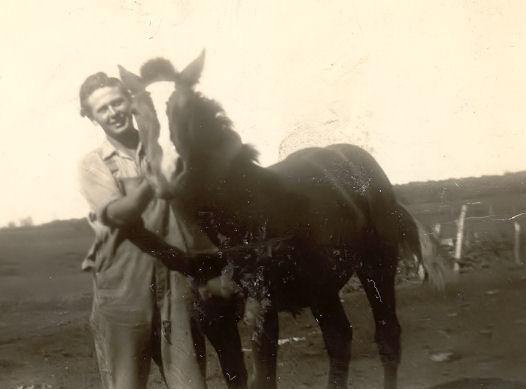
Life during the “Great Depression" was very difficult for everyone. Wilton's family ate a lot of fresh eggs, chicken and pork. They had cows so they had a good supply of milk, whipping cream and could churn their own butter. Staples and other groceries had to be charged at the local stores. A major drought took place. Lake Lillian Lake dried up. People would go out to the middle of the lakebed and plant potatoes hoping to find enough moisture for the plants to grow.
The first barn was small. Henning also had a straw shed for cattle and hogs. The big barn wasn’t built until 1934. It was built by Art Johnson. Henning had a government loan and they could not spend more than $700.00. The barn and two brooder houses were taken down in August, 2005.
There was a small chicken house, which was replaced by a larger one in 1942 plus other buildings and machine sheds built in 1974 and 1977. The corn crib was built in 1950.
Food was cooked and baked in enamel kettles and pans with a wood stove. When good wood was available the cook would have a nice even heat but when they were out of wood they had to burn corncobs. They burned very fast so it was difficult to cook the food. It might be burned on the outside and doughy in the middle. Wilton's favorite childhood foods were Deloris' chocolate or spice cake served with whipped cream on top. He also liked Mrs. Junkermeier's cake and Annie Swenson's lefse.
Wilton learned to drive early. They had a Model T. This model of car had an interesting foot pedal arrangement. Good coordination was required to operate this car. A relative and neighbor named Axel Bomstad was Wilton’s “buddy.” Axel had polio when he was young and was a sickly man who walked with a cane. When Wilton was 14 he drove Axel into Atwater to see the doctor. The doctor’s office was at the top of a long flight of stairs. It was very difficult for Axel to make it to the top with his bad legs. At age 15 Wilton went with his Dad to Minneapolis to deliver popcorn that Wellis would sell at the Fire Station where he worked.
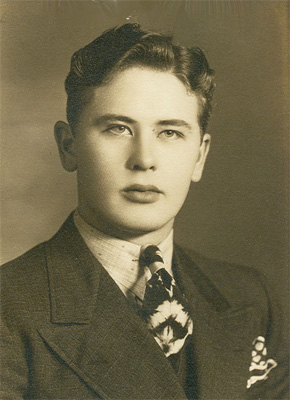
When Wilton was 17 years old, he was employed at the Woolen Mills in Litchfield, Minnesota. His job was to watch the shuttle for weaving black and red Mackinaw fabric that was used by Montgomery Wards to make jackets. He also filled the bobbins as needed. He earned $20.00 a week. After he was laid off, he went to Minneapolis to live with Harlan at Boomgaardens (Amelia Bomsta's parents) in 1937-38. He had a job bending skis for three months. He also tried being a salesman selling Raleigh Products to farmers south of Minneapolis. When he lived in Minneapolis, Wilton could ride the trolley car for a nickel or dime. He thought they were very wobbly. In April of 1938, Henning asked Wilton to return to the farm to help him and from that time he has always been a farmer.
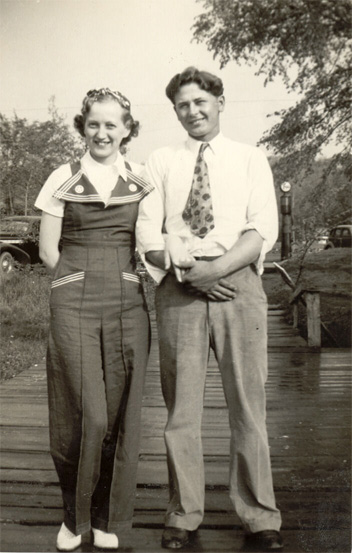
Eleanor and Wilton Lake Mille Lacs
In the spring of 1938 Eleanor Halverson was introduced to Wilton. He had come along with his cousin Harry Nordin who was dating Violet Swan. The Swans had a grocery store at Lake Elizabeth, a little village north of the Bomsta farm. Violet’s sister and Eleanor were good friends. Violet wanted Eleanor to meet Wilton and on March 11 they went on a double date with Harry and Violet. Wilton spent 40 cents on the movie and 10 cents for a treat. On their dates they would go to a movie or just drive around and stop for something to eat later in the evening. Sometimes Wilton stayed for the weekend with the boys so they could see each other on Sunday, too. Eleanor would stay at Maurice and Deloris Nelson’s when she spent the weekend at Lake Lillian.
(Wes remembers Eleanor coming home all excited about meeting a nice looking young man with beautiful curly hair from Lake Lillian. She was afraid they might be related because many of the Lake Lillian people share common ancestors, but her mother assured her they were not, so Eleanor was happy and pursued the romance.)
My parents raised four children, LaVonne, Annette, Stan and Elaine. We all are grateful to have grown up on a farm even though life was not always easy. We miss the family events we celebrated at the farm with our kids and grandkids.

Family 1972 or 1974
BR- Annette, LaVonne, Stan FR - Elaine, Eleanor, Wilton
What follows is a narrative typed and edited by LaVonne. The children and grandchildren presented a booklet filled with questions in 1985 at Christmas to Wilton and Eleanor. Most of the following script is comprised of answers to those questions hand written by Cheryl Schmiedeker Nelson, with some additional explanations provided by Stan, Annette, Elaine, LaVonne and Bob. The story has been revised, additional information and memories added and updated over the years – finishing in 2010.
One day in November when Wilton was driving Eleanor to Litchfield he proposed marriage to her. Eleanor knew in her heart he was going to ask her. Wilton's first gift to Eleanor was an engagement ring. He borrowed $50.00 from his uncle Charlie Flann to buy her a diamond ring and a wedding band.
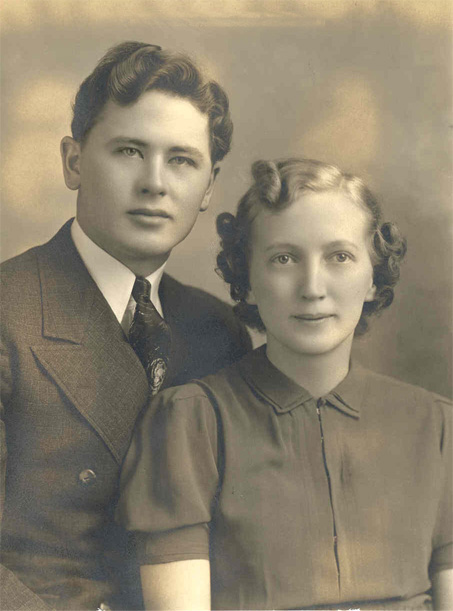
Wilton and Eleanor wedding
December 1, 1938
After Wilton had picked the corn by hand, they went to St. Paul, Minnesota, to get married. They were married December 1, 1938, at the St. Anthony Methodist Parsonage by Pastor Rising. Eleanor planned to join the Lutheran church after they were married so she wanted to be married by a Methodist pastor to please her mother. Harlan Bomsta and Muriel Lentz were their attendants. Eleanor remembers the weather was very nice and the grass was still green. Muriel's mother bought a corsage of sweetheart roses and sweet peas for Eleanor, which she was thankful to get. Eleanor wore a teal blue crepe dress with black accessories. Muriel wore a maroon colored dress and had a corsage of sweetheart roses and chrysanthemums. Russell and Amelia Bomsta watched the wedding through the picture window and threw rice as they left the parsonage. They took them out for lunch afterwards. Harlan and Muriel gave them a set of china dishes, which have all been broken through the years. (The pastor's wife was an invalid on a stretcher. He had her all dressed up for the wedding. She was part of the audience.)
They had very little money, about $21.00 between them, but they were able to take a short trip up north for their honeymoon. Gas was only $.15 a gallon. This was Eleanor's first trip up north, but Wilton had been up there before with his brother, Harlan and cousin, Art Nordin. They stopped at a hotel in Forest Lake the first night. Then they went to visit cousins and Aunt Helen and Uncle Andy at Markville, Minnesota. Aunt Helen was Wilton's mother's sister (a Flann) and Uncle Andy Anderson was a brother to Eleanor's mother. They spent a night with them and then they went to Duluth to see some more cousins.
They returned to the farm to a house already occupied by Henning and two of Wilton's brothers, Emery and Orville. Henning was happy that Wilton was married and that he planned to stay on the farm. Henning told Eleanor that everything in the house was theirs. If she wanted to get rid of anything she would find a home for it and talk to Henning about it. Emery was working and Orville was finishing his last year of school.
After they had been home for a couple of days several neighbors and friends came to chivaree the newlyweds. Helen Linn (Maurice Nelson's sister) and Deloris Nelson had baked several cakes. The custom for a chivaree is that the people who come make a lot of noise while walking around the house. Then the honored couple will invite them in for a treat. Another thing they liked to do was to separate the bride and groom. About four guys tried to kidnap Eleanor, Wilton fought so hard that they gave up. The girls gave up also. Later on a bridal shower was given at church. Practical or handmade items were given as gifts.
Eleanor had managed to save $50.00 and Wilton asked to borrow the money to buy some pigs from Emery. She loaned him the money and after they were married awhile, she bought a kitchen table and chairs and she called them even.
Life was not easy for them. The country was just coming out of the "Depression." They were poor with large debts to pay off. In March they bought out Henning by taking over the note at the bank. Henning had a lot of bad financial luck so Wilton paid on his bills for eight years after they were married.
The house didn't have electricity or in-door plumbing. Their first purchase was a treadle sewing machine in February. They paid $3.00 a month for it. Eleanor often wished she had kept it after she traded it in for her first electric sewing machine.
Their first Christmas was sad for Eleanor. The weather was so bad they didn't dare venture out to Halverson’s in Litchfield. They waited and went later in the week.
When they were first married Henning or Orville usually had the Model A car so Wilton and Eleanor would walk when they wanted to go away. Sometimes another couple would stop and pick them up and they would visit the neighbors. That first winter there was a lot of rain in January to provide good ice on the pasture. Wilton and Eleanor often would go skating. Sometimes they were invited to skating parties on Lake Lillian Lake. These might have been Luther League parties. Eleanor remembers going to Lillie Nordin's house for lunch.
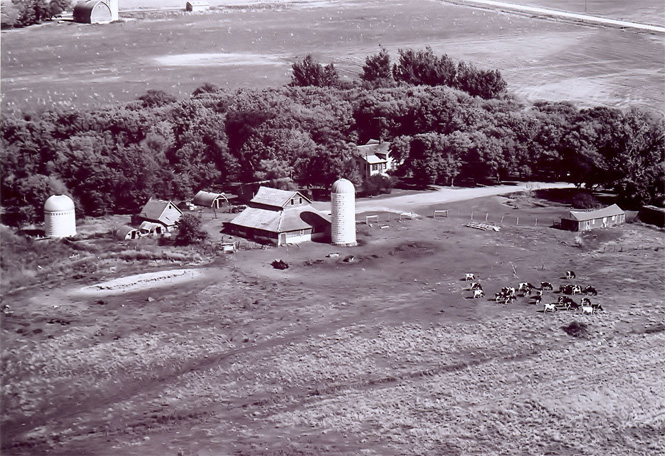
Farm 1960
Can you imagine what it was like without refrigeration? Farmers would butcher their animals at their farm. Most of the meat was canned or they made a salt brine to preserve it. The salt pork was cooked in milk, which help cut down the saltiness. The odor of the cooking pork made Eleanor sick when she was pregnant with LaVonne, so she would start cooking it and then get out of the house while Henning would stay and watch the meat for her. In the summer they would put food in a cream can and put the can down in the well or they could put food in a wooden container and run cold water over it in the water tank. In the winter food was put on the porch. Homemade vanilla ice cream could be made in the winter when plenty of ice was available.
On September 30, 1939, their first child was born. Eleanor liked the name Barbara but Wilton did not. They finally agreed on the name LaVonne Jean. When LaVonne was two years old they went down to Galveston, Texas, to visit Harlan. Wilton drove Harlan's '37 Ford. Harlan was in the Army and was stationed in Texas. Muriel (Harlan's wife) and Deloris (Wilton and Harlan's sister) went along. Dale Nelson stayed with Grandpa Henning while Deloris was gone. Muriel and Deloris rode in the front seat to prevent carsickness. LaVonne and Eleanor had the back seat, which provided a little more room for a toddler. At night they would stop at a farm place and ask to sleep in one of their buildings. Travelers didn't have motels along the way to sleep at. There was a hurricane going on which was a new experience for them. LaVonne celebrated her second birthday at the Lutheran Mission Center at San Antonio, Texas, with Myrtle Nordin (Wilton's cousin) and other missionaries there. They served a dinner and had birthday cake with candles for LaVonne. Wilton and Eleanor bought her a big doll at Galveston.
Delores Halverson Draxton tells about the days she spent at the farm helping her sister. The long days and hard work convinced her that she didn’t want to marry a farmer.
One day, Eleanor was milking a cow by hand near the barn door. She had LaVonne sitting in a wagon near the door. A horse came running towards the barn and stopped just as it came up to the door in front of LaVonne. Eleanor was so frightened that she shook for some time after that. Wilton said the flies had been so bad that day, he figured the horse just wanted to hurry and get in the barn.
When LaVonne was little, Mexicans came to live on the farm to hoe and top sugar beets. She played with the children. One day they took off their clothes and were playing in the chicken water trough. The Mexican children loved to teach LaVonne Spanish words and then they would go to the barn and have her tell them to Wilton. They would laugh and laugh while she recited her Spanish. (Do you suppose these were naughty words?) Eleanor remembers looking over to the chicken coop where the Mexicans lived and saw the women picking out head lice from their hair. Sure enough, LaVonne got head lice, too. Aunt Rose was visiting and she knew what to buy to treat her in order to get rid of the lice. The treatment was successful the first time. They gave the Mexicans milk for a treat. The government became very strict about improving the living quarters with running water, and so forth. Wilton couldn't afford this so that was the end of the Mexicans coming to work at the farm.
In those days it was common to have traveling salesmen stop by to sell a variety of items. There was a Watkins man, a Raleigh man and Art Anderson stopped by to sell shoestrings, spices, pudding and fly-poison.

The fieldwork was done with Belgian, Percheron and Hamilton horses. June, Kate, Jane, Dixie, Tabby, Prince and Barney were the names of some of them. Horses required a lot of work and time to care for them. In 1940 one team was traded for an old F-20 Farmall tractor with steel wheels.
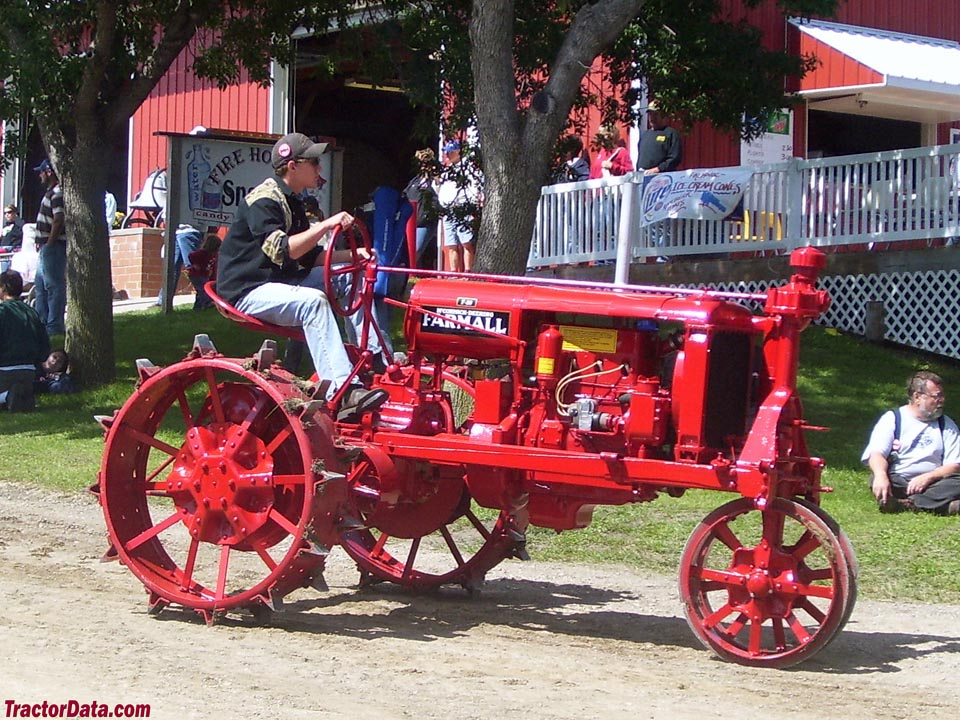
Wilton and Eleanor were lucky to come through the Armistice Day Blizzard of November 11, 1940, without any tragedy. It was hard for Wilton to find his way to the barn. He was going to string a rope between the buildings when the storm let up. After the storm was over Wilton went over to help Maurice Nelson pick up many dead turkeys that didn't survive the storm.
Harlan and Emery served in the Army. They wrote home often. Naturally those left at home worried about them but tried not to think the worst. Three of Eleanor's brothers were in the service. Wes and Vern were in the Navy. Jerry was in the Coast Guard. Allen received a deferment from Northwest Airlines. He was required to go to Alaska to work during the War. Wilton was able to stay home and take care of the farm to produce food for our country and his family. There was a shortage of gasoline and sugar so ration stamps were used. There was rejoicing when the War was over and everyone returned home safely.
On September 11, 1942, a terrible windstorm struck the farm. Eleanor was pregnant with Annette. While she was canning pears in the kitchen she noticed the sky was getting black. She put the pressure canner on the back of the stove. She headed out to pick eggs quick and then she hurried to the barn to pick more eggs, where she thought she better stay until the storm was past. Wilton was out in the cornfield cutting corn and putting it into bundles for the silo. He could see the storm approaching so he came home from the field and went to the house to check on Eleanor and couldn't find her. He kept looking until he found Eleanor in the barn. By now the storm was really bad. They made a hole in the hay and waited the storm out. The cyclone blew so hard the barn went up and down three times and the silo shook and fell down. One calf flew away and was killed. They prayed a lot, mostly the Lord's Prayer. When Henning saw the storm coming he and LaVonne went in the car to get Wilton from the cornfield. The sky was black and it got very dark, they were unable to see that Wilton had come home cross-country so they missed each other. Henning could tell the storm was going to hit hard so he placed LaVonne in a ditch and lay on top of her to protect her from the storm. The car was picked up and put down in a deep rut. (Even though I was only 3 years old I remember this storm event, how dark and wet it was and having my head covered. Grandpa must have had a very calm presence because I did not develop a fear of storms. L.J.H.) When the storm was over, Wilton and Eleanor ran to the house to find both Henning and LaVonne missing. There were some anxious moments until they returned unharmed. Some trees blew down. The neighbors came from all around to see if they needed help to get out in case Eleanor went into labor.
Eleanor went into labor on September 26, 1942. Annette decided she would rather be born in an early snowstorm. They started out for Litchfield but the car kept stalling from the wet snow. They stopped at Ellis Rossell's and he drove them to the hospital. He stayed until Annette Kay was born and brought Wilton home. Ellis always referred to Annette as "His Girl." Annette's name is Eleanor's middle name.
When Annette was two years old she got her first tricycle. She was the "artist" in the family. She would go behind the doors and color on the walls. Eleanor would spank her for coloring and she would go back and do it again. She would come to Eleanor's lap shortly after her spanking and act like it never happened.
Stanley Malcolm was born September 28, 1945. He was named after Stanley Nelson, (a nephew of Maurice Nelson) who had been killed in an accident. When Stan was about six months old and had learned to crawl, Eleanor went outside with Annette to the outhouse. Annette was afraid of the rooster so someone always had to go with her. When Annette was a little girl she had trouble with the roosters chasing her. Every time she went to the outhouse they would wait for her to come out and they would chase her. Stan was left with LaVonne in the sun porch. He followed to the kitchen and fell down the basement steps. His broke his nose in the fall. The doctor fixed his nose so he could breathe easier. After that it was a real struggle to get Stan to return to see the doctor. When Stan was 15 or 16 he had surgery to straighten his nose. He came home from the hospital all black and blue around his eyes. Stan was very upset when he found out that the neighbor's dog had killed his favorite dog. Elaine and Grandpa buried the dog and Elaine put flowers on the grave. This dog had been a very good hunting dog. He liked to chase up pheasants. Stan had another favorite dog, which was given to him by his friend Duane Johnson when his family moved to Oregon. Grandpa Henning was sure the dog "Maggie" would never stay on our place. Evidently the dog was very comfortable with Stan and felt right at home.
Stan liked to sit in the Plymouth when he was three years old and play with every knob, switch and dial there was. When he was seven years old, he was playing flashlight tag with the kids at Roy Vick’s when he fell into a cistern that was about eight feet deep that Roy was digging. He didn’t break any bones in the fall but did have the wind knocked out of him. Stan can still vividly remember being at the bottom of that pit and unable to breathe. They put a ladder down the hole to get him out.
Stanley drove the Farmall B tractor when he was five or six years old. Stan and Annette could not push in the clutch so they put the tractor in first gear and started to it to get going. He drove the big tractor either the MD Farmall or Elder Madsen’s M when he was seven to help out with the hay baling.

Wilton was proud of his driving, thought he did very well for a little guy. The neighbors would drive by and think the tractor was going down the rows by itself because they couldn’t see Stan.
All of the kids loved to hide from Eleanor. In 1941 or '42 a fence was built around the lawn to keep the children in the yard and the pigs out!
LaVonne, Annette and Stanley have their birthdays on September 26, 28 and 30. They were born three years apart. They always had large joint birthday parties when they were young. Games were played. Favorite things to do was play softball or dig in the upstairs closet and play dress up with the clothes, makeup, jewelry, shoes and nail polish that Muriel Lentz Bomsta and Delores Halverson Draxton had sent out to the farm!
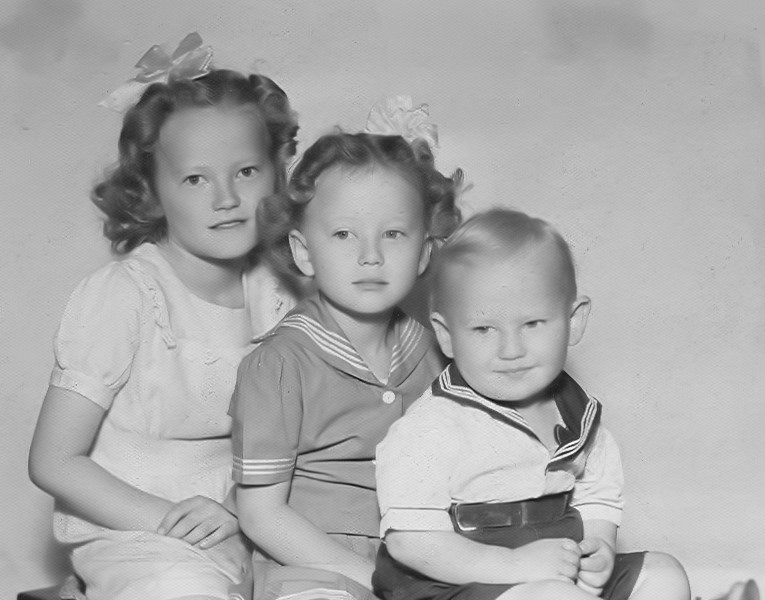
1953 was a bad year for illness. When Eleanor was pregnant with Elaine, she had trouble with anemia and was hospitalized before Elaine was born on May 6 and for 12 days afterward. Eleanor required 4 blood transfusions and Vitamin "K" shots. Wilton liked to wear dress shirts when he went to visit Eleanor at the hospital. Deloris Nelson came over to show LaVonne how to sprinkle them and then how to iron them. Deloris helped take care of the children and to work around the house. Wilton didn't get any planting done until they came home from the hospital.
LaVonne cooked her own Confirmation Dinner for the relatives who came for her special day. Eleanor wanted to name Elaine, Patricia, after a lady she was fond of but Wilton didn't like that name so they compromised and named her Elaine Patricia. Elaine had trouble with SMA formula being too rich for her digestive system so she had to be taken to Minneapolis for some tests to find out what her trouble was. The doctors thought there was something wrong in her brain because she had some convulsions so everyone was very thankful it was something easy to correct.

Later in the summer Stan was stricken with polio. He and mother went by ambulance to Minneapolis. He was hospitalized at Sister Elizabeth Kenney Institute for five weeks. Stan was discharged on August 18. When he came home he still needed therapy every day. The dining room table was set up to work on stretching his stiff and tight muscles. He started school three weeks late. Several trips were made to Sister Kenney Institute for checkups. He had a good recovery and became a very good athlete. Polio was a dreaded disease. Dad was grief stricken when Stan became sick because he had a cousin die from polio and many people were paralyzed because of it. People would avoid crowds in the summer. Eleanor always made sure the kids washed their hands. They were very happy when a vaccine for preventing polio was discovered. (Stan’s get well cards and letters were found in 2005 as we emptied dad’s house. They are a real treasure for him.)
The Rural Electrification Administration (REA) was working hard to provide electricity for farmers to ease their work and make things more convenient. Electricity finally was put in at the farm in 1946. Other rural areas had gotten electric power earlier. The REA required landowners to sign an easement to allow poles and wire to cross their land, but two of Wilton's neighbors, Quade Swenson and Joe Nielson refused to sign.
Finally the younger, more progressive sons of Quade and Joe -- Lester Swenson and Byron Nielson, moved onto those farms and they signed the easement. The power company would set the poles in the ground and then install the wire on them. They would also have to install a transformer at each farm. While the REA men worked on the power lines the farmer had to get an electrician to wire the farm buildings so they could make use of the electricity. A lot of work had to be done by a lot of people before you could turn the lights on in the barn. Eleanor cooked meals for the men who put in the poles every day. Each man would pay her a generous amount for her home cooking.
For Eleanor's birthday Wilton bought her a new Monarch stove, which sat on the porch for six months. The day the electricity was turned on Wilton was gone to Minneapolis. Eleanor was so eager to get her stove hooked up she talked Henning and Hans Petterson, the electrician from Lake Lillian, into moving the old Monarch wood stove down in the basement and to hook up the electric stove. She was anxious to bake bread on the new stove. For years she had fought the battle of feeding the fire properly in order to maintain the right temperature to bake good bread. With a thermostatically controlled oven this would be easy --- she thought. The oven thermostat didn't work right, however, and she burned the first batch of bread. After a repairman from Holm Bros. from Atwater replaced the defective thermostat, it did indeed prove to be much easier than the old way.
Now they were able to get rid of the kerosene lamps, battery operated radio, water pail and dipper, hand pump to get water from the cistern, battery operated Christmas tree lights and the large floor grate in the living room as we slowly modernized the house. We finally got running water and inside toilets in 1951, so the double outhouse on the north side of the fence was removed. We no longer needed the commode in the house to use during the night or during the cold stormy winter weather. We no longer had to heat water on the wood stove to do dishes, wash clothes or take a bath. We took baths in a big copper tub in the middle of the kitchen where it was nice and warm. There was a water reservoir on the side of the stove that kept water hot. Dishes were washed on the stove and rinsed with hot water from the teakettle. The new sewer was a long tile which plugged up periodically and Grandpa Henning or Hans Petterson the plumber would dig holes by hand until they found the problem.
The farm did not get telephone service until 1956. The phone service was shared with several neighbors for the first few years on a party line. Most people changed to private lines after a few years of trying to use the phone with other people listening in on their conversation. Before we got phone service someone had to get in the car and drive to town or over to Maurice Nelson’s to call when there was an emergency and you needed to call the doctor or veterinarian. Nelsons had a wooden oak wall telephone. In those days there would be many phones connected to the same line. This was referred to as a party line. Each farm had its own ring; one person would have one long ring and two short rings, while another would have a short ring followed by two long rings. Everyone on the party line could hear the various ringing. You were only supposed to answer your own ring, but sometimes a person would hear the ring of a particular person that they knew was not at home, so they would answer and tell the caller that so and so was not home. Sometimes the caller was told where they could be contacted. The party line had call forwarding long before Mother Bell came up with the name for it. The party line also provided entertainment. All you needed to do was pick up the phone and listen to whoever was talking at the time. The conversations could be quite interesting. It was fun to "rubber neck" and listen to all the neighbors talking.
Clothes were washed with a gas motor wringer washer with a pipe out the window for a vent. The motor never did work very well and Eleanor had trouble getting it started and keeping it going. Wilton had to come home and help her many times. The clothes were rinsed in two tubs. One tub had Mrs. Stuart's Bluing in the water to keep the white clothes whiter. We carried the wash outside and hung everything on the line to dry. In the winter the wash was hung on a wooden clothes rack, put outside to freeze and then brought in and put over the furnace grate. The clothes smelled very fresh and clean. Grandpa Henning was good to help carry the clothes. Lace curtains were used on many windows. When they were washed they were stretched on a frame to retain their shape while they dried. We had venetian blinds on the living room windows that were awful to keep clean. In the fall the flyspecks were very difficult to get off without cutting up your knuckles.
The first carpeting for the house was put in their bedroom after they had been married 25 years. They added carpet to more rooms whenever they could. (When Annette was doing some remodeling in the house in 2005, they discovered nice wood floors under the linoleum and carpet.)

The house has been painted white and green; pale green with white trim and gold with rust trim. In 1996 it was painted green again. In 2000 it was painted beige with a darker beige trim. Stan built a nice deck and stairs with a low rise to help mother get into the house. In 2004 the house was painted. Now it looks like vanilla ice cream with butterscotch topping. Stan and Bob rebuilt some of the windows to make the house warmer. Many family members have helped with projects over the years.
The house was heated with a big gravity type furnace. Coal and wood were burned to provide heat. There was indeed a lot to the saying, "keep the home fires burning." Coal burned much longer than wood so it was the desired fuel to keep the house warm through the night. Coal was dirtier and made a mess in the basement. The wood had to be cut, split and dried. Hardwood trees made the best firewood. Someone always had to get up early and get the fire going in the furnace and the kitchen stove. They would shake down the ashes into the ash pan. The ashes would then be carried outside in a bucket. LaVonne liked to get up with whoever got up first, Wilton or Henning, and watch them build the fire. They had a Captain's chair (from Adele Bomsta) by the wood stove where they put the little ones. They were tied in with a dishtowel and they sat there and stayed nice and warm until the house had warmed up. On cold mornings they dressed in front of the kitchen stove. Not only did the wood need to be cut, some of the wood had to be split to get a good fire started. It there were hot coals, then larger chunks of wood could be used without splitting. Farmers used a large buzz saw that was powered from a tractor and long belt on a pulley. The early chain saws were heavy and needed frequent repairs.
There was a large floor grate, about 36 inches square, in the living room. Small openings in the ceiling allowed some heat to get upstairs. Heavy quilts were on the beds upstairs because it was always cold up there. The floor grate was a wonderful place to stand and soak up heat when you were chilled to the bone, after coming in from out-doors. You had to be careful not to accidentally drop objects through the holes. Crayons would melt and some things smelled terrible if they got down on the furnace. Life was easier when they installed an oil/wood burning furnace with ductwork and a modern thermostat. The upstairs bedrooms were nice and warm after that. They upgraded the furnace a few times, eventually had a new oil burner and central air conditioning.
Before they got electricity at the farm, kerosene lamps were used to light the house at night. They needed a lot of attention also. The chimneys had to be kept clean, the wicks trimmed so they got even light and to help keep from sooting the chimney. The kerosene was stored outside in a barrel. It was carried into the house in small amounts in a can with a spout, which made filling the lamps easier. The lamps were kept on hand for use when there were power failures.
The "Home Entertainment Center" of the day was the radio. Before the REA served the farm, a large battery powered radio was used. The programming would vary according to the time of day. News and market reports were usually on around meal times when Dad was in the house to listen. Before the days of a dependable radio, Henning would come home with news from town or we “
Mom could listen to the soap operas of the day such as "Helen Trent", "Ma Perkins", or "Our Gal Sunday." Soap manufacturers like Oxydol usually sponsored the programs. The kids would rush home from school to hear "The Lone Ranger", "Sky King", "Jack Armstrong,” The All American Boy", "Roy Rogers", and ".Hopalong Cassidy." After supper the whole family would gather around the radio to listen to "Amos and Andy", "Jack Benny", "George Burns and Gracie Allen", or maybe "Inner Sanctum."
In 1953 the steel cupboards were installed in the kitchen. Art Johnson put in a new window over the sink. One wall unit wasn't installed properly so it fell down and had to be replaced. Eleanor was thankful Elaine wasn't playing on the kitchen floor that day. The kids and cousins loved playing with all those big boxes that contained the cupboards.
Changes were constantly being made outside, too. In 1942 Wilton was able to buy a new Farmall H tractor from Holm Brothers. Eventually around 1951, all of the horses were sold. Two of the best tasks horses were used for were hauling manure and hay. Wilton had a helper named Ben Hauser. They hauled large loads of loose hay on a sleigh hay rack. One of the last times the horses were used for hauling hay, they spooked, turned quickly and Stan fell from the top and landed on the ground pinned by the over turned hay rack which was cause for some anxious moments. Wilton didn't miss the horses because they were a lot work for him. When the last ones were loaded up to be sold the kids were sad. Tractors don't need to be fed but cost as much to maintain. The machinery was gradually replaced with bigger equipment so more ground could be covered in one day.

In the days of threshing grain, Henning and Wilton worked together with August Carlson, Elder Madsen and Maurice Nelson. August and Henning bought a threshing machine together. When the grain was ripe they would go through the field with the binder, which put the grain into bundles, the bundles were made into shocks and they were put through the threshing machine, which separated the grain from the straw.
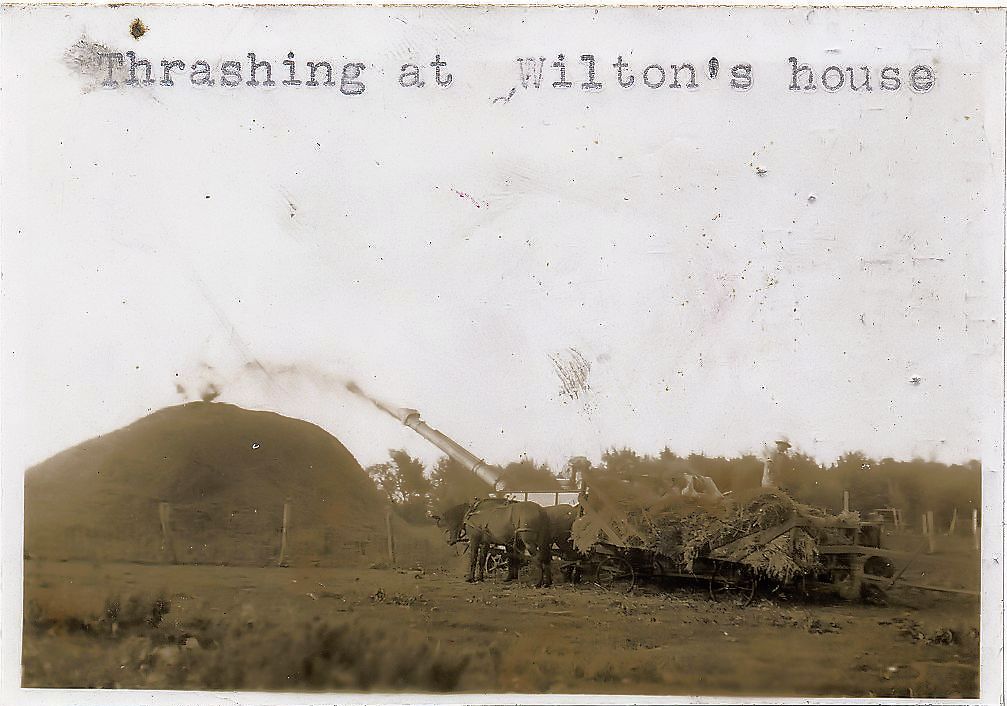
This process required many men for all the hand labor. They usually had eight men and ten kids working. Eleanor would be expected to cook a big delicious meal for all these hungry men. When the threshing was complete they would celebrate by having cake, ice cream, nectar and coffee.
Farmers had a neat way of relaxing after a big noon meal. They find a cool shady spot under a large tree and take a short nap. You could also find farmers squatting down in a shady spot by their tractor or machinery having a heart to heart talk.
Several farmers joined together to form a Tug-O-War team from Lake Elizabeth Township. Wilton remembers Elder Madsen, Arnold Anderson, Allen Junkermeier and one of the Swenson brothers who lived on the Hwy #2 curve were on his team. The Lake Elizabeth team did very well, and won a few championships at the Kandiyohi County Fair.
The weather greatly affects farming. There have been "wet" years and "dry" years. Some beautiful crops have been destroyed by hail and wind. There have been many blizzards that kept them snowed in for days. The snowdrifts have been fifteen feet high, as high as the chicken house.

Photo is of Wilton checking his corn field on Father’s Day, 1987
Many different crops have been grown at the farm; sugar beets, barley, flax, oats, wheat, corn, soybeans, alfalfa, Green Giant peas and sweet corn.

Wheat
The most prosperous years were during the Truman Administration when there was 90% parity, a plan for farm income to keep up with farm costs. They were paid at the established market price of the day. Before Wilton had a corn picker he could pick 100 bushels of corn, by hand, in a day. Often farmers sold some of their grain to the elevator in town. In the early days, Wilton used his corn for feed, so none was sold on the market. In later years he produced more corn than could be fed to the livestock and he had corn to sell. In 1938-39 corn sold for $.40-$.60 per bushel and at other times over the years it was $3.00 or more a bushel. The best price Wilton got for soybeans before 1985 was $8.00 a bushel in 1974 and ‘75. Grain is planted in April or May. Years ago corn was planted when the plum and apple trees were blooming. Now corn can be planted in early May. The soybeans are the last crop to be planted. Wilton would rotate the crops from year to year. He would have alfalfa, then the next year corn. After that oats would be planted with alfalfa seed so that the following year a stand of alfalfa would be growing. Soybeans were planted in plowed ground or after alfalfa.
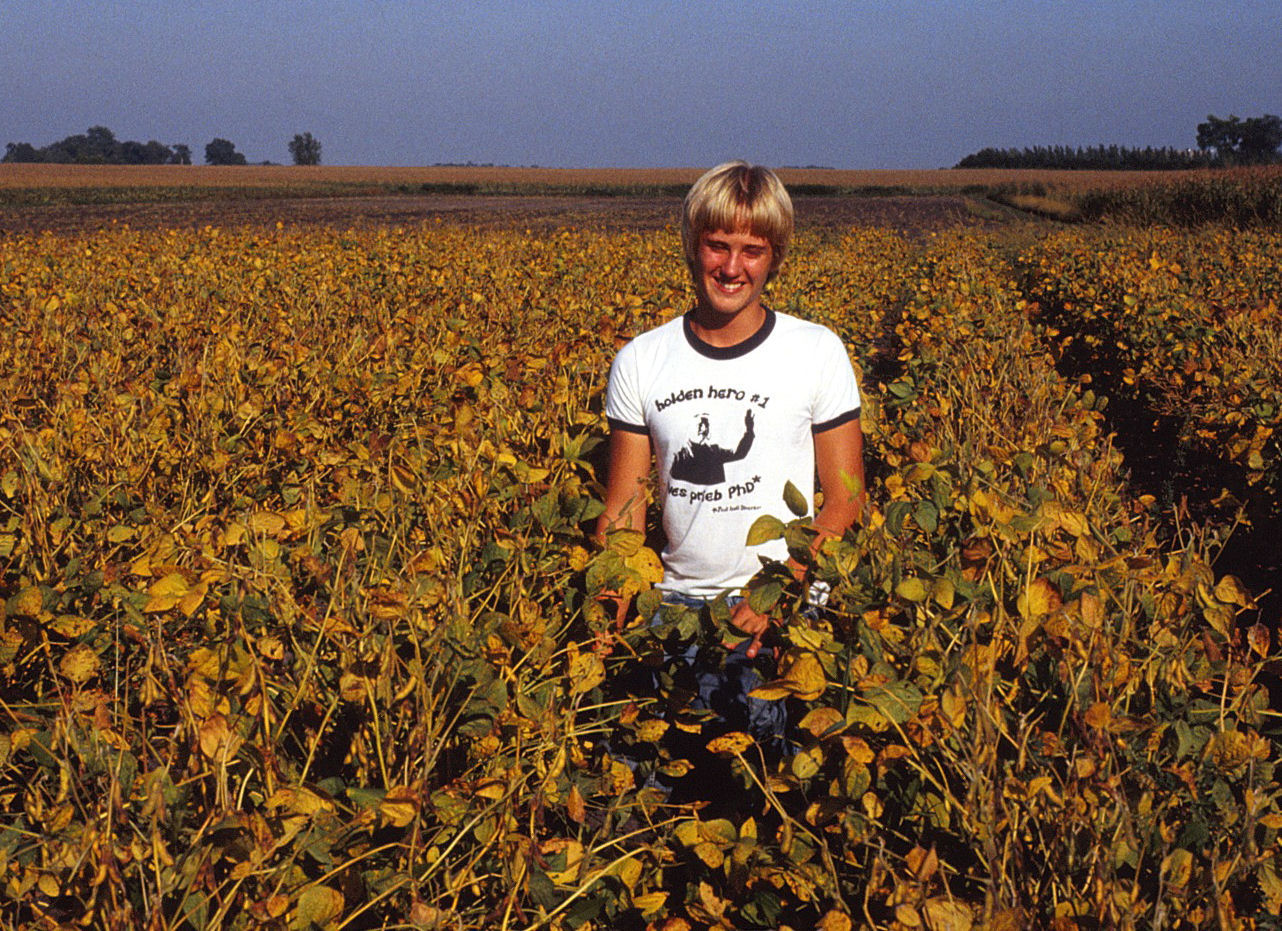
1981 Ross standing in his field of soy beans
The silo was filled with silage in September and when that was done we would take a little trip to Hinckley or Minneapolis. A few times we took a really big trip to Duluth to stay with Earl & Margie Carlson. We could watch the big iron ore ships on Lake Superior from their living room window.
Wilton & Eleanor’s farm was 185 acres consisting of land bought from Aspaas, Quist, Susen, Max Bomsta, Mary Skinner, and the Finnegan lot. The farm had heavy black loam soil with a ditch running along the south border of the farm. In wet years the ditch had backed up and flooded crops.
This State Ditch, known as the Lake Lillian or Crow River Ditch, followed the course of the South fork of the Crow River from Big Kandiyohi Lake to the Meeker County line. The ditch was completed during the fall of 1895 and was rebuilt in 1966. Gigantic cottonwood trees had to be toppled and buried prior to digging the deep new ditch. Skilled Kandiyohi County workers used big bulldozers for this purpose. During the 50's Wilton rented the "Nelson" land, forty acres from the Bank of Willmar, and he also rented land from Adolph Heinz. This land was across the ditch so he had to cross a bridge to get to it. Grandpa Henning told the kids to always hold their breath while crossing the creaky old bridge. This bridge was repaired in the early '50s. Wilton had a total of over 300 acres to farm, including the rented land.
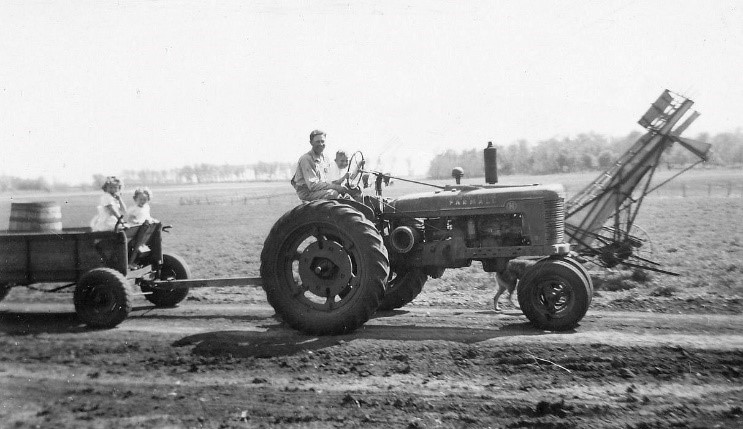
Boys that were hired men over the years were Delphin Linn, Dale Nelson, Dean Summerlet, Larry Hanson, Jodi Johnson, Mark King, and Donald Oslund. The grandsons came out to the farm to do a variety of jobs; for example picking rocks, pulling mustard, cleaning the chicken house and baling hay. Later on grandkids were hired to help Eleanor with her work.

Putting up hay was a job that required extra hands. This usually was done about three times a summer, weather permitting. In the early days hay was cut close to the ground with a sickle mower that was pulled by horses. A horse drawn rake then raked the hay into rows. It was then gathered and put onto a hayrack and hauled to the barn where it was put into the haymow. To make this operation a little easier they would use slings made of rope, which were placed on the rack before the hay was loaded onto it.
At the barn a pulley system at the peak of the barn would be used to lift a sling full of hay from the rack and into the barn. There was a trip rope on the mechanism that attached to the slings so the hay could be dumped at a particular spot in the barn. When the barn was full the hay was piled into stacks. In the winter, often on bitterly cold days, the hay had to be hauled from these stacks in the field to the farm place so it could be fed to the cattle and horses. It usually was packed very tightly and it took a lot of work to chop the hay loose and load it onto the hayrack. Then it would have to be unloaded and fed to the animals. Nowadays we would call this a labor-intensive task. In 1953 a New Holland hay baler was purchased. Hay slings were switched to the bale hook system. One thing remains the same. The weather is always extremely hot and humid when the hay is ready to put up!
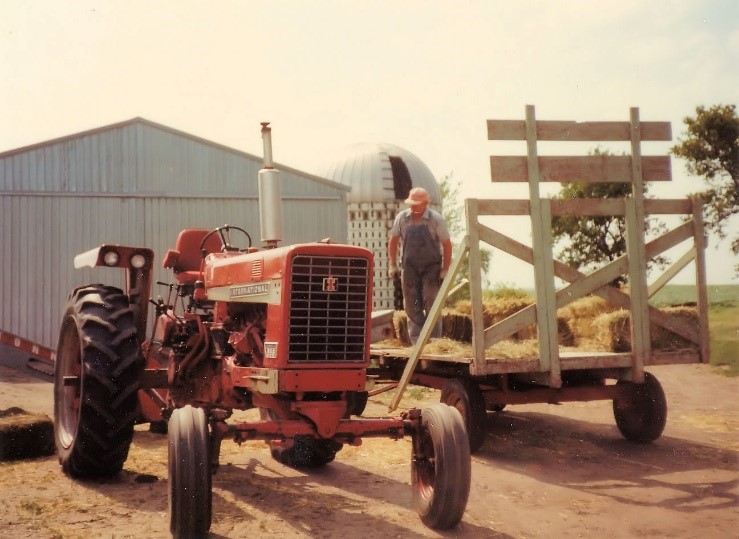
Wilton on Hayrack – Farmall 656

The elevator was another way to put bales of hay in the barn
The favorite tractor of everyone was the little Farmall B. Wilton bought it from Harry Nordin when it was five years old. The "B" was used for a lot of chores around the farm, such as pulling a large barrel containing slop for the pigs, pulling up the hay slings, and hauling manure in the manure spreader. It was also used out in the field for cutting and raking hay, planting and cultivating corn, dragging, and pulling wagons.

Stan Bomsta and Mike Hookom on the B
All the kids learned how to drive a tractor on it because it was so easy to drive. Wilton wishes he still had it so the younger grandchildren would have had a chance to learn to drive a tractor.
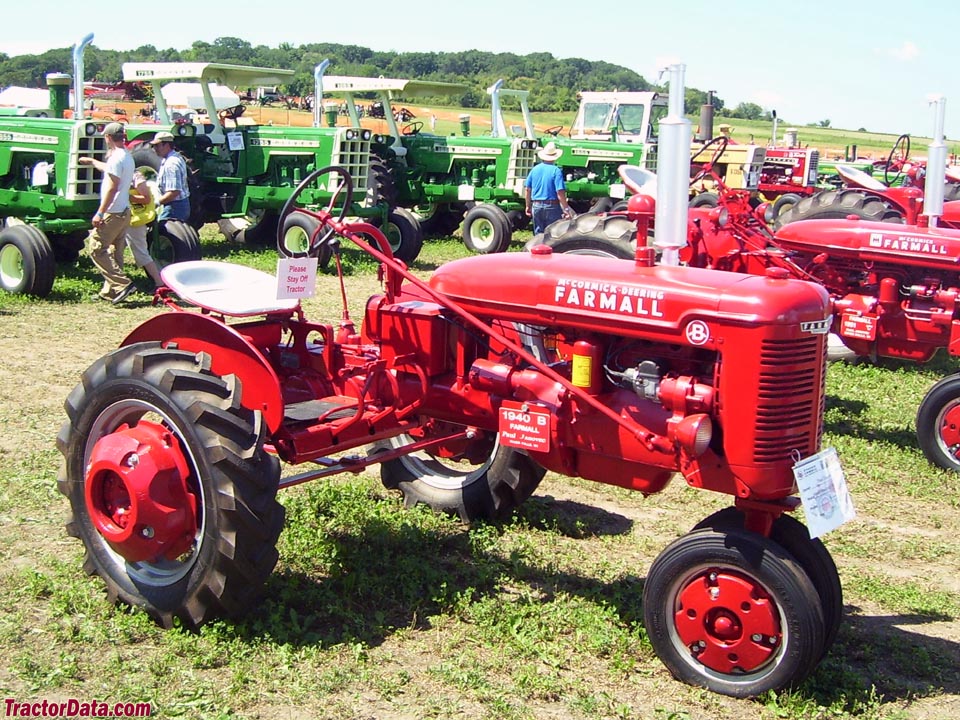
Wilton had several models of tractors. He had a Farmall M purchased from Harry Nordin, then Super M diesel followed by a Super MTA / Farmall 350 / International 656. Wilton enjoyed buying new tractors and was one of the first farmers to get a new Farmall MD, which was a diesel. It had great lugging power compared to the regular Farmall M tractors. The next new tractor he bought had a torque converter so you could maintain the same RPMs but slow quickly to make turns in the field. It also provided ten gear ratios rather than the standard five gears for the old M Farmalls. Most tractors in this era did not have power steering, so you had to get them moving to steer very well and the rough fields could be felt in your hands. Wilton bought an International 660 tractor in 1975. It needed a paint job so he took it into Holm Brothers and had it painted red, white and blue to celebrate America's "Bicentennial" in 1976.
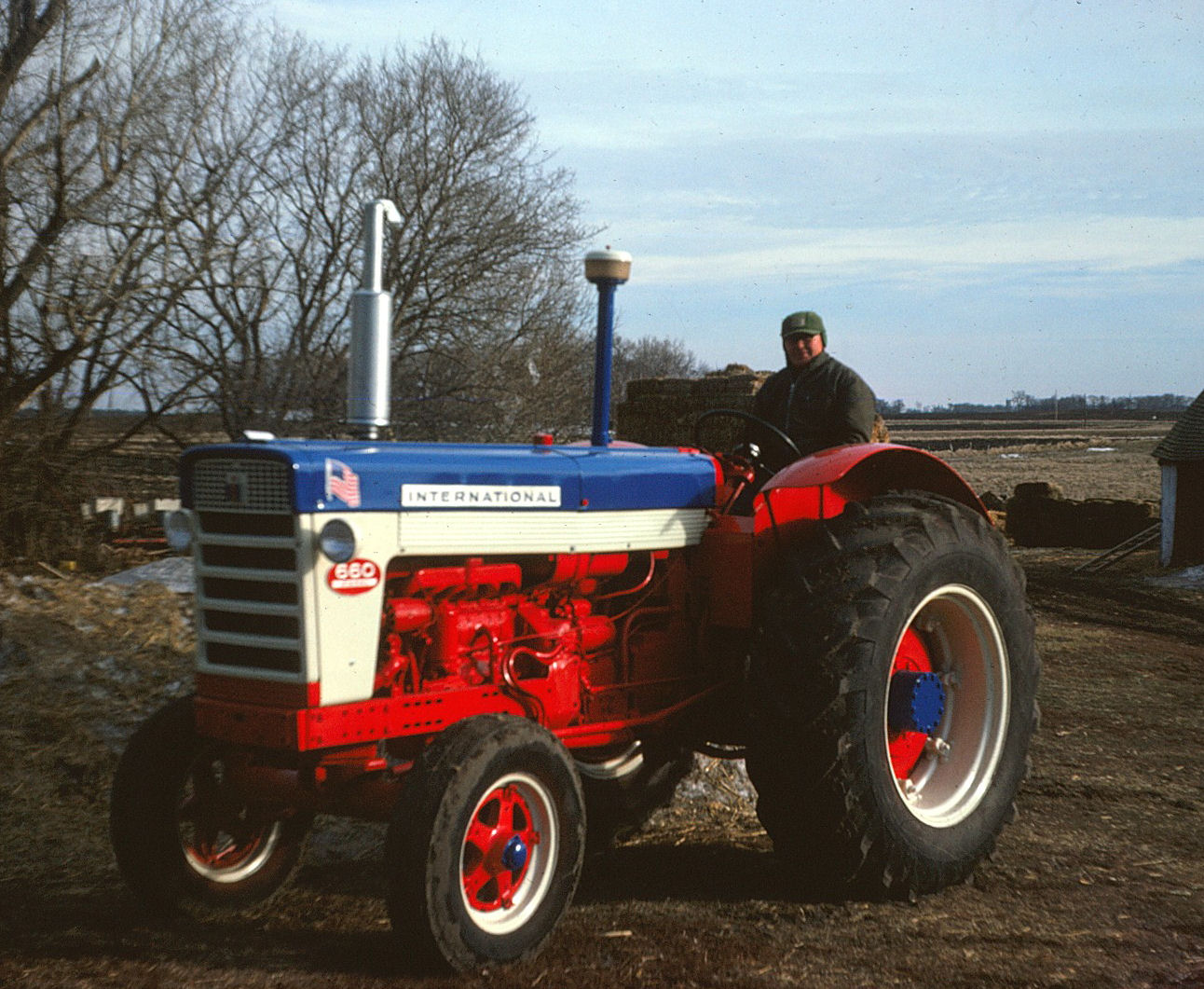
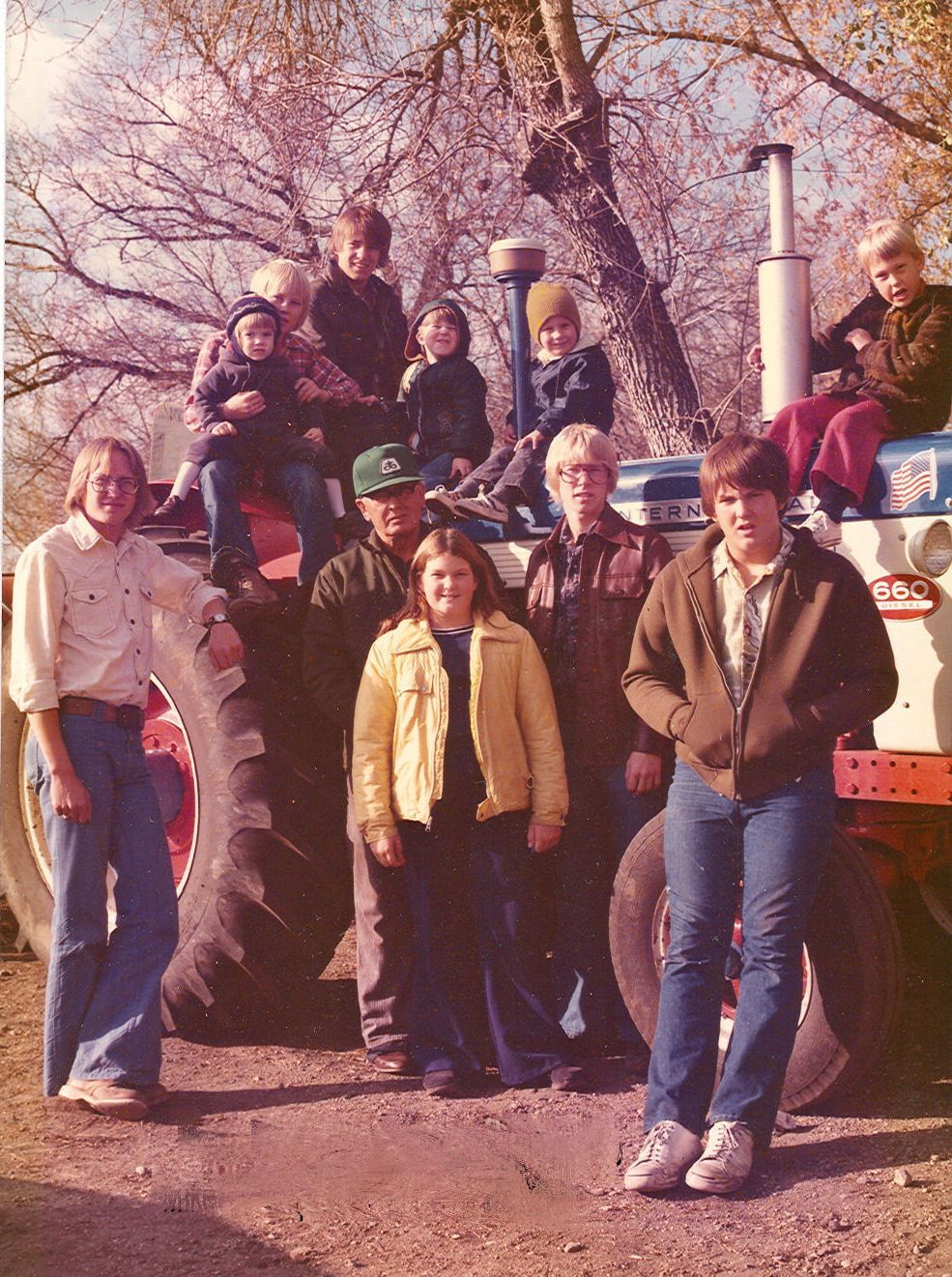
Special tractor, Grandpa and grand kids
He was charged $43.00 for the paint and $60.00 for labor. They painted it more for fun than to make a profit. The motor went out in 1981 so he got rid of that colorful tractor. Since the 656 was Dad’s pride and joy, the old 660 was followed by an 806 and Farmall M tractors used for variety of work. Wilton only owned one John Deere and that was for picking corn, which caught on fire and burned. He had an International combine which was terrible and always breaking down, so he went back to a threshing machine in 1956. He had several Allis Chalmers combines, then a John Deere pull type and finally the John Deere self-propelled combine.
Farmers were always negotiating for the best price on repair parts or other farm supplies as well as for services such as the veterinarian or a blacksmith. The farmer generally had his own list of favorite employees or managers who they thought gave them the best deals. Wilton always liked to joke and tease with the salesmen and mechanics.
One time he told the guys at Holm Bros. that he found a cure for his painful arthritis. He showed them a raw potato he carried in his pocket and it was supposed to draw out the arthritis from his body. A short time later he went back with a rock in his pocket. The rock was the same size and shape as the potato he had shown them. One guy believed the story about the potato turning hard because it was filled with Wilton's arthritis. Wilton claimed he had no pain or stiffness anymore!
Wilton's trucks have been several Model B Fords; pickups included a GMC, a Studebaker, a Chevy, and three Fords. The cars owned have included a Model A Ford, a funny looking Chevy, a maroon 4 door 1948 Plymouth that they bought new. In March of 1957 they bought a black and white 1954 Mercury that had a V8 engine with a three speed standard transmission and overdrive. In recent years they have had several different Ford and Mercury cars.
Animals have been an important part in their life. When they were first married they had 18-40 head of heifers and bull calves. The bull calves were sold on the market when they were fifteen months old. Eleanor helped milk cows by hand. She was excused from fieldwork because they only had one tractor. Wilton always told her to leave the housework because the outside chores were more important.
In the days when the cows were milked by hand you would learn on a cow that was easy to milk. You always milk from the same side. If a cow was considered hard to milk they put a calf to nurse on her or they sold her. They had a lot of help with the milking every morning and evening. Before they had electricity the milk was cooled in a water tank. It was a thrilling day when Wilton first used his DeLaval milking machine. The cows kicked a lot until they got used to the machine. The milking machine didn't save a lot of time because the cows still had to be stripped (a short milking by hand) and all the equipment was tedious to wash.
A separator was used to divide the cream from the milk. It was Eleanor's job to run the separator. All the cranking was a good way to keep the waistline trim. She had to crank it up to a good speed before pouring in the milk. She could tell by the sound it made when it was ready. Then she would begin to pour it through a large metal funnel that had a filter in the bottom that filtered the raw milk. The filter was a gauze-like pad about 5" in diameter. Then the milk was poured into the separator, which had a tank or bowl at the top that held about a pail of milk. The milk went through the spinning discs of the machine which separated the cream from the milk with the milk coming out of a spout that had a large milk can beneath it. The cream came out of a smaller spout and was put in small cream cans.
The skim milk was used to feed the calves. Some of the milk was mixed with oats or barley and water to make slop for the pigs. The pigs liked this mixture so well they would come running and push down whoever was feeding them. They were crazy for this slop. The cats loved to lick the milk soaked filters, which were tossed to them during clean up.
The cleanup was indeed an operation. All of the parts of the separator that came in contact with the milk were disassembled, thoroughly washed and then put back together again. The filter and the milk pails and cans were all scrubbed and rinsed. It took a lot of time to keep things spic and span. The milking machine speeded up the actual milking but also took a lot of hard work to keep clean. Farmers took great pride in having their yard light on in the morning before the neighbors. A typical day for a dairy farmer is to get up at 4:30 or 5:30 AM to milk the cows. This takes about one hour or so. The cream cans have to be carried to the water tank for cooling after each milking. After morning milking was done Wilton would haul the milk to the creamery in Lake Lillian.
The creamery had a truck that would pick up the milk at the farm place, but Wilton would get disgusted with the high cost charged for hauling and also got more disgusted when the truck driver made ruts all across the yard when it was muddy. When the combination of chores and fieldwork became too much, he was forced to relent and use the milk hauler again.
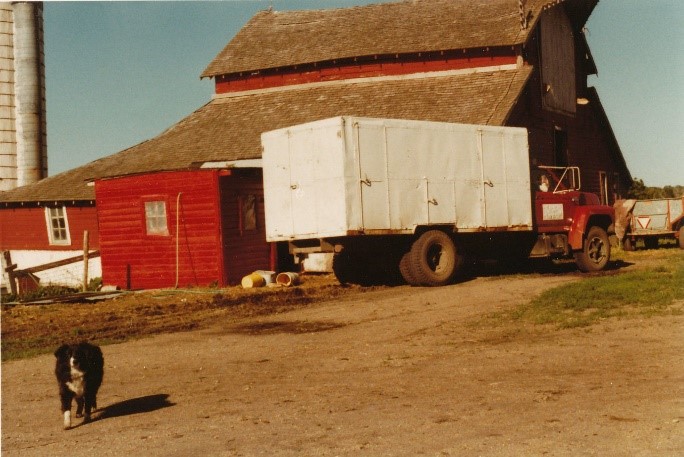
After the milking was done he fed the cows, corn silage and ground feed. After breakfast at 7 AM he would feed hay, make sure there is water to drink and clean the barn by hand. All of the other animals get fed and watered also. Then he hurried out to do some fieldwork. Farmers like forenoon lunch at 9:15 AM and a big dinner at noon and afternoon lunch at 3 PM. He stops his fieldwork at 5 PM to milk the cows and feed all the cattle again. After eating another large meal for supper at seven, he usually goes back in the field to work. Ice cream was enjoyed before bed time at 9 PM.
We wanted to expand the story at this point to explain the work schedule more thoroughly. We needed to add more information on how a farmer’s wife spent her day. Her life revolved around all aspects of the farm. Wilton and Eleanor worked as a team with the farm duties. From day one of their marriage, Eleanor worked outside as well as taking care of the children, housekeeping, meals, and laundry. Wilton was her care giver when her health declined. Elaine shares her memories. Stan has written a piece on the farm life according to the seasons.
As I was thinking of them, this is what came to mind. As a child I knew what day if the week it was by the routine. Mom always made a hot breakfast. Pancakes on Monday; she washed clothes on Monday; she would use Sundays leftovers for coffee as she was too busy washing clothes. Tuesday was oatmeal; she ironed on Tuesday, letting me do handkerchiefs and pillow cases. I still love to iron. On Wednesday mom made eggs and toast. She had to bake for coffee by now. She usually had Ladies Aid or circle so she had to curl her hair and bathe. Thursday was cream of wheat; she would have saved potato water for baking bread. She would make loaves of bread and buns... Yum! She would let us put butter and jam on them warm....I would drive lunch out to Daddy. Grandpa Henning taught me how. At age 6, I was driving cars and the B. On Friday Mother made French toast using up old bread since she now had fresh. She also mowed and did yard work. Then start to get ready for Sundays company. Saturday she made eggs again. We would have poached, boiled or fried. She always rotated. Saturday we cleaned everything!! Sometimes it seemed like all she did was cook, do dishes, cook again, more dishes, do chores then cook and do dishes. We also seemed to always have coffee guests. They would want to stay and visit. Mother would peel potatoes, stir up cookies or bars for the next coffee break while she visited with them. I know I was never bored. I still am never bored. We were taught to find something to do. We learned that if we were bored a not too pleasant job would be assigned. I remember dad came in to the house to complain how Brian was mowing. Mother defended Brian with "it doesn't matter how he does it, it matters he gets the job done." That stuck with me she allowed us to choose our jobs and to do it our way. I liked helping her. Now Dad was different. I realized later his chores for us were time sensitive and was a domino effect. Yet as a kid he just seemed crabby. I remember working in the field for him and he was yelling at me for not doing something right. I got off the tractor, walked home and told mother that if dad wanted my help he had to treat his help nicer. I'm still stubborn, talk nice I'll help, be crabby you are on your own. Dad liked routine, Mother spoiled him. Later he paid her back with his devoted care of her.
I remember our schedule changing with the seasons and school or the school bus. Life seemed to move at a slower pace when we were attending District #43. We all had breakfast together before going to school. A combination of eggs, bread, and cereal were common. I think we added pancakes more often when the mixes made that faster to put together. The school bus had an impact on our schedule and breakfast always seemed to be in a hurry, probably because Dad and Mom let us sleep longer.
During the winter months the dairy farm controlled many things. Dad was always up early. There was even some competition in the early days with neighbors to see who had their yard lights on first. Some days we helped with silage and feeding the cows or calves before breakfast and then headed off to school. I was always thankful we used corn silage because the hay silage families stunk up the whole school.
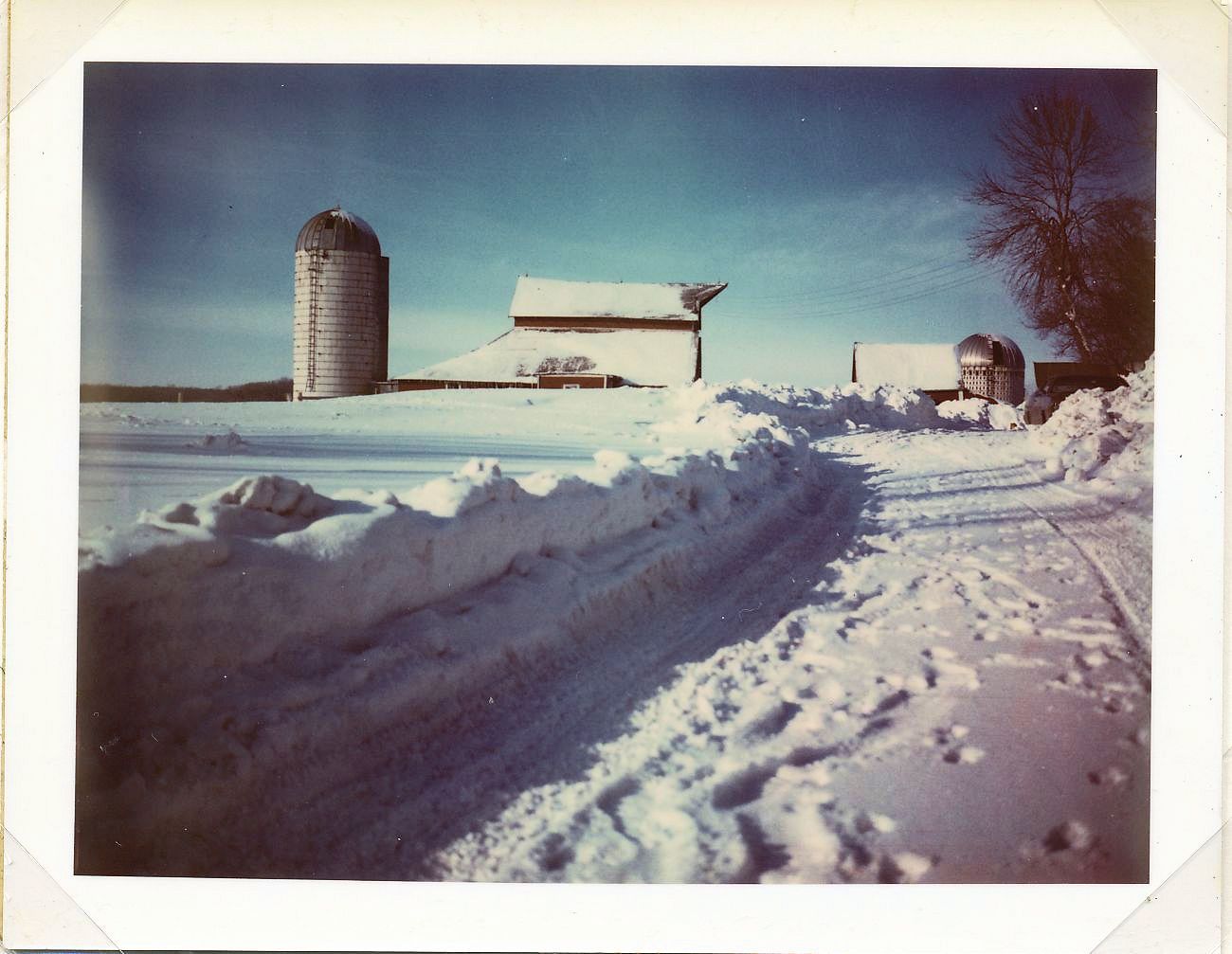
A scene of the farm in winter
Spring brought on a more complicated work schedule. The dairy cows and other animals still needed tending to in addition to all the field work. Dad needed more help with the chores or he did the milking and had us finish up some form of field work like plowing, disking, or dragging the fields. Mom not only made certain that breakfast, noon dinner, and supper was on time, she also brought lunch out to the field at 9:00 and 3:00. Before Tupperware and Thermos bottles, the lunch was wrapped in wax paper, then wrapped in a dish towel and placed in an enameled dish pan. Coffee was poured into a Mason jar. Both Mom and Dad believed in taking brief breaks from work. They thought it helped keep you more alert and safe around machinery. Mom managed to keep up with the food and baking plus get her big garden planted every year.

Stan standing in the field of wheat
Summer meant the cows were out in the pasture and many of them were no longer producing milk. This saved a great deal of work, but summer was also the time for putting up hay and cultivating corn. Dad had no tolerance for weeds in his corn or soy bean fields. The baler was owned with Elder Madsen, so we baled hay for his farm, ours, Dale’s and some other neighbors. Finally, as it was getting dark around 9:00 PM we would head to Big Kandiyohi Lake for cool swim. LaVonne worked at one of the resorts, so we often went there for pop or ice cream. Summer seemed to end after the county and state fairs. Dad would resist going to the cities for the fair, but Mom always seemed to win the debate and we would all go right after Dad finished the morning milking. Rainy days brought another form of work relief. We would go to town for parts or other shopping, and then Dad would read a little after dinner and take a nap. But other times we would do some fencing in the drizzle.
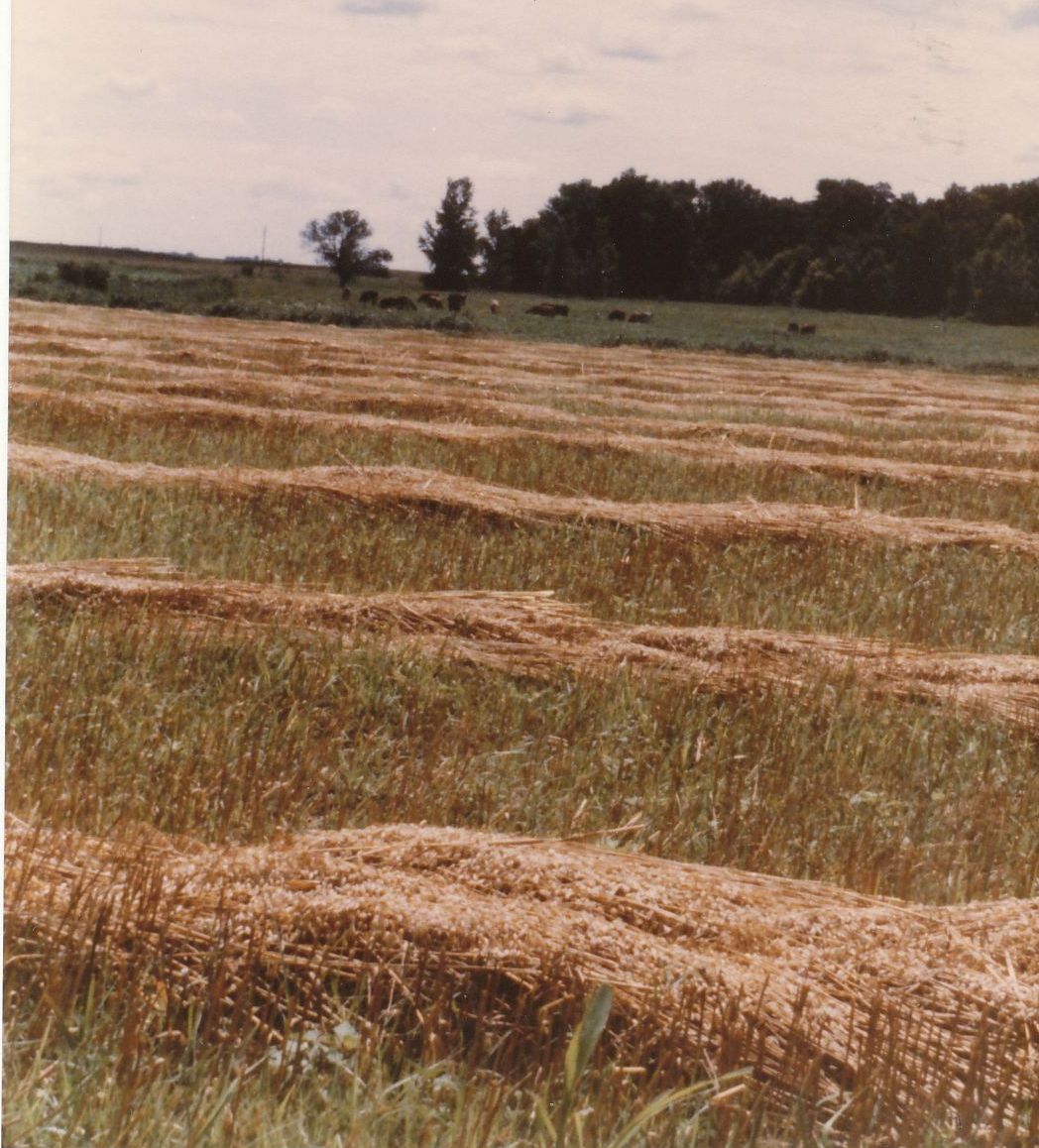
Swathed winrows of grain, dried and waiting for the combine
Fall included the silo filling run to numerous farms. This meant Mom and the kids doing the chores at night. One evening when Stan was out getting the cows from the pasture, the bull decided to charge rather than do his usual pawing and snorting. Unfortunately, Mom was watching the whole event and nearly had a heart attack. Stan managed to out run the bull and leap over a barbed wire fence to safety.

Silo filling with John Deere Tractor/wagon and older JD with Farmhand loader behind
Grandpa Henning is standing with his suit on.
Must have been a special picture!
Everything went well unless it was a wet year. Then the harvesting would be slow or delayed. Mom would have to do her best to keep Dad encouraged during these frustrating years.
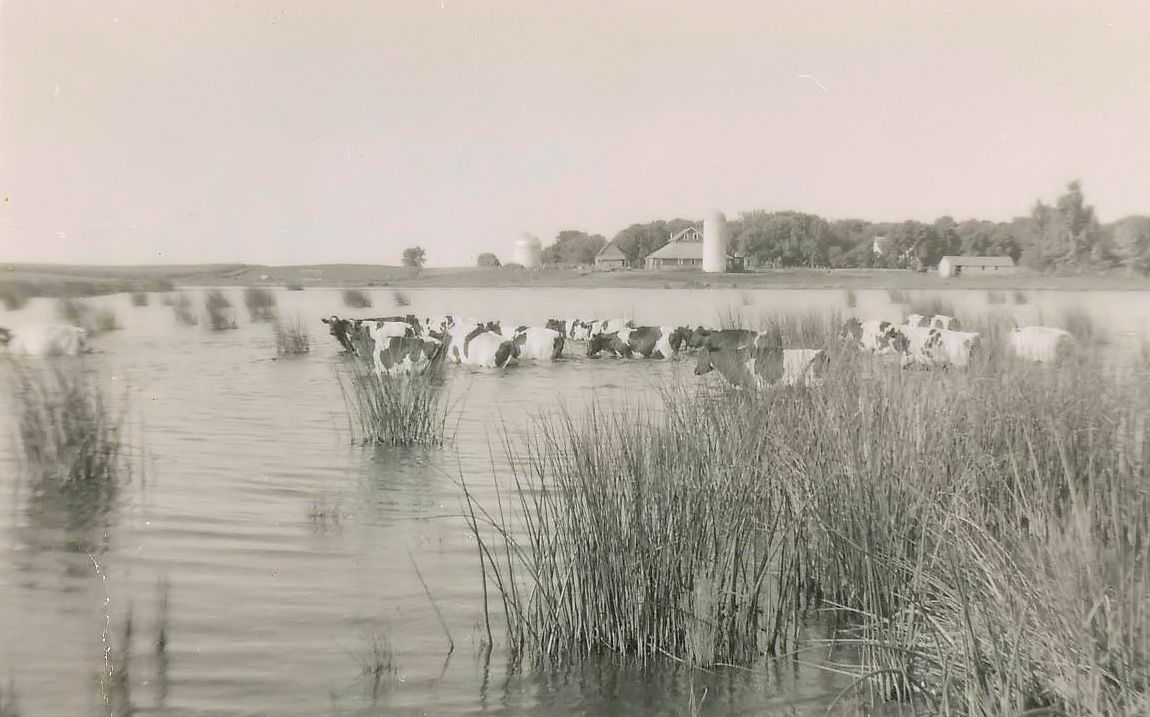
She always had a rationale to keep going and remember when things turned out alright in the past when times were tough. She also had a motto of just get something done or do a little at a time and eventually you get the more difficult tasks completed. By late fall the cows were having their calves and the corn was being picked. Our cousin Dale Nelson farmed with Dad for many years and usually helped with harvest, then Dad would harvest their crops on the Nelson farm.
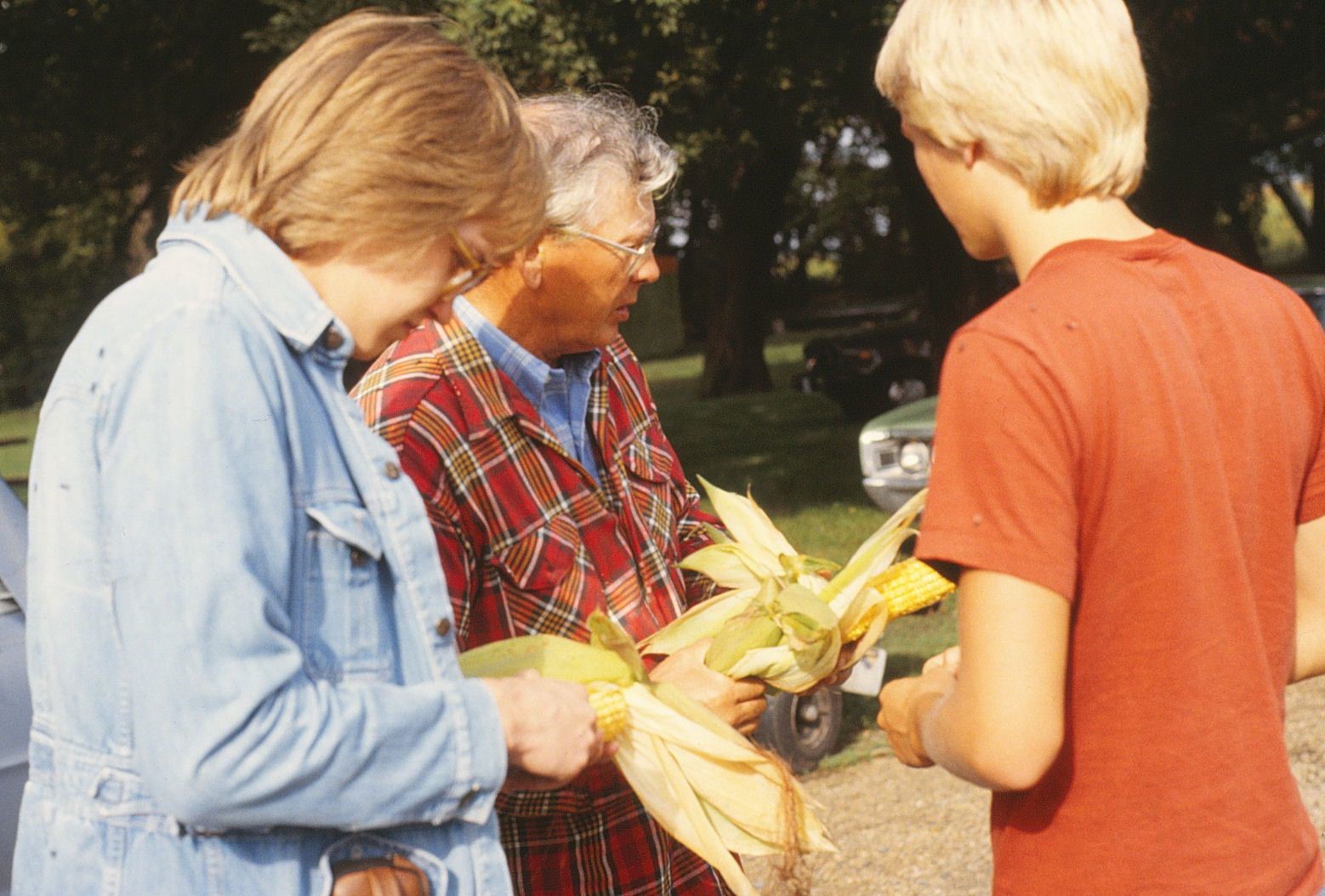
Fall was family time with so many birthday parties and then all the hunters would come out to hunt pheasants. Mom’s hospitality was amazing as she created meals for large groups and always enjoyed the company. Dad and Mom felt very strongly about not working on Sundays, so they only spent four hours doing chores plus all Mom’s cooking. We always had meals together until high school schedules interfered and some family members had to eat on the run. Stan was notorious for eating big snacks after school and then eating a full supper a few hours later.
Regardless of the season our Mother was always patient and found time to listen. Dad was more task oriented and had a list of things to get done each day. Both were observant, so it was difficult to get away with anything. Dad could detect unusual tire tracks from a long distance and would wonder out loud how that happened. He also had fun observing how fast LaVonne or Annette’s boy friends were driving. He could estimate their speed by the size of the cloud of dust coming down the gravel roads. Bob Hookom took the prize by pushing up to 80 miles per hour (Stan exaggerates) on the small township road by Lake Lillian Lake, which we could see from our barn while doing chores. Lynn Schmiedeker had the advantage of coming south on county road 4, which was protected by the trees, but could be observed from the field. As long as they drove slowly down the driveway, nothing was ever said about their driving.
Regardless of how much work needed to be done, our family always attended church on Sunday and sometimes Sunday evening special events. Mom and Dad had a legitimate interest in worship and as farmers were always aware of God’s hand in their daily lives. Their faith in God will have a lasting legacy for many generations.
Wilton is proud to show the path he has worn in the ground making all those trips to the barn. He wondered where all the dirt went. Eleanor thinks she has swept it up from the kitchen floor! Most of the yard was black dirt because the chickens, animals, and all the chores traffic kept the grass at a minimum. Mowing the grass with a push mower was hard work and was also time consuming. It has been interesting to see how the lawn has grown in size since the advent of power mowers. Now they have a riding mower and the grandkids enjoy riding around the yard while mowing.
Wilton played a radio in the barn while he was doing the milking. His favorite "Milking Music" was on WCCO with Maynard Speece and Roger Erickson. His favorite newscasters were Cedric Adams and Jurgen Nash. His radio was getting worn out so for his birthday the kids gave him a new one. It was far too nice for the barn, so he used it in the house for a long time before he could justify taking it to the barn.
The manure from the barn was hauled out in a wheelbarrow to the manure pile. Wilton and anyone who dared to try had to balance precariously on a plank while pushing the wheel barrow in order to get the pile higher or to dump the manure directly in the spreader. After the manure had rotted it was put into the manure spreader and then it was spread onto the fields as fertilizer in the spring. In the early years, the neighbors shared a tractor-mounted loader. Working together they would clean up a farmyard in a day or two. Another time the kids gave him a new wheelbarrow to replace his much worn out wheelbarrow. He thought it was far too nice for manure. Eleanor got to use it for yard work.

Spreader pulled by Farmall tractor with loader
and canvas "Heat Houser" (to direct engine heat to operator)
The largest amount of cattle they had at one time was 60-100 head. They milked Holstein cows. When Eleanor quit working as a nurse's aide at the Cosmos Nursing Home after six years, Wilton thought she should have some beef cattle for her own income. Later she bought a few Guernsey cows. They were called "Grandma's Cows", and were the favorite because of their pretty color and because their rich milk would bring the butter fat test up. When they sold the milk they could get a better price. Creamery customers were given a number to identify them. This number was on small tags that were placed in a holder on the cover of each milk can. Wilton's number was 65 and Stan's 4-H cattle were listed as number 62. We had a locker in the freezer room at the creamery for meat and usually came home with some ice cream.
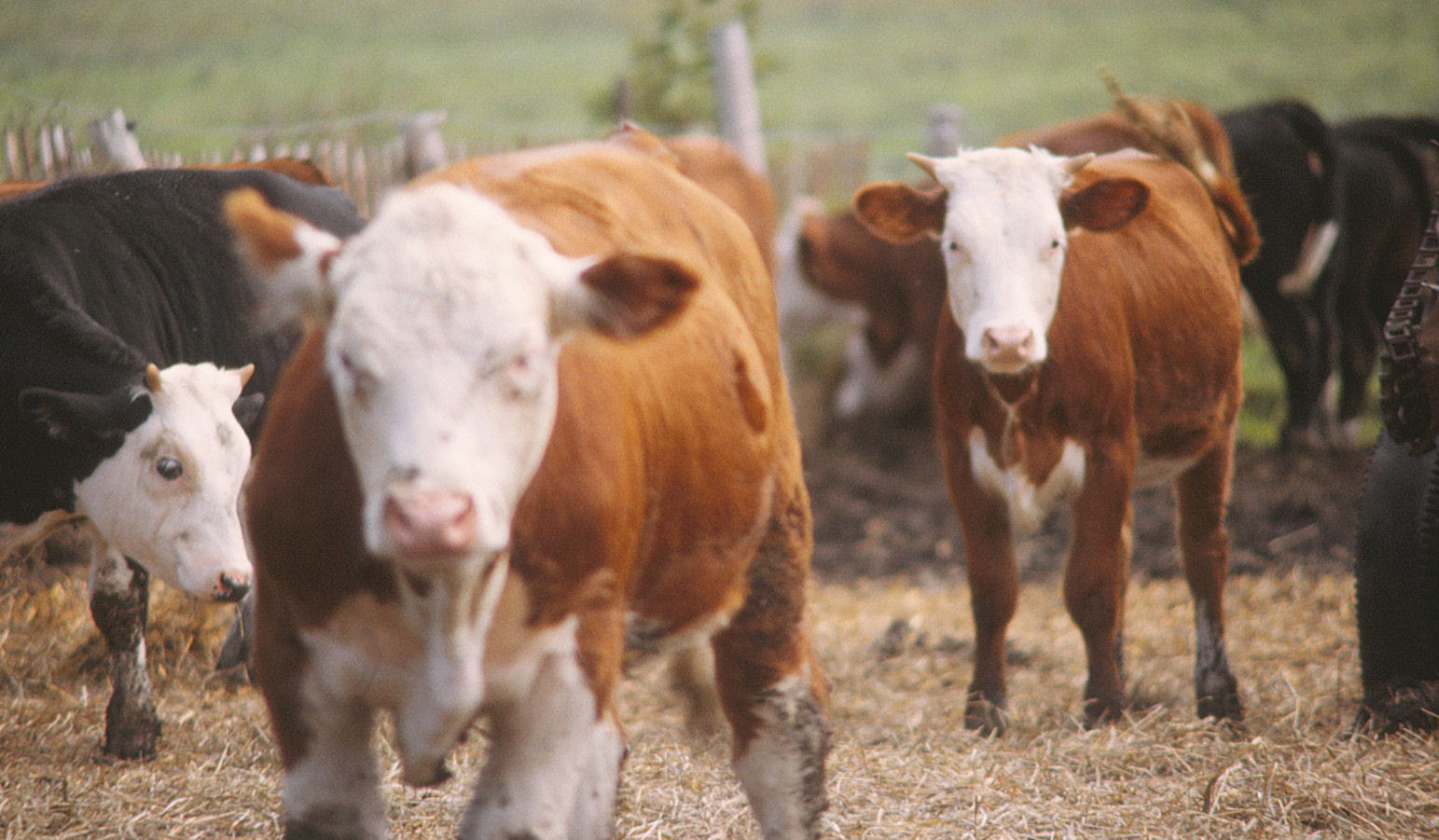
Mother's cows -Guernseys that she bought after she worked in the Cosmos Nursing Home
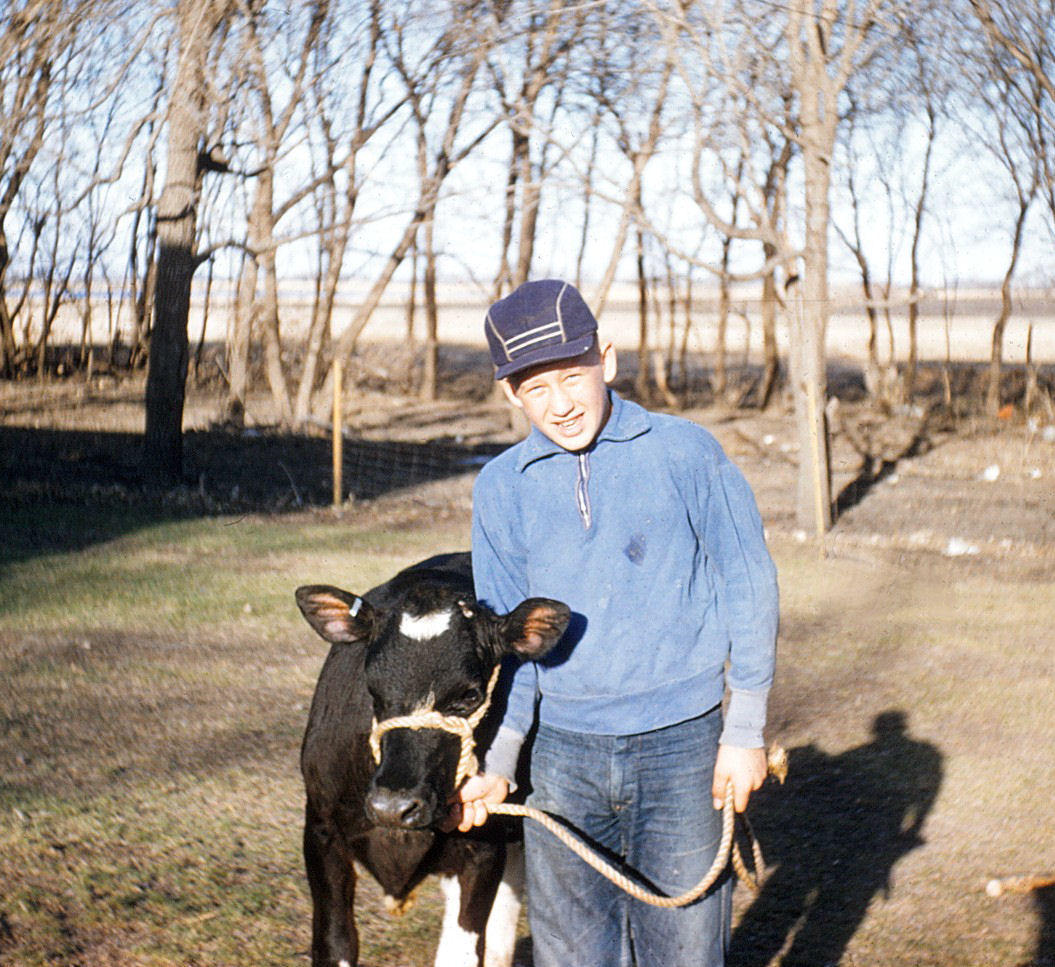
Stan Bomsta with his 4-H calf, Quenie
Wilton and Eleanor always raised chickens. They would usually have 200, either Red Hens or Leg Horns. Eleanor liked to have chickens to eat and for laying eggs. In 1948 Eleanor raised and sold roosters for $.28 a pound. She used the money to buy a piano so the children could take music lessons from Myra Petterson in Lake Lillian. She would pay for piano lessons with her egg money. The egg money was used to buy other special things. It was a big project to clean the manure out of the chicken house. Grandsons were usually recruited to help during spring break. Selling eggs continued for many years. The kids and grandkids had egg customers and some people stopped at the farm to buy some eggs which included coffee and lunch. Not much profit was made but they enjoyed the company.
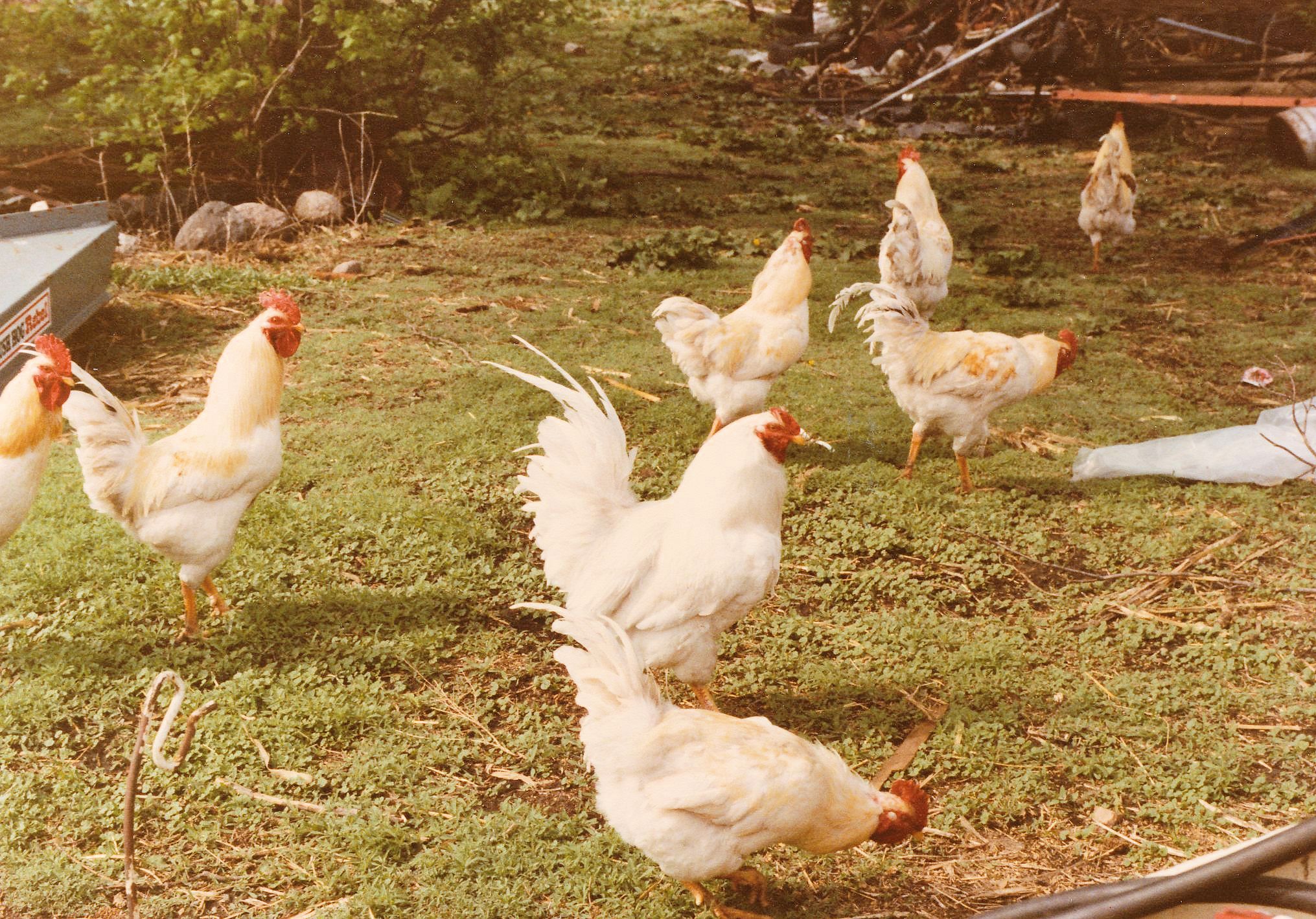
In the fall the roosters and the old hens would be butchered. It was quite a task just to catch them because they would roost up in the trees. Dale & Wayne Nelson and Stan would climb the trees to catch them and bring them in the chicken house before the first snowfall. The chickens would go running wildly or half flying when you were after them. Grandpa Henning would kill the chickens. The butchering was something LaVonne would try her best to get out of. When it was time to butcher chickens she was always very busy cleaning, washing, cooking, baking, sewing, etc. One could get out of cleaning chickens if you did some other jobs that needed to be done in exchange. Annette and Stan were good helpers for Grandpa Henning and Mother. They seemed to like this difficult task.
There was a period of time when chicken feed was bagged in fabric with pretty prints. A farmer would be instructed by his wife to get multiple bags of the same printed fabric. These flower sacks turned into house dresses, aprons and even underwear. The course fabric did not make comfortable underwear, however. It was stiff and scratchy. Mother wore aprons which came in handy for picking up corn cobs, small pieces of wood, carry eggs or vegetables from the garden.
Wilton and Eleanor raised pigs, too. When they were first married the pigs were butchered on the farm. The most they had at one time was 60. Sometimes the gate in the fence around the house would be left open and the pigs would come in. The kids all remember chasing pigs. When the pigs wanted to get out they would just dig under the fence or break through. Wilton would use electric fence and other elaborate fence to try to keep the pigs in the pig yard.
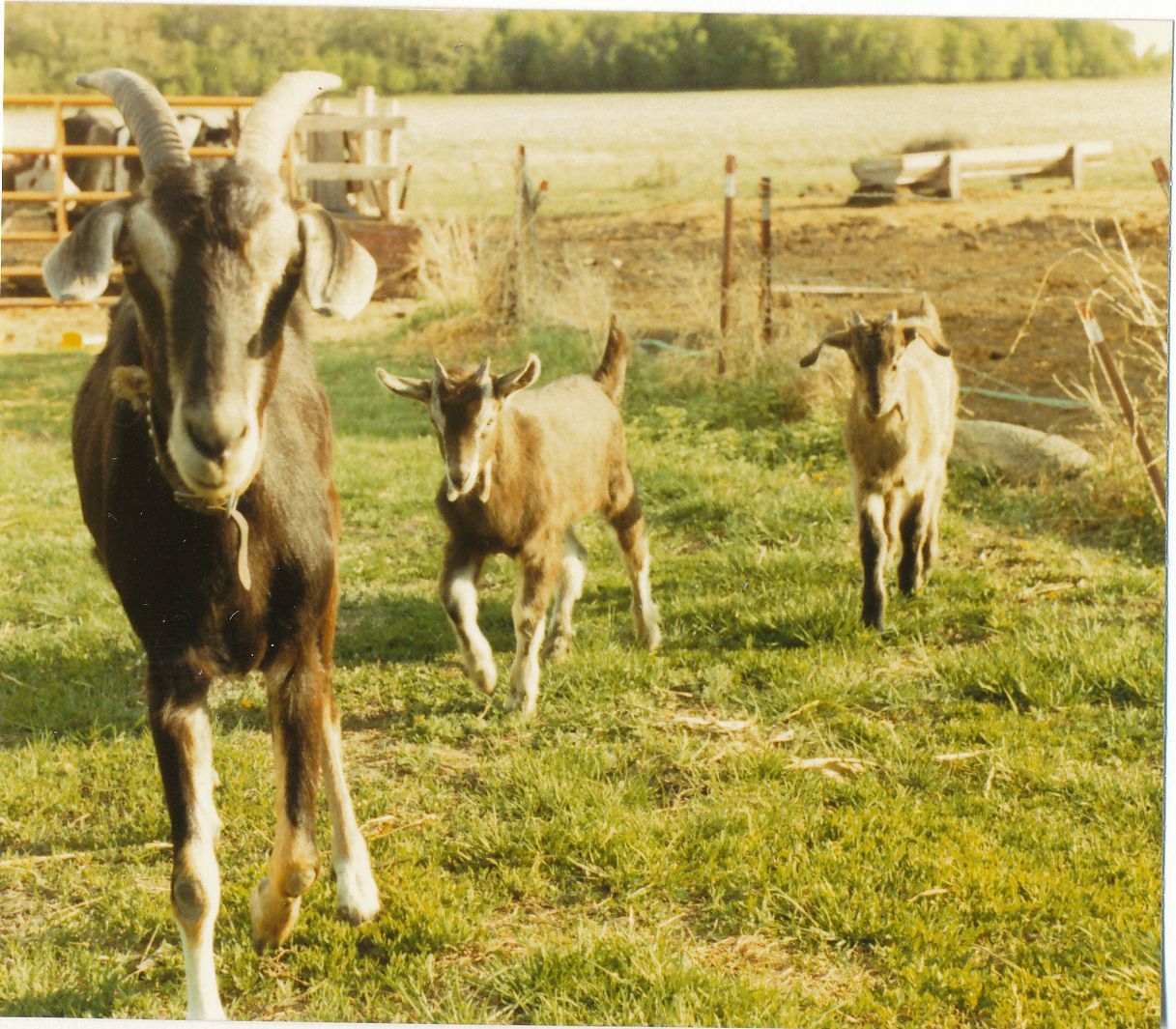
They also have had goats, ducks and pheasants. Ross raised baby pheasants for FFA and brought them out to the farm. Wilton liked to set up a place by the edge of the woods to feed the pheasants all winter. Wilton never joined the Farmer's Union or the NFO Organizations. He didn't agree with the NFO philosophy of paying $75.00 in dues and then men who weren't dairy farmers would tell everyone else to dump their milk.
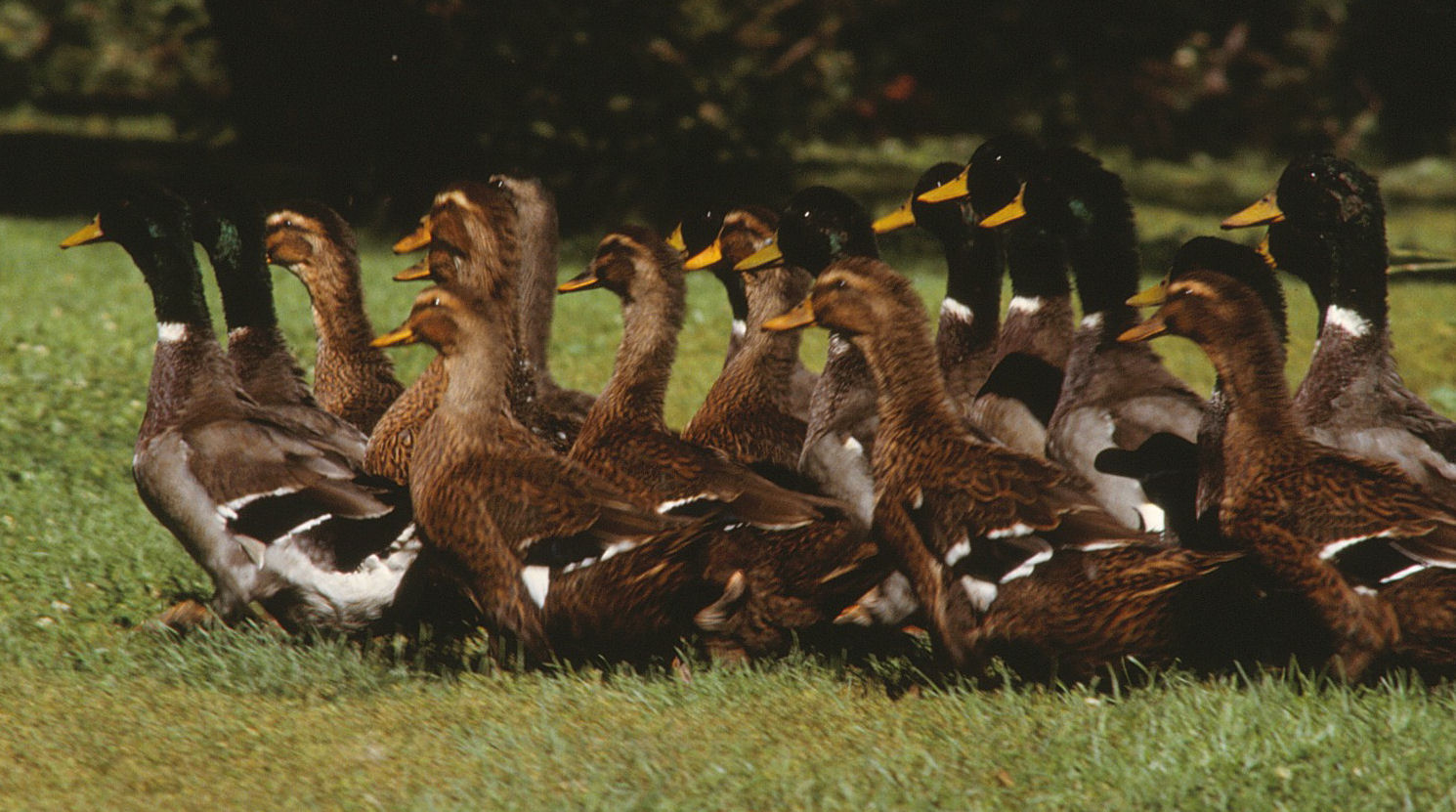
Their first dog was a very smart German Shepherd named "Judy." Russell and Amelia Bomsta gave the dog to Wilton when they were expecting Diane. They were afraid the dog would harm their baby. She was good with the cows and she knew how to protect the children from danger. She had many litters of pups. When the Lester Johnson family moved to Oregon in 1956, they gave their dog to the Bomstas. This was the first "Maggie." She was a miniature collie that could do numerous tricks like catching a ball or doing somersaults in the air. There have always been many dogs and cats on the farm. The favorite dog was "Maggie", an Australian Shepherd given to Wilton for his birthday. She was their companion in the house and outdoors.
Many relatives have enjoyed hunting at the farm. Back in 1939 and 1940 the pheasant population was very high. Hunters would come out from the Cities and stay all weekend. They would get as many as 20 pheasants in one day. In recent years the wetland slough is popular for duck hunting. Herds of deer are seen walking along the ditch and into the woods across the pasture. When it's very quiet you can hear the fox calling. In 1974 Wilton started to see footprints of a cougar. Emery had hunted for it unsuccessfully. In 2000 a brush wolf and her pups lived in the woods. After a sixty year absence, wild turkeys were seen in the woods during the 2005 deer hunting season. The pheasants make small come backs some years, but have never returned to the wonderful hunting on the 1950s and earlier years.
I am certain that hunting at the farm means different things to each of the family members who hunt or enjoyed the family time together during hunting season. My earliest memories of hunting and fishing on the farm primarily focused on pheasants and northern pike. Pheasant hunting was so interesting due to the large crowds of relatives and friends of the family that have walked the land over the years. In the 1940s and 50s pheasants were everywhere.
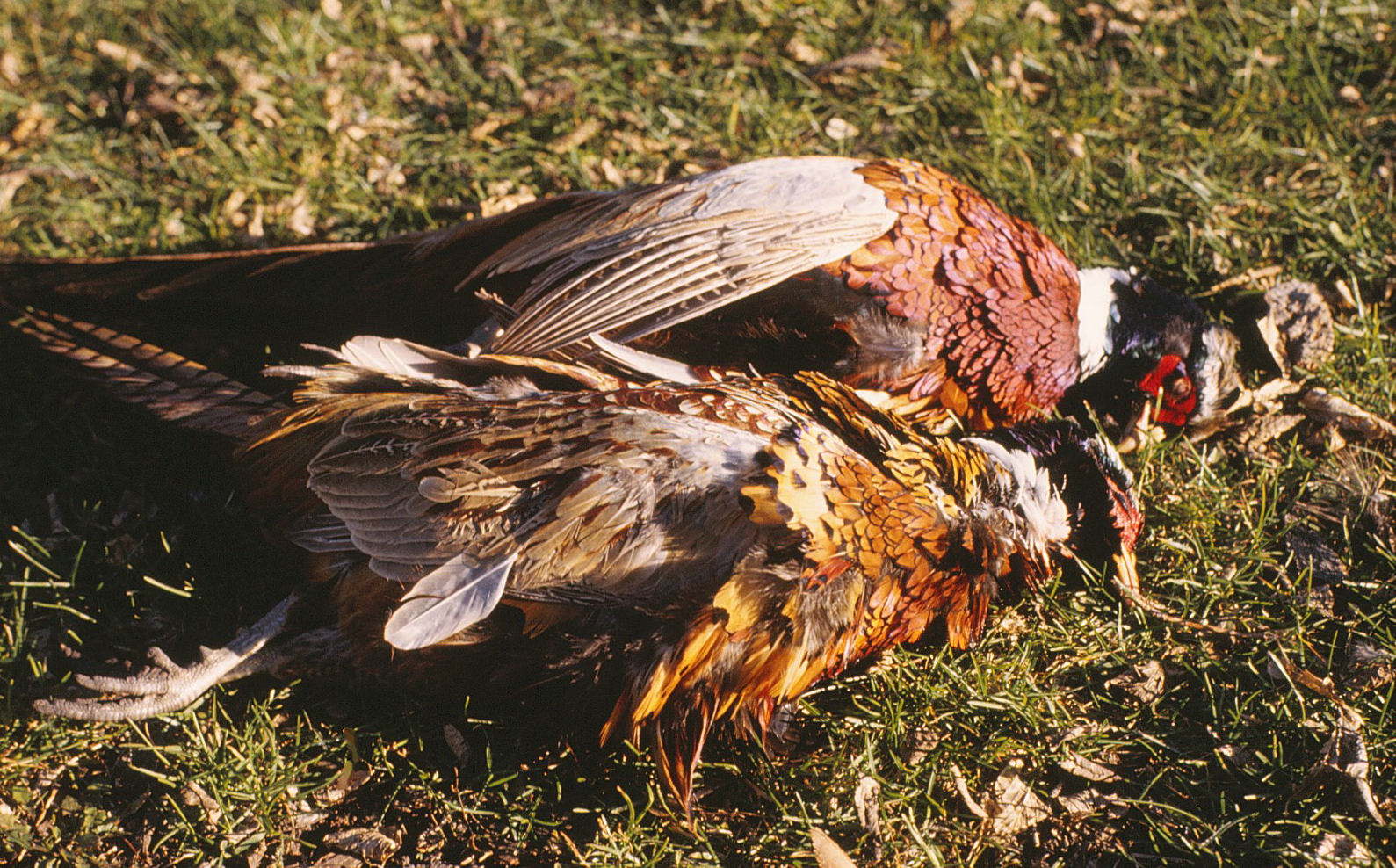
Pheasants
That does not mean that hunting wasn’t work. The “hunters” used to walk all the corn fields on our farm then the ditch bank to the Heinz farm and to Dale and Kathy’s current farm land then back again to eat some more. The energetic hunters would then walk the slough grass, the Bank of Willmar land, and the Nelson land. That is a very long day!
I started hunting at age 12 during a very wet season. The ducks were in flooded fields and pheasant hunting was still pretty good in 1957. Uncle Harlan Bomsta and a friend were about the only people who hunted ducks seriously. Wayne and Dale Nelson typically hunted ducks like I did at sunset or when we tried to sneak up on them in small ponds. In general there was less hunting by the late 1960s and then Bob, Mike, and Brian Hookom got interested in duck hunting during the 1970s.
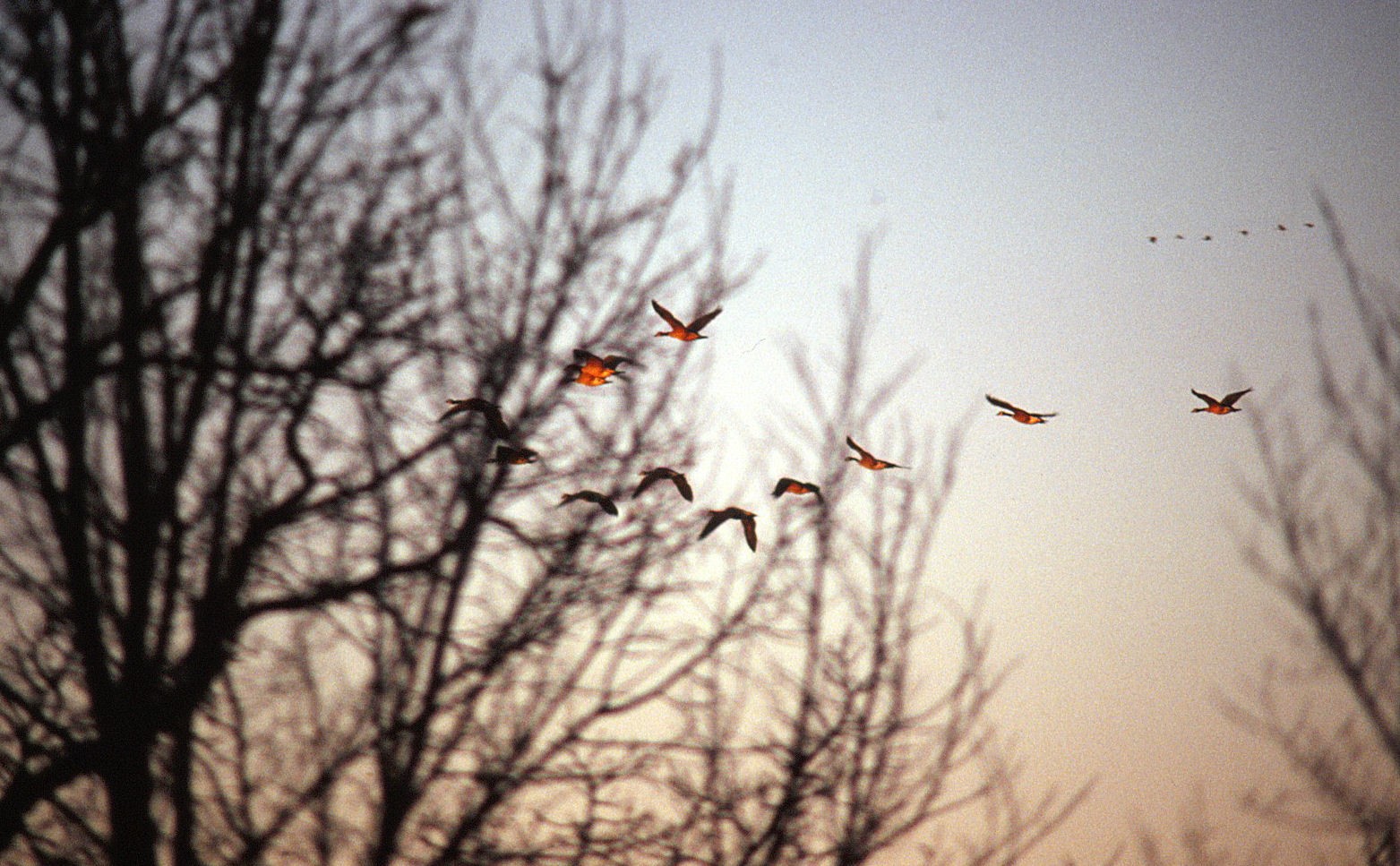
Slough pic during hunting season
We learned to hunt over decoys and enjoyed some super hunting, especially when the northern flights would come through.

Mark and Ross Hookom duck hunting
Bob and the boys loaded their own shells and packed the ‘67 Ford station wagon with decoys. The decoys were pretty effective, but we always just poured a cup of coffee when we wanted a big flock to look at our decoy spread. In those days we drove out to our hunting spot and then parked our car by the willow trees. During wet seasons we used the tractor and hay rack. Bob also made a nifty light weight trailer that could haul duck boats from the farm to the slough.
The geese population grew tremendously and became a new interest. Ross Hookom joined the hunt by that time and has shot the most ducks and geese of any family member out at the “slough”.
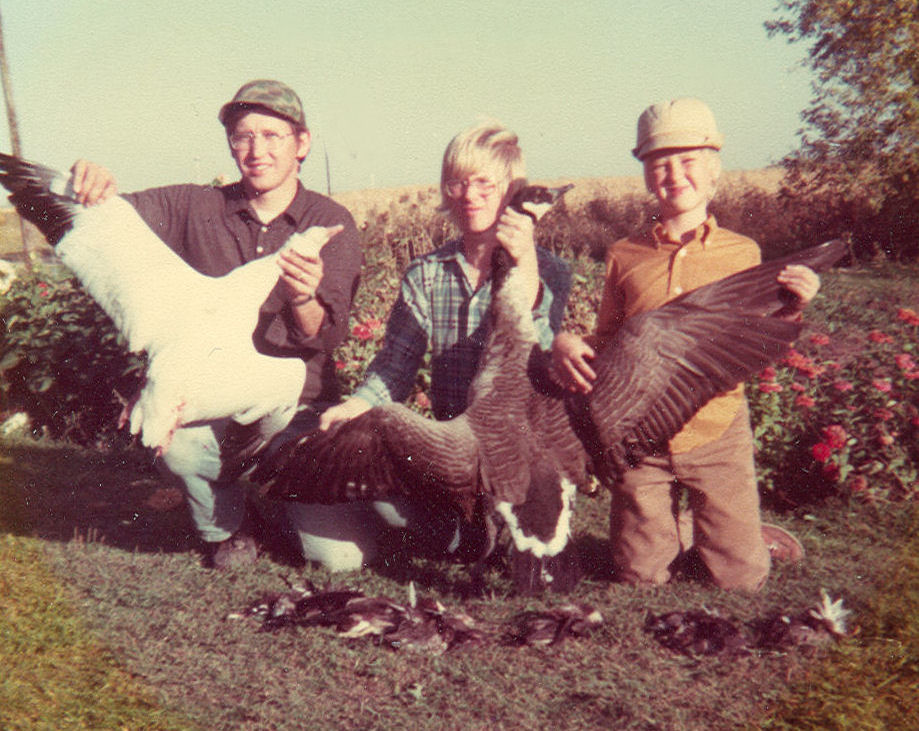
Hunters - Stan Bomsta, Ross and Brian Hookom
Lyle Bomsta and his friends Justin and John took up interest in hunting ducks and geese out at the slough along with Ross and his friends. Deer hunting was not even talked about in the Lake Lillian area fifty years ago. The deer hunters of that era all went up north. Currently, David and Matthew Schmiedeker, Ross and Zach Hookom, and Jamie and Cole Hagen, plus Lyle and his friends all do some deer hunting at the farm. Ben Hookom is old enough to hunt now, also. Uncle Emery was the first family member to hunt deer at the farm and he always used a classic bow and arrow. His hunting stories were as interesting as actually seeing a deer for ourselves.
The hunting legacy also includes some conservation efforts. Grandpa Henning was instrumental in getting neighbors to sell their land so that the general public can hunt on all sides of the slough. The present generation of LaVonne, Annette, Elaine, and Stan had a dam installed by the ditch to create a wetlands in the forty acres of land that was once a cow pasture.
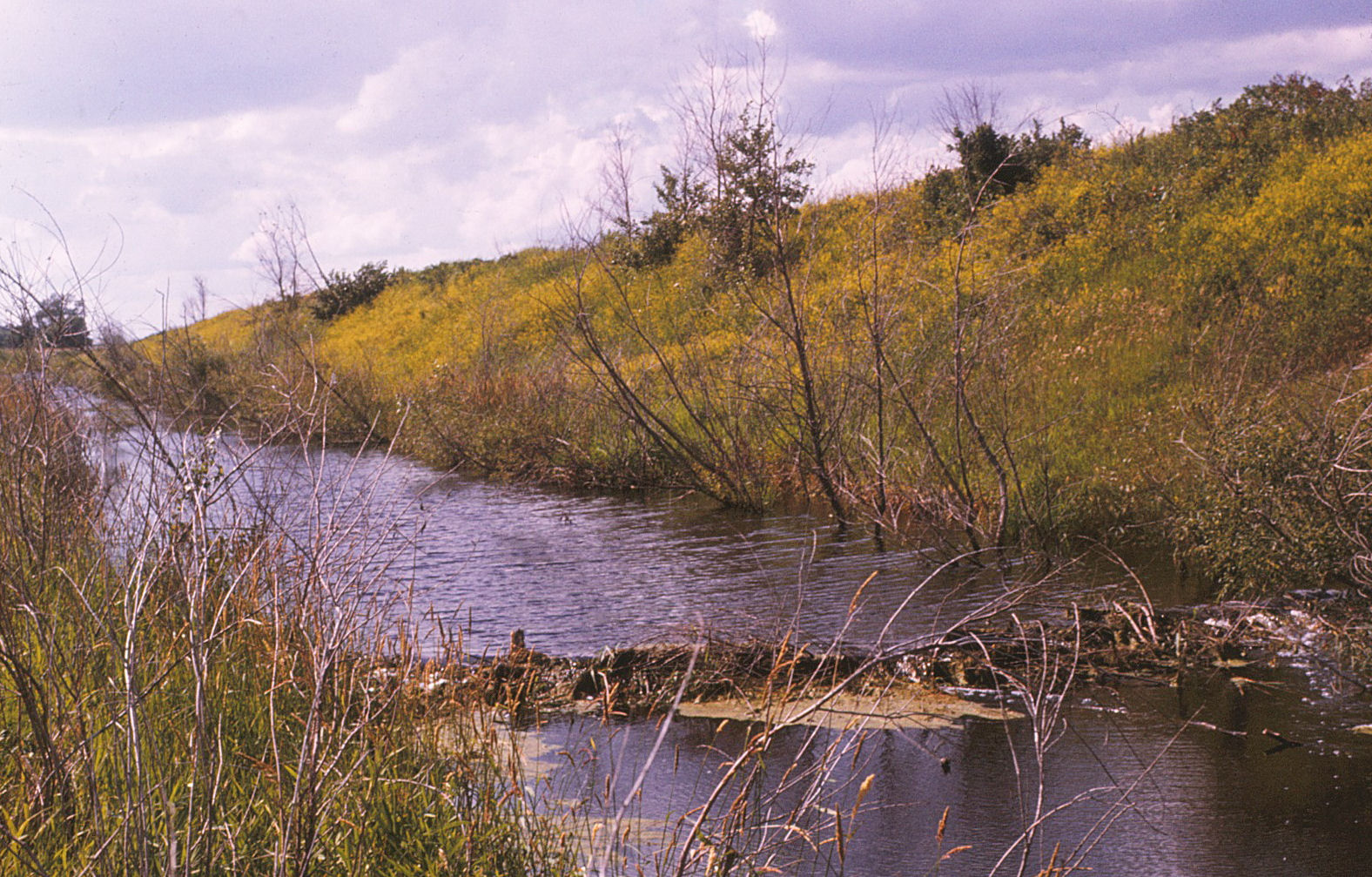
Beaver dam in nearby ditch
That pasture managed to get wet on its own back in the forties and fifties. There was real excitement in the neighborhood when northerns would come up in to flooded pastures each spring. Fish nets hung in our farm granary for many years.
Dad (Grandpa Wilton) taught me how to trap muskrats. The rats were worth about seventy five cents back the late fifties. I still have the twenty two rifle I bought with the money I made. Dale Nelson did some successful hunting for mink on the farm, but I never developed the skills for hunting mink.
There probably were other forms of hunting back in the era when there were wild turkeys, but we never talked about that with our grandparents, so information is limited from within our family.
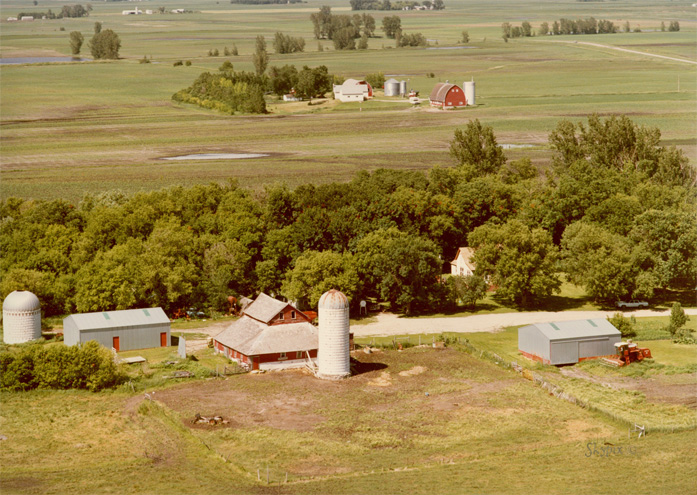
Farm 1978
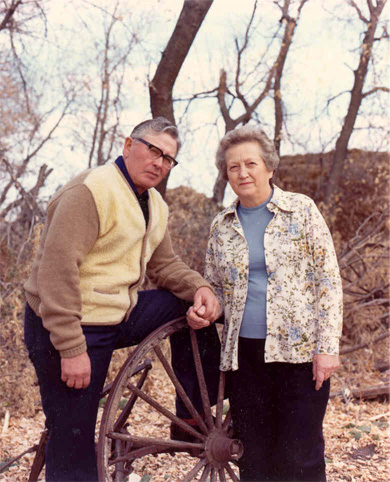
Wilton and Eleanor - 1976
Before 1948, the family went to church at the Tromso Lutheran Free Church north of the town of Lake Lillian on County Road #8. The church is gone now, but the cemetery remains. While the new church building was being built, the congregation worshipped in the garage of Harry Nordin's implement and car dealership on the main street in Lake Lillian. Eleanor always wore hats to church even when worship services were held in the garage. Stan liked to knock Eleanor's hat off onto the dirt floor. Harry Hawkins warned Stan he would "pin his ears back" if he didn’t behave in church. The church changed its name to Grace Lutheran Church when they decided to move into Lake Lillian. In 1948 the new church building was complete and the congregation moved in. Members were encouraged to buy furniture for the new church. Wilton and Eleanor bought one half of a pew. They would always sit in this spot when they went to worship.
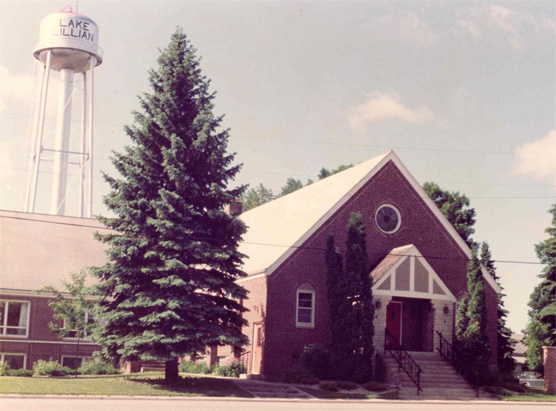
(Grace and First Lutheran merged, eventually worshipping together at First Lutheran. In 2010 a very nice addition was completed. They can enter the church on ground level. They built a new kitchen, fellowship hall and narthex. The stained glass windows, cross, small pews, bell and other items from Grace were used in the project. )

Sunday School Picnics in the summer and Christmas programs were a real big event. LaVonne and Annette both embarrassed their parents at the Sunday School Christmas Program when they were four years old.
LaVonne was a bashful child and she refused to say her recitation. No amount of coaxing would get her to speak, finally she backed up to sit down and fell backwards on her bottom. At Annette's first program, she promised Grandpa Henning to speak up real loud so he could hear her at the back of the church. She did just that, VERY nice and loud! The programs were much the same as today. Skits, songs and recitations were used to tell the Christmas story. Elaine and Stan did what they were supposed to do at their programs.
Many families were invited after the Christmas Program for lots of goodies to the home of Art and Lena Johnson. Their daughter and son-in-law, Lillian and Oliver Riedel lived with them. The children would sit on the steps to eat delicious Christmas goodies. We had fun playing together.
Grace Lutheran Church had excellent Vacation Bible School for the children under the leadership of Mrs. Melby, the pastor's wife. Using a flannel board, she would tell a thrilling missionary story in installments so it would last all week. There were Sunday School picnics at Diamond Lake in the summer with games and prizes. These annual picnics moved to Big Kandiyohi Lake when the county park opened there in 1959. Family Luther League meetings were held on Sunday evenings. Grace Youth were very involved with activities, music, and Bible Camp. Grace Lutheran has produced several pastors and a long list of church leaders and servants over the years.
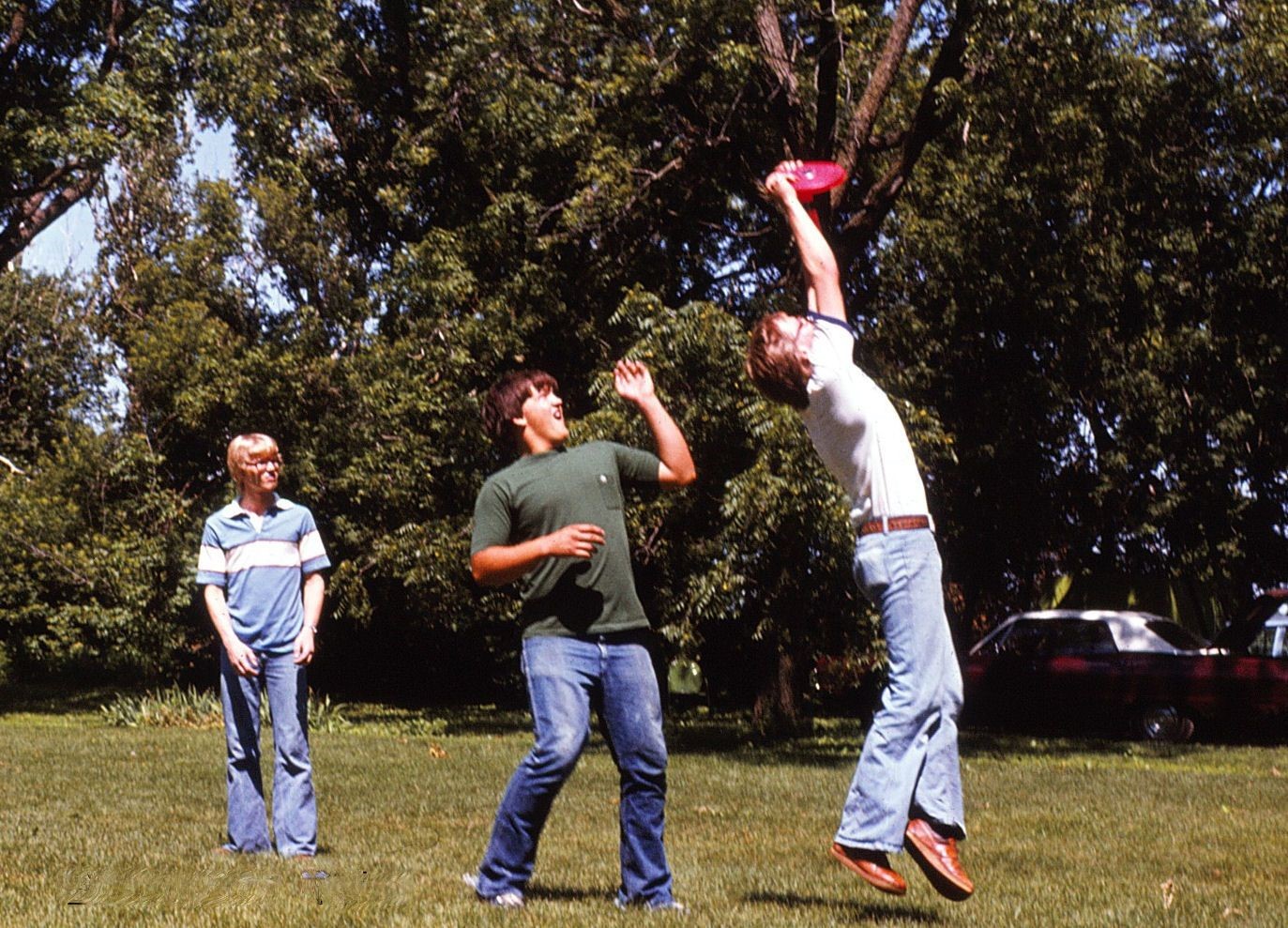
Grandsons playing Frisbee
Sunday was always a day of rest. The family went to church often picking up people on the way. Sunday afternoons was spent visiting at Grandma and Grandpa Halverson’s in Litchfield or going over to one of the neighbors. People didn't wait to be invited; they would drop in on someone. If the baking didn’t get done on Saturday, we ate our Sunday dinner and left quickly. Some of the families that Wilton and Eleanor would visit regularly were Maurice and Deloris Nelson, Kermit and Helen Linn, Chester and Doris Nordin, Harry and Violet Nordin, Art and Edythe Nordin, Alroy and Dorothy Summerlet, Roy and Arline Vick, Lester and Audrey Swenson, Andrew and Luella Larson, Clinton and June Oslund, Glen and Dorothy Boll, Kenny and Lois Yarmon, etc. There would always be a big lunch; a sandwich, cake, cookies, Jell-O or glorified rice. The children would play "Dress Up" or go out and explore the "Play House" in the woods. At some farms we could play in the haymow. If there were enough kids a game of softball would be played.
In the summer Eleanor took the children to Big Kandiyohi Lake to go swimming so we could cool off at Petersons or Nelson's resort. She also took them to Warren Leikvoll's roller skating rink at Big Kandiyohi Lake. The children had fun ice-skating if the lakes or our slough would freeze smooth. The kids made elaborate playhouses in the woods with paths between each of them. They would have a house, school, church and restaurant. Before the days of TV, children were very good at using their imaginations for play.
Farmers that milked cows found it almost impossible to get away for any length of time. The family was content to go to Minneapolis to visit Harlan and Muriel Bomsta, Erle and Delores Draxton or maybe the State Fair, or sometimes to Hinckley to see Wes and Irene Halverson. The trip could only last the day, however.
LaVonne, Annette and Stanley went to country school at District #43. The elementary school was located on the ditch bank north of Dale Nelson's farm. There was one large room for all eight grades. There was a small room for a library. The teacher had to teach all eight grades and monitor lunch and recess. The older children were expected to help the young ones with their work and helped correct some of the papers. If you wanted hot lunch you put your food on the stove when you arrived at school and it would be hot at noon. All winter the school smelled of wet woolen mittens drying on the stove. Some teachers planned plays, which the children presented for their parents. The older boys loved to play tricks on the teacher! During recess a game of softball was played. In the winter the ditch bank was a favorite place to slide. Kids played on the ice. It was a miracle that no one ever drowned.
LaVonne, Annette and Stan often would go over to Maurice and Deloris' home after school and play there until Henning picked them up on his way home from Willmar where he worked for the Agricultural Stabilization & Conservation Service. Deloris and Grandma Nelson would greet us with freshly baked bread or cookies. In the spring when the roads became impassable the kids would stay overnight. Sometimes they walked the four miles home from school or rode their bikes if the weather permitted.
For Christmas in 1953, Wilton bought a black and white portable television set for about $100.00. Before we got our own T.V. we would go over to Maurice and Deloris's house to watch "I Love Lucy" or wrestling every week. Nelsons had a place on Big Kandiyohi Lake where we enjoyed many family picnics and water fun. Everyone had a good time visiting and eating.
A lovely new elementary school was built in Lake Lillian which Annette, Stan and Elaine attended. District # 344 was built for $280,000.00 and was dedicated in 1955. They were bussed to school. The children also went on a school bus to Atwater High School. They rode one hour every morning and evening.
The children were active in the Jolly Lakers 4-H Club. The girls liked cooking and sewing projects. Stan had calves for his project. There was competition for softball and plays between all the clubs in the county. The Jolly Lakers won many championships and awards.

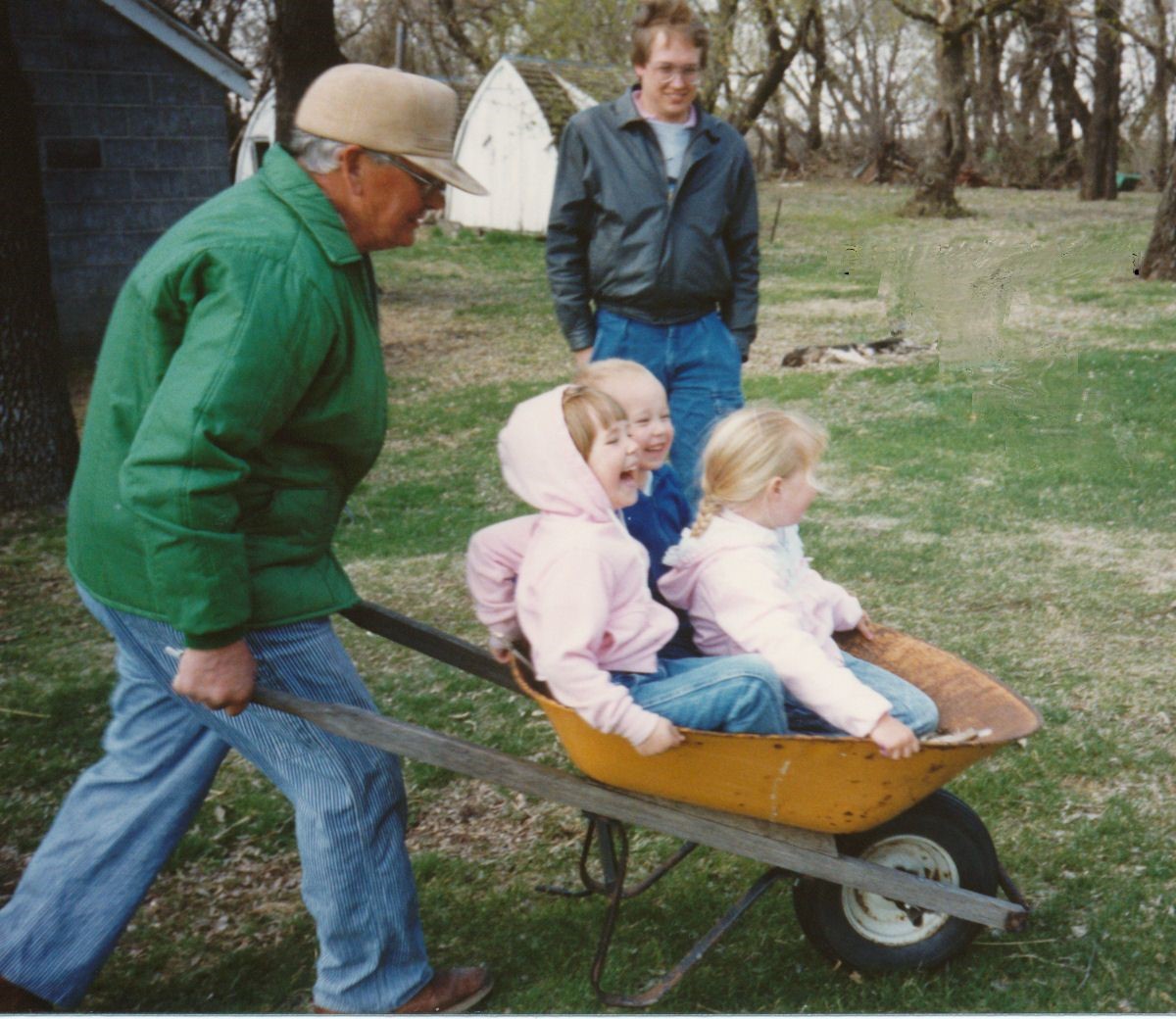
Grandpa gives a ride to great grandkids
The grandchildren have all wanted to come and stay a long time at the farm but when their mother's came to get them they were ready to go home. Each visit the kids would get to go to the Creamery for a treat. The Gronli kids got to choose a favorite cereal that they didn’t get at home since the Creamery is closed.

Stan Bomsta gives his granddaughter Maddie Bomsta a ride on the tractor
Eleanor has enjoyed reading stories to her children and grandchildren. Stan's favorite was "Black Beauty' and "The Three Billy Goats Gruff". Cheryl loved the Mother Goose Nursery Rhymes. The kids would ask Wilton for a story and he told stories instead of reading. The kids were good to correct him whenever he made a mistake.
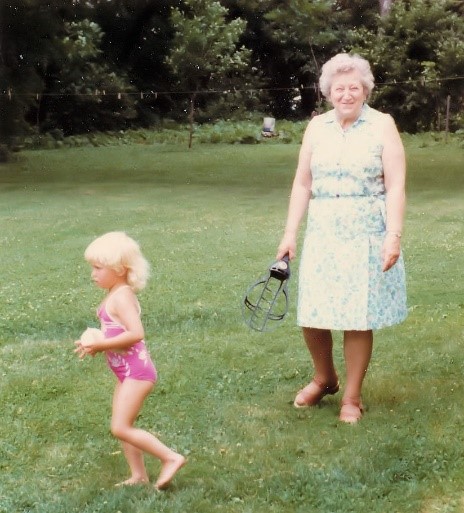
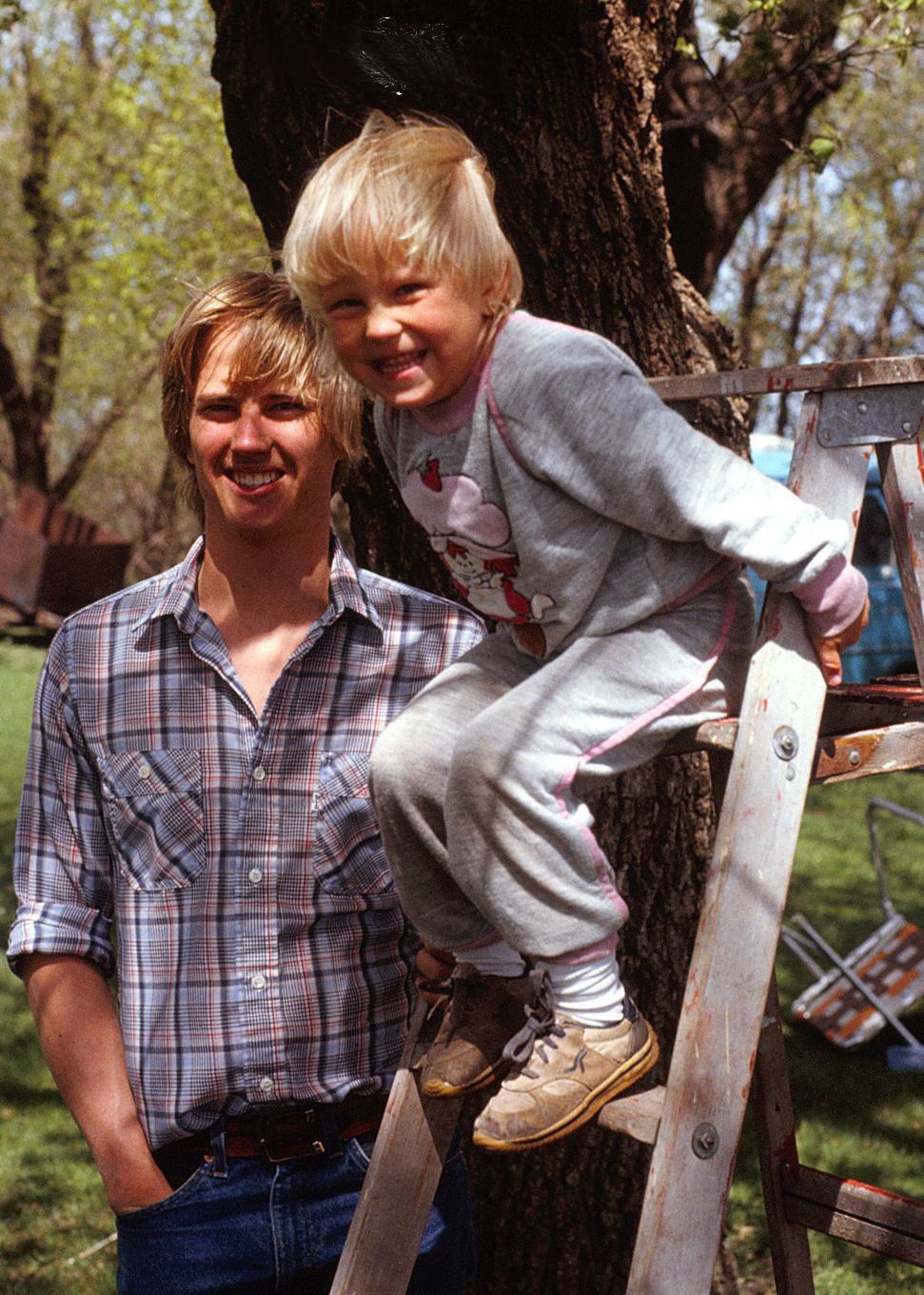
Ross Hookom and his cousin Sara Gronli celebrate their birthdays at the farm.
Both born on April 29
The mean roosters chased the grandkids, too. David was chased into the milk house. Lyle could walk to the barn without the roosters bothering him, but Greg couldn't. Cheryl would stand in the doorway and call for Grandpa to come and get her.
One day, David and Grandpa were coming home from Lake Lillian after grinding feed. They were driving the old Studebaker truck when the tie-rod broke. They went off the road toward the lake. Grandpa wired it up with twine and wire and then they drove home.
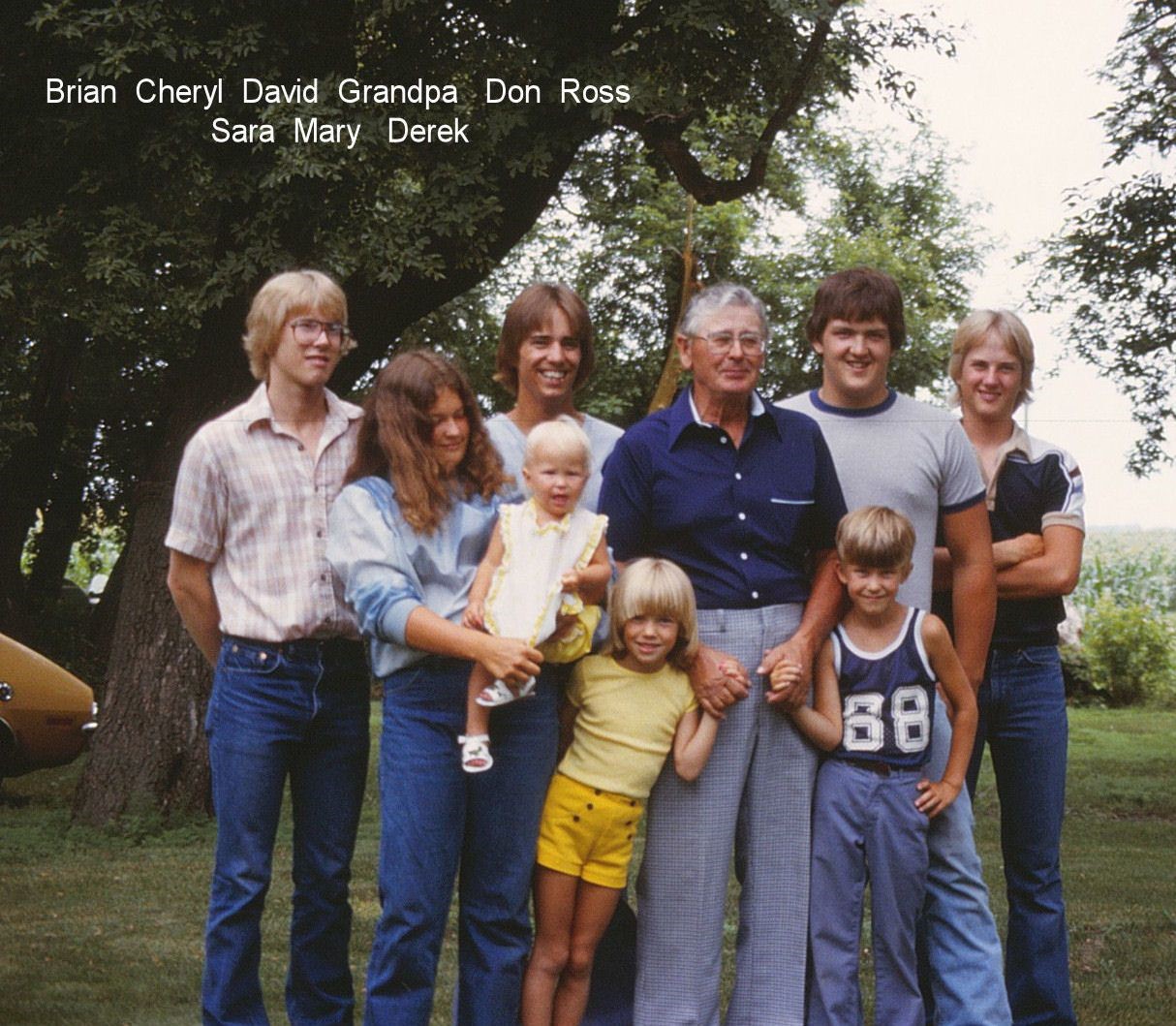
Birthday party
Brian Hookom, David Schmiedeker and Gary Nelson went for a walk along the ditch and ended up at Dale and Kathy Nelsons. It was too late to walk back, so Wilton had to go and get them. Wilton was mad at Eleanor for letting them go alone. She let them go because they were very restless and she thought it would be good for them to go for a walk.
Lake Lillian had many interesting characters. Russell Hanson would come over to the farm whenever it is time to eat. He timed his visits perfectly. He would talk for hours telling his World War II stories over and over. Johnny Hanson liked to travel around the neighborhood and share gossip. The oldest brother James liked to raise oxen, which he took to Centennial Celebrations. Ben Hauser and Charlie Taylor were well known. Charlie didn’t have a car; instead he drove a Ford tractor wherever he needed to go.
.jpg)
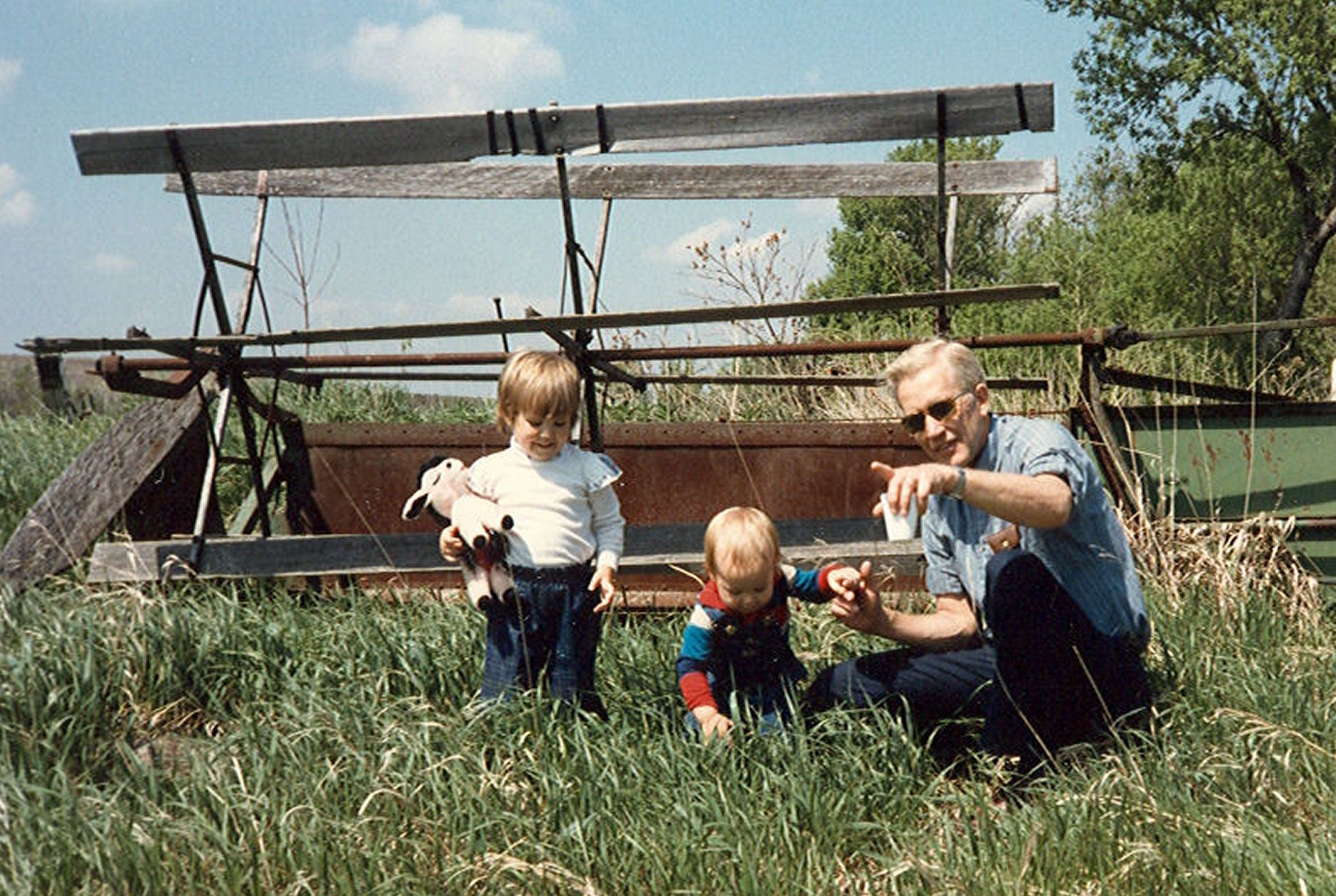
Bob Hookom explores old machinery
with grandkids, Amber and Andrew Hookom
Shows a reel on a swather or binder or maybe a grain head for an old combine
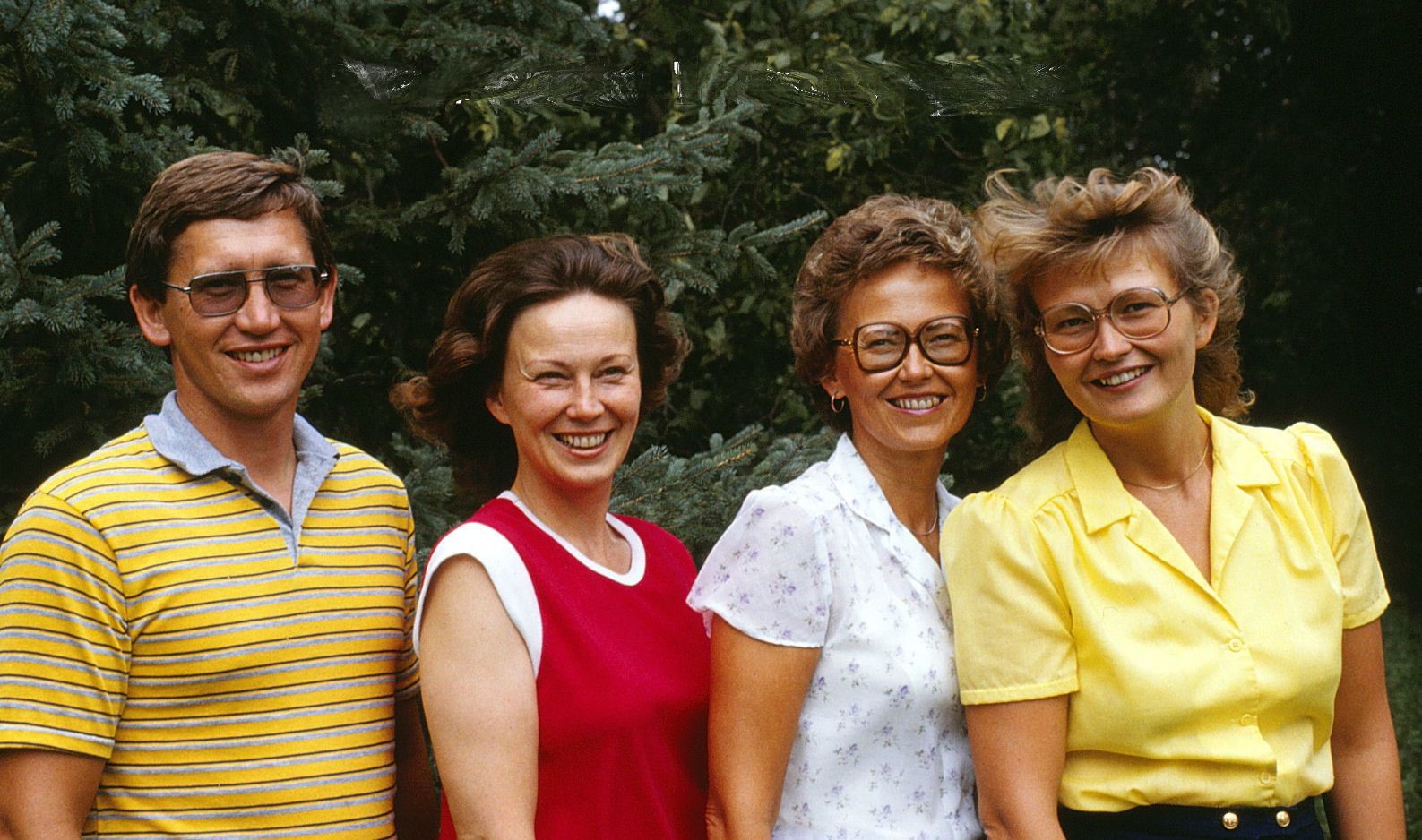
Eleanor's favorite season on the farm is spring. Her favorite garden flowers are zinnias because they are bright colored and bloom for a long period. She also likes marigolds, peonies and tulips.
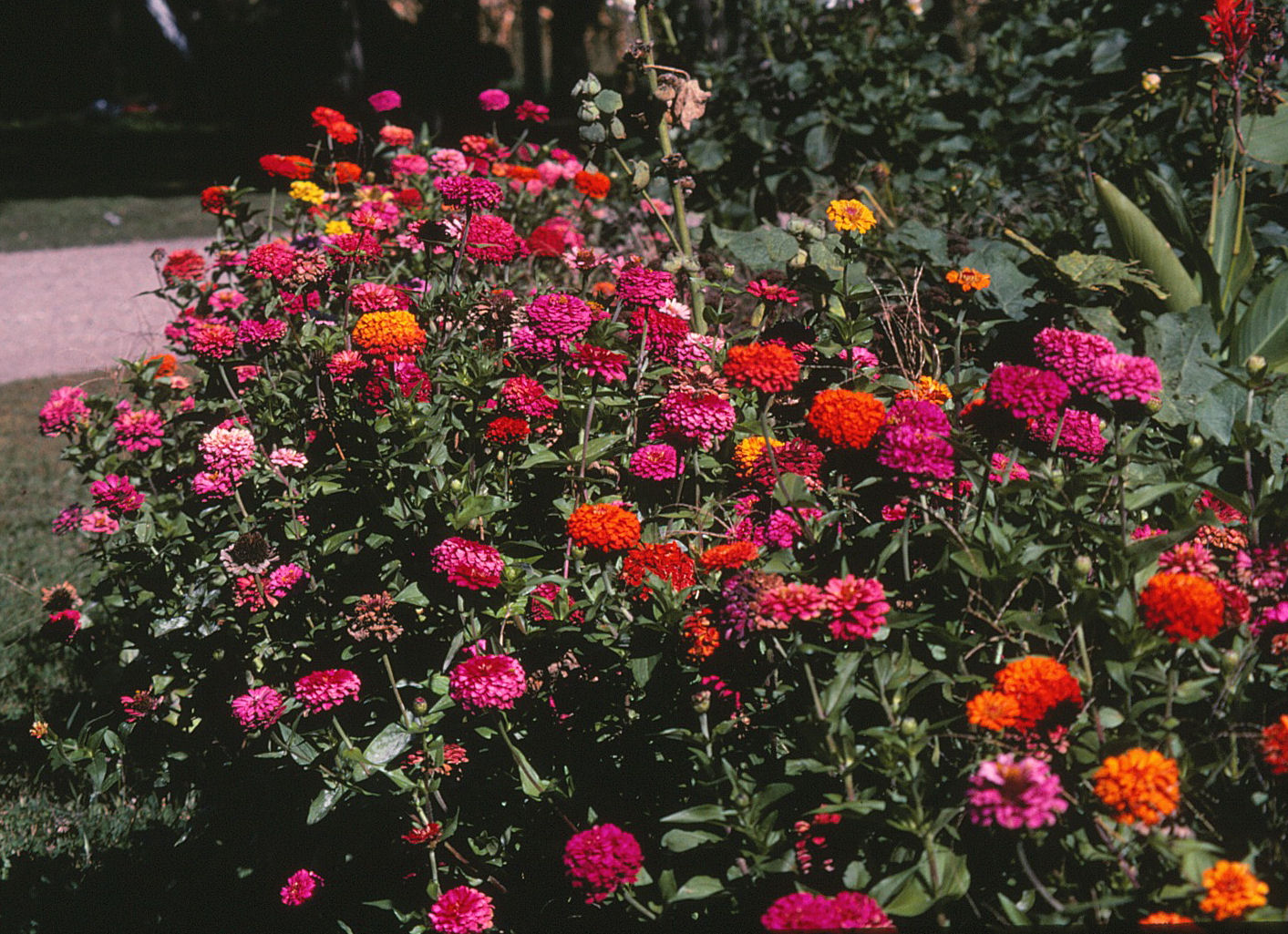
There have always been apple trees. They used to be north of the house in the woods, now the new trees are planted in the garden. Some varieties are good for baking, or sauce, or a good kind to keep in the winter for eating. Eleanor tried peach and pear trees but they were victims of winterkill.
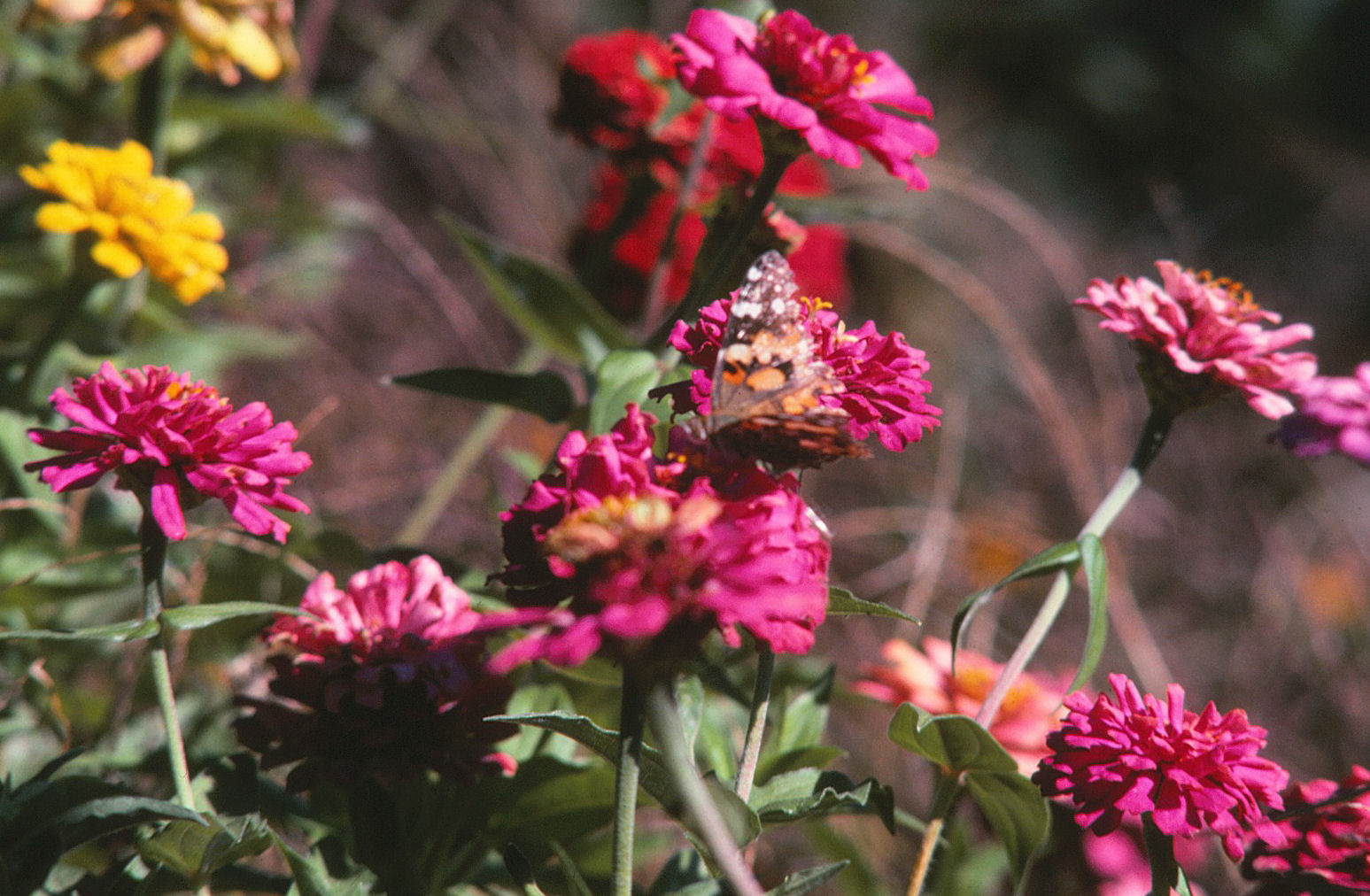
Wilton and Eleanor have both been active in church and community affairs. Wilton was an usher for 37 years, a member of the Cemetery Board for 20 years, served on the Church Council and the School Board. From Grace Lutheran Church Wilton, Roy Vick and Clarence Lund dug most of the graves at the Tromso Memorial Cemetery by hand. When Wilton dug his first grave it was 20 degrees below zero for Anna Johnson Knight in 1936. His horse, Jane, became very cold. She acted wild, wanting to go home. When Wilton was finally ready to go she gave him quite a ride!
They helped with fund raising for the building of the new church. Eleanor helped with food sales, taught Sunday School for 25 years, participated in Ladies Aid and Circles and served on the Serving Committee. Eleanor has made numerous quilts for the Lutheran World Relief for her church. She finds it very relaxing to quilt and likes the idea of leaving keepsakes behind. She made a beautiful quilt in the "Love Ring" pattern for most of the grandchildren. The younger ones received a down comforter instead when they were married.

In the photo - Grandpa and Grandma pose with the quilt made for
Greg & Ruth Bomsta’s wedding gift in1996.
Della Hawkins and Annie Swenson taught us how to make lefse on the old wood stove. Eleanor's mother gave her an electric lefse griddle. The present recipe contains whole-wheat flour and is a combination of Annie and Ethelyde Rasmusson's. The lefse are rolled out in rounds, baked on the grill, and stacked. When ready to serve you soak the round lefse to soften, butter it, and sprinkle with primost cheese and brown sugar. Next the lefse are folded, wrapped and frozen. It only takes a few minutes to thaw them out and then cut into strips. The "Lake Lillian" lefse is typical of lefse from northern Norway.
Eleanor, June Oslund and Sally Lund took piano lessons from Mrs. Brink in Blomkest and also in New London. Eleanor also had some sewing lessons in Hutchinson after she purchased a new sewing machine.
Wilton and Eleanor have made many changes in their life during the years as they prepared for retirement. It was hard for them to sell the cows and cut back on the amount of land farmed. In 1976 they started selling the cows, when a man from Grove City bought six heifers. They eventually sold the rest. Wilton was kept busy with some chickens and fieldwork.

1980 Wilton takes a spin on grandkid's three wheeler
They finally made a couple long road trips with Harlan and Muriel Bomsta. In the fall of 1981 they traveled north to Duluth, Thunder Bay, Ely, Virginia and the Iron Range. They took a more extensive trip starting August 27, 1983. They traveled to Banff -- Lake Louise in Canada. Toured Glacier and Yellowstone National Parks visited Eleanor’s cousin in Kalispell, Montana and visited the Black Hills, Mount Rushmore and Wall Drug in South Dakota on their way home. They were gone about 8 days for this trip. Now that the travel bug had hit, they took their next trip starting out on August 25, 1984. They drove to St. Ignace, Michigan, Mackinac Island, visited the Greenfield Village and Henry Ford Museum, Notre Dame University and St. Mary’s College in South Bend, Indiana, Amish Acres in Nappanee, Indiana, Gary, Indiana, by passed Chicago, Illinois arriving in New Glarus, Wisconsin to see “Little Switzerland” of America on their way home. This was a six day trip. Muriel made photo/scrapbooks for these trips. Looks like Harlan did the driving and photography, the other three were looking for places to eat!!
Eleanor washed clothes at a laundromat in town for many years but when she was sick Wilton did the clothes washing. He soon got tired of lugging everything to the laundromat so in the summer on 1986 he and his grandson, Derek Gronli, dug out the old Maytag wringer wash machine and rinse tubs. With a little work he soon got the machine to run and they had the lines full of clothes to dry. He enjoys doing the laundry at home and is very proud of how he puts the shirts through the wringer so the collar stays nice and the buttons don't break. The children and some the grandchildren gave them a clothes dryer and hooked it up for Christmas. Now washing in the winter was fun, too.

In the early 70's Eleanor had trouble with her back and later she developed Meniere’s disease. She went to several specialists and found that eliminating salt from her diet was the best way to treat the Meniere’s disease. In January of 1978 Eleanor fell and broke her ankle in several places. After a long and painful recovery she had another misfortune. In the fall she was at the dentist to have a root canal done. He wasn't using a throat guard and she accidentally swallowed the needle used to clean out the root of the tooth. She was x-rayed on a regular basis to watch where the needle was. The doctor hoped it would pass through. At one point it stopped moving and they thought they would have to operate but them it started to move again. The thought of an operation was put aside. On a snowy night at 3 or 4 AM, Eleanor awoke with pains. She woke Wilton and he took her in to the Litchfield Hospital. The needle had perforated her intestine and had to be surgically removed. She was discharged from the hospital the day before a party to celebrate their 40th Wedding Anniversary at Bob and LaVonne’s house. Several relatives attended their party.

Wilton and Eleanor with grand kids on their 40th Anniversary 1978
Mom and Dad loved to have parties to celebrate anniversaries, birthdays, Mother’s Day, Father’s Day and loved having family home during the holidays.
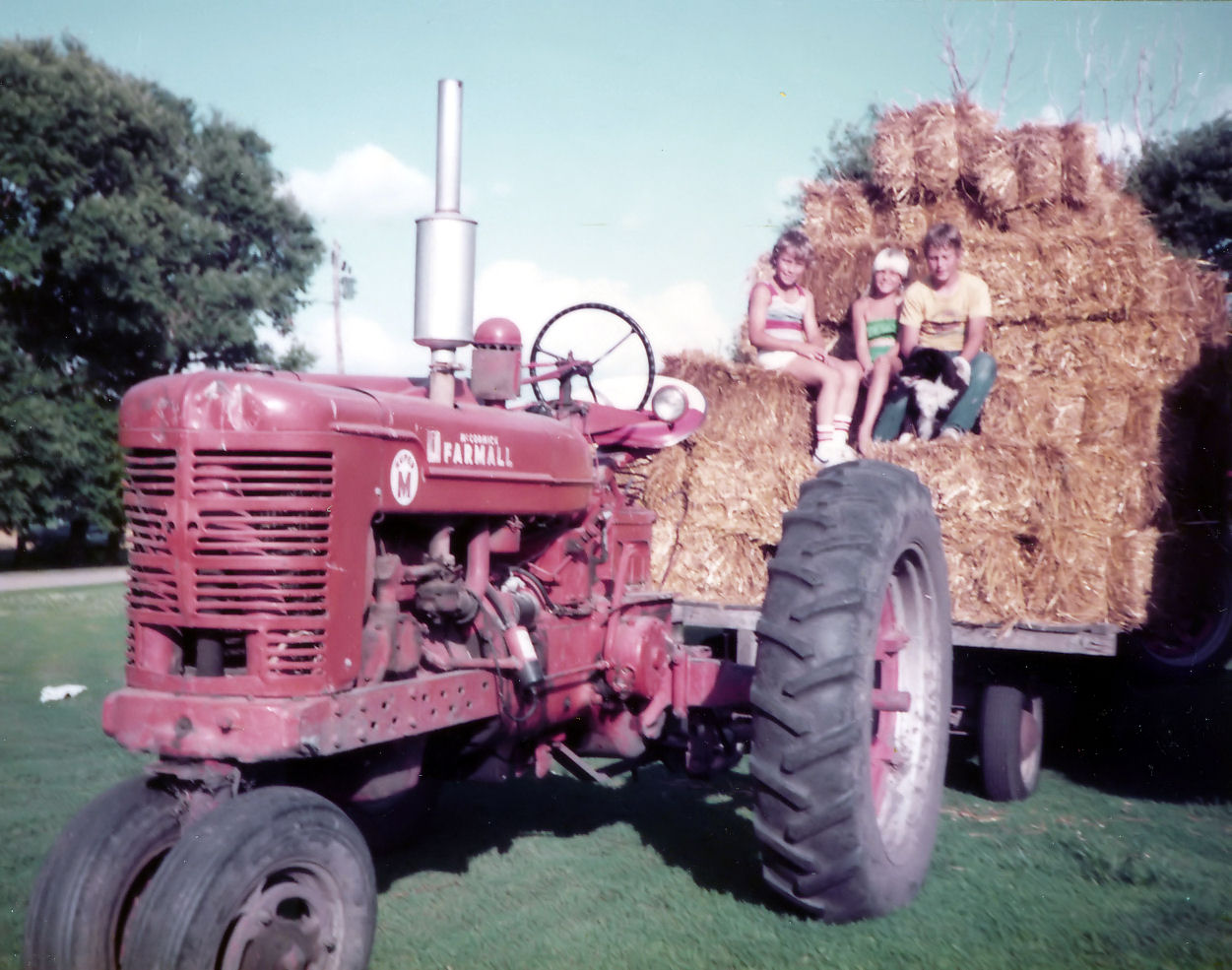
Grand kids enjoy hay bales - Lyle Bomsta, Mary Beth Gronli and Greg Bomsta
They delighted in having us come out to the farm. Dad would always make a run to town for treats!
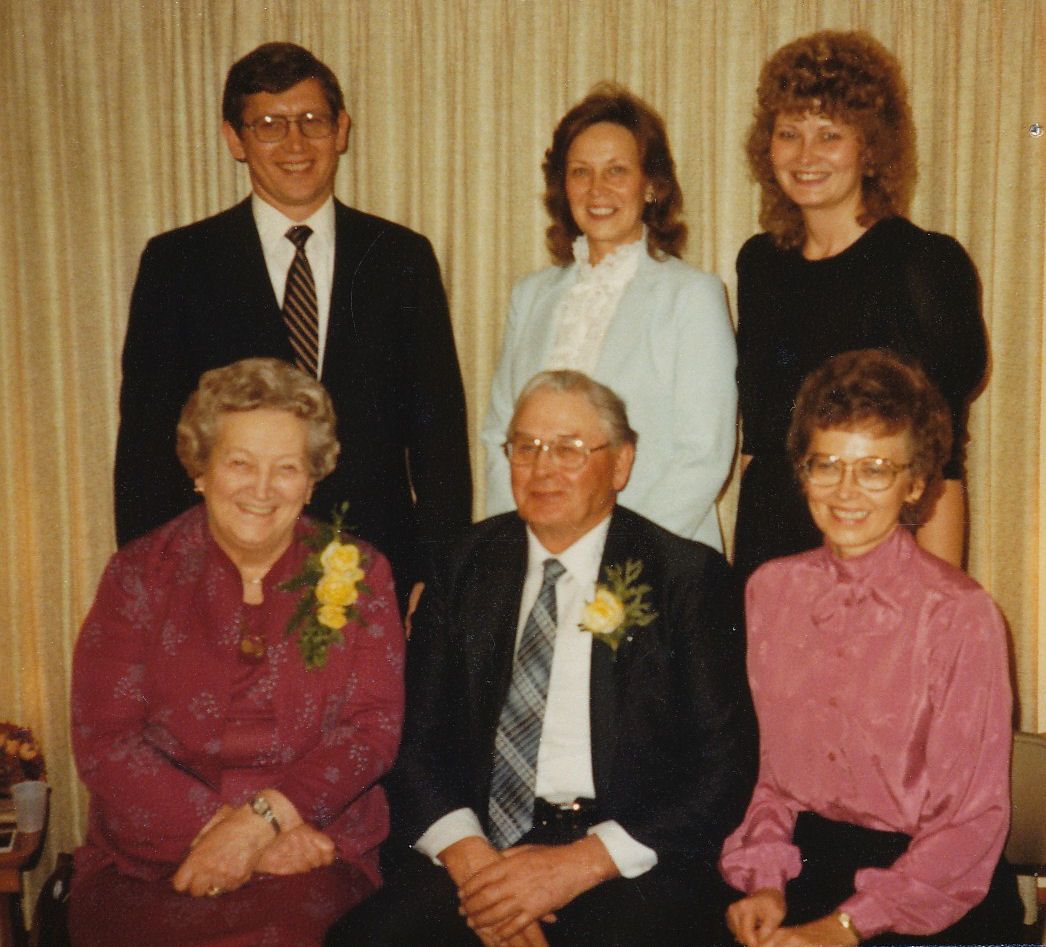
1983 Wilton and Eleanor 45th Anniversary -
BR. Stan, Annette, Elaine,
FR - Eleanor, Wilton and LaVonne
Their 50th Anniversary was celebrated with an Open House on Dec. 1, 1988 at Grace Church. A snow storm kept many people from attending but those of us who were in attendance had a good time. Muriel Bomsta slipped and fell on her knee coming down the stairs to the basement. They had a harrowing time getting to Willmar to the emergency room in the storm. She found out her knee cap was broken.
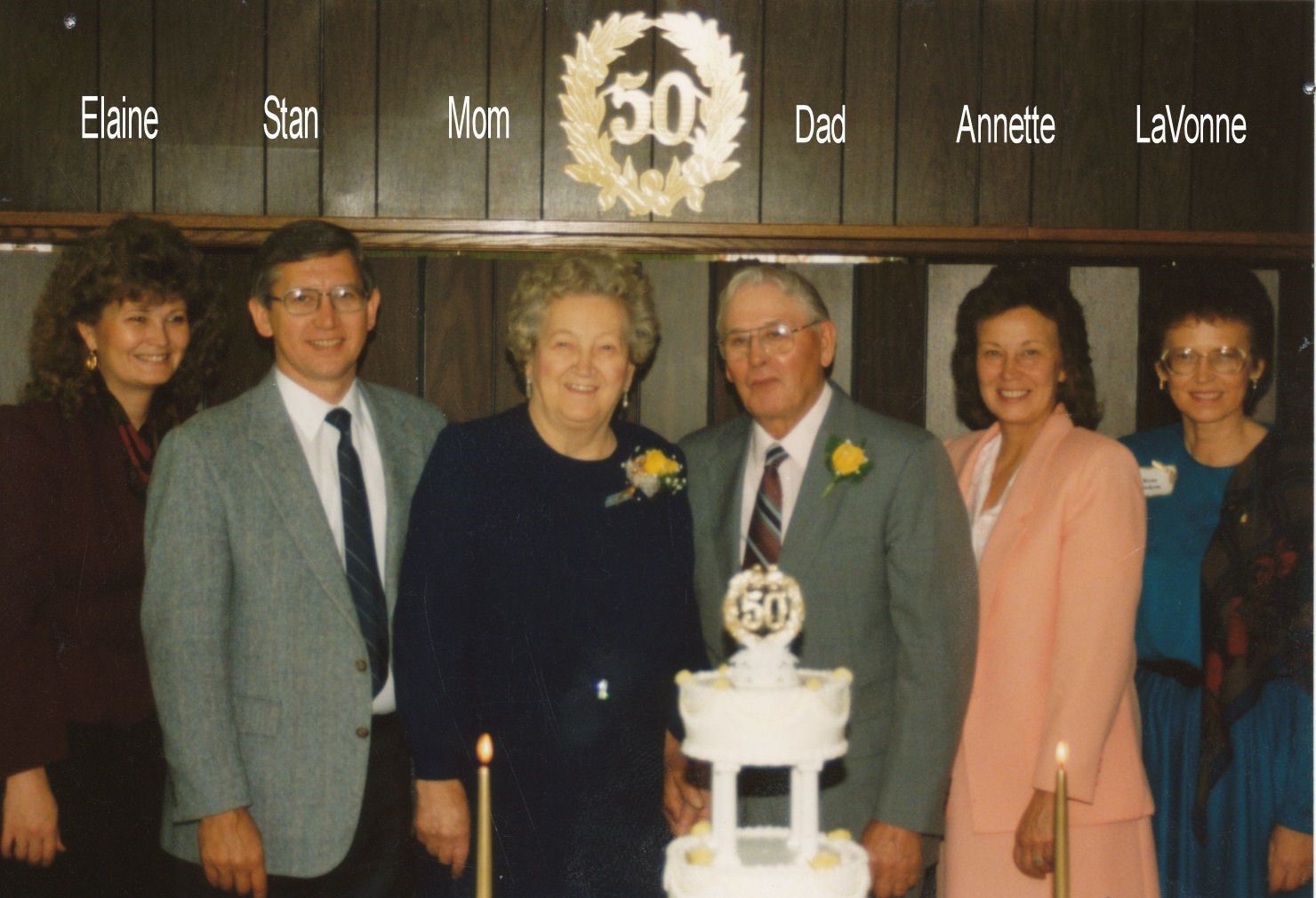
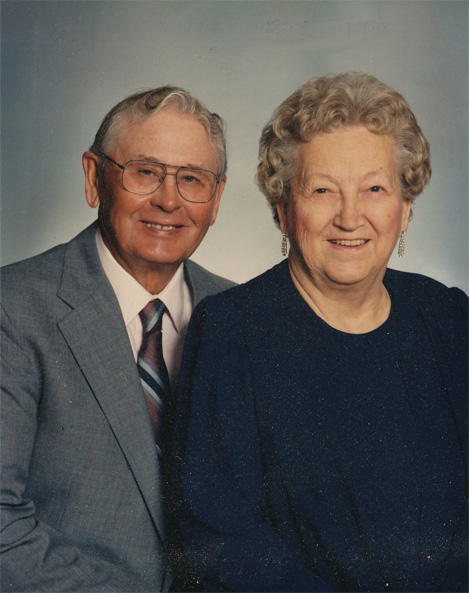
1988 Wilton and Eleanor - 50th Wedding Anniversary


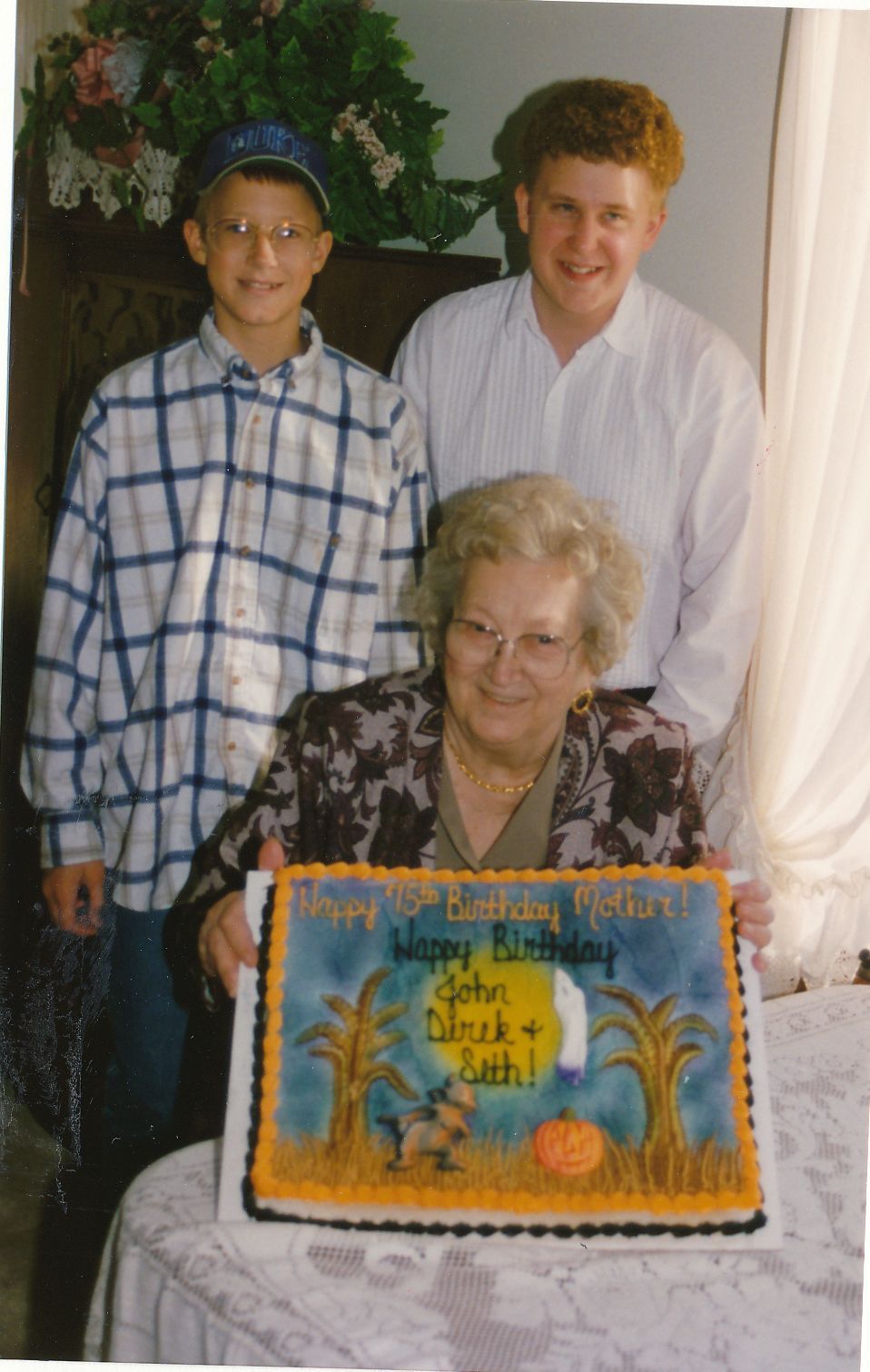
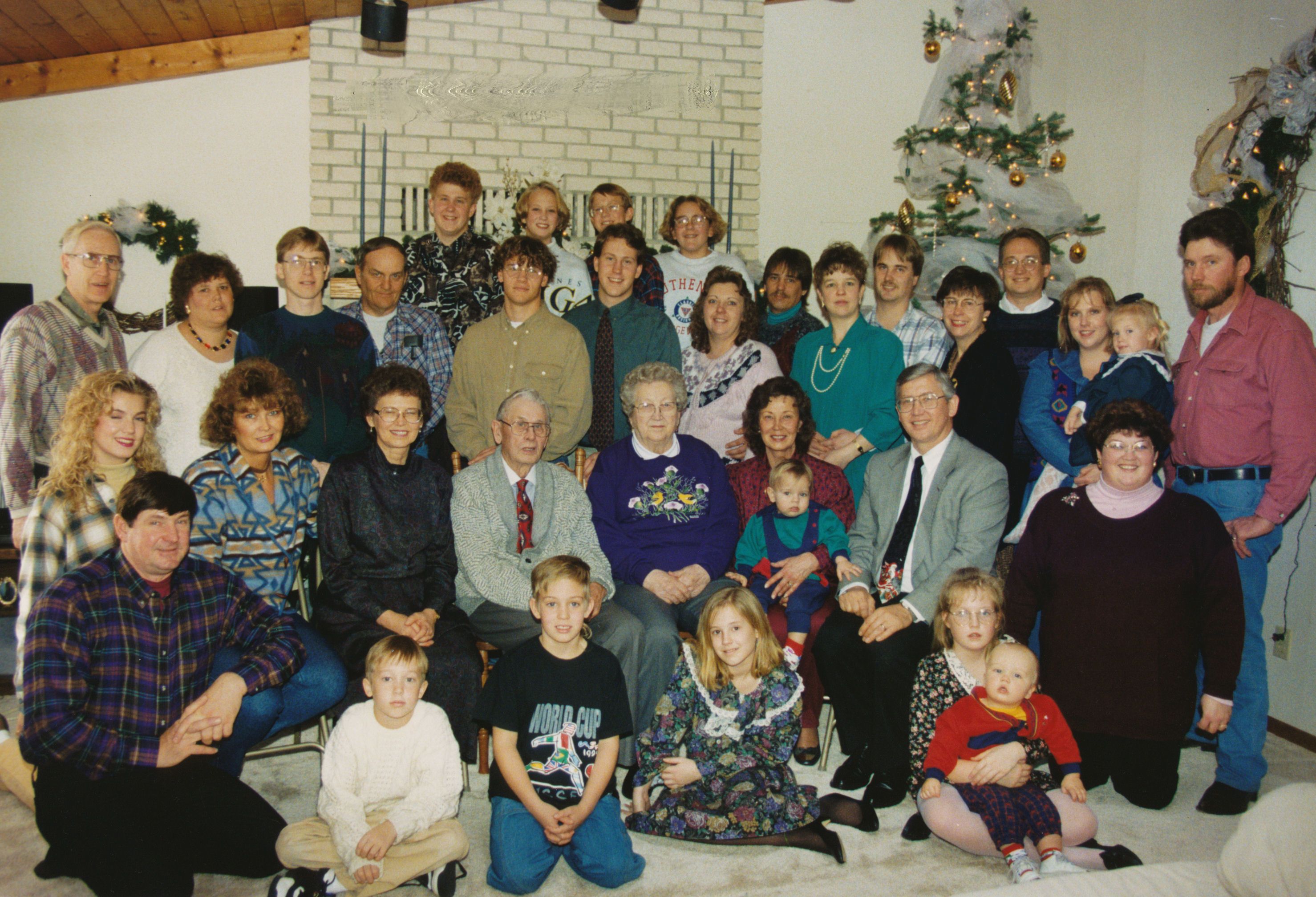
1993 Bomsta Christmas
The 1980’s and 90’s brought them much sadness. Clifton Rasmusson was killed in a farm accident. Wayne Nelson, Charles Madsen, Muriel Bomsta and Clinton Oslund were diagnosed with cancer. In October of 1982 Eleanor had a very painful lung surgery to remove a spot caused by Histoplasmosis at Abbott-Northwestern Hospital in Minneapolis. Wilton stayed with Stan & Gloria in Apple Valley and went to see her every day. Eleanor had two light strokes in February and March 1986. She made a good recovery and resumed her quilting projects for the church and the grandchildren. Wilton has problems with his arthritis from time to time but is in pretty good health otherwise.
After the deaths of their neighbor’s Clifton and Clinton, they would often lend a helping hand to Ethelyde Rasmusson and June & Don Oslund who in turn helped them later when they needed assistance.
Tragedy hit the family again in December 1987 when grandson, Don Schmiedeker was found dead at his home from carbon monoxide poisoning due to a faulty furnace. In December 1990, Wilton was diagnosed with cancer of the stomach. On the same day as his surgery, December 19, granddaughter Mary Beth Gronli was severely injured in a car accident. They were both in the hospital five to six weeks. Mary had a slow recovery from her broken bones. Wilton went through chemo and radiation therapy to cure his cancer. He had a very slow but good recovery and was able to continue with his farming with some help from the neighbors and family. (He remained cancer free for the duration of his life.)
Wilton developed stomach problems again in March 1997. After much testing and a long hospital stay, he had surgery to reroute the bile duct from the stomach to the intestine. During this hospital stay he decided he would be too weak to farm his land. Dean Summerlet rented most of the land to plant in corn and beans. Don Oslund planted a small portion in wheat and alfalfa. Dean Nelson rented the farmland in 1999.
Wilton and Eleanor’s 60th Anniversary Open House was set at an earlier date and combined Eleanor’s 80th birthday. We enjoyed good weather for the party. Many relatives and friends came to congratulate them.
Letter from David Minge, Member of Congress written October 30, 1998 to Wilton and Eleanor.
Dear Wilton and Eleanor:
I would like to extend my personal congratulations to you on your 60th wedding anniversary. This milestone in your lives deserves special recognition. I simply wanted to send my good wishes to you for many more years of happiness.
Again, congratulations of this happy occasion.
Sincerely, David Minge
P.S. I also learned that it is your birthday Eleanor. Happy 80th birthday.
Wilton had a farm machinery auction in 1999.
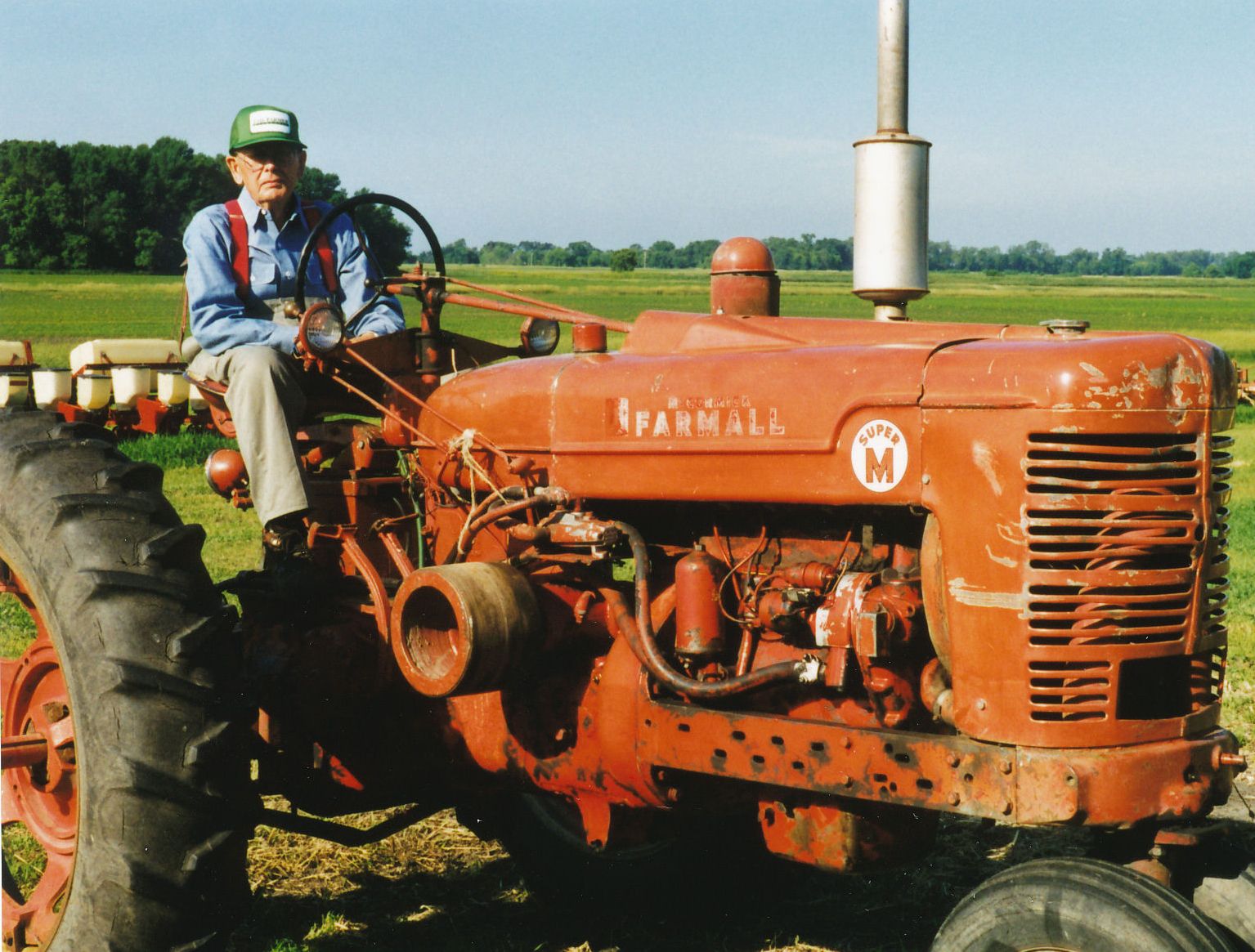
Dad sits on his Super M tractor one last time - Auction 1999
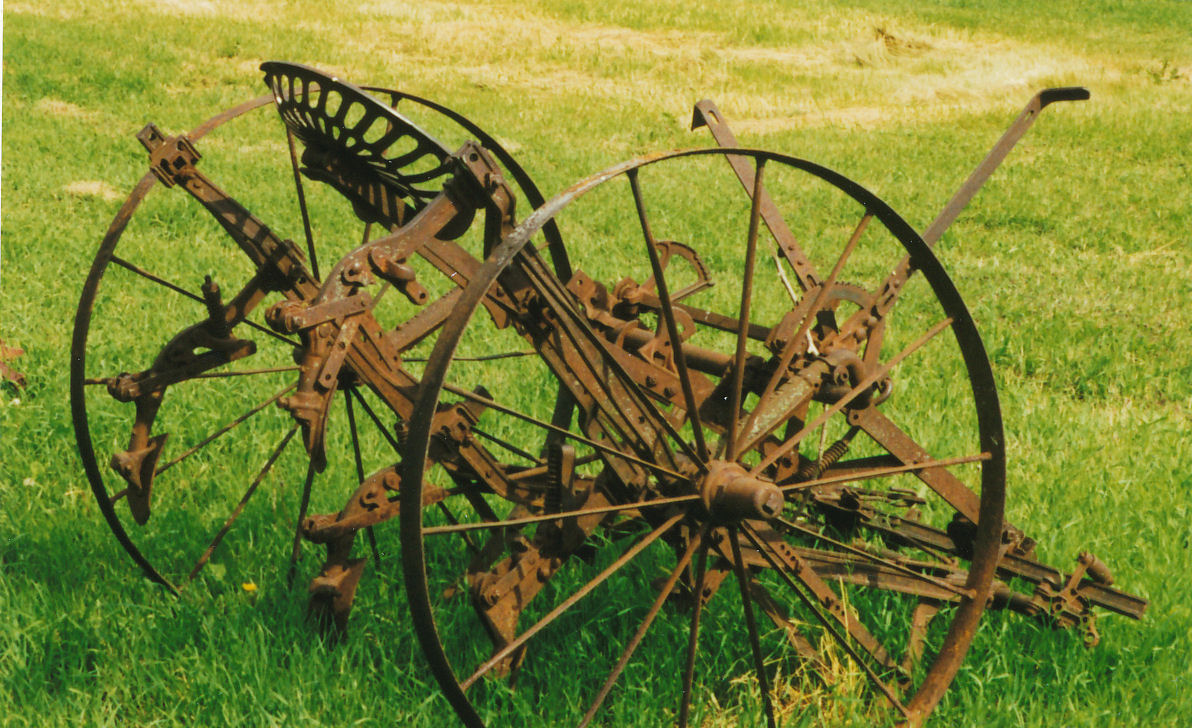

Stan Bomsta and LaVonne Hookom pose
with the old threshing machine in the woods
on the day of Dad's Auction Sale, August 1999.
He sold everything except for a tractor to remove snow. Earl Nelson was good to drive out to the farm and remove snow from the driveway, yard and the roof as needed.
On February 14, 1998, Eleanor fractured her hip. She had to wait for surgery because she takes a blood thinner medication. During the night her heart started to race and had an irregular heart rhythm. She was placed in Intensive Care and later in the day was transported to Methodist Hospital in St. Louis Park, Minnesota by ambulance. She had her surgery on Sunday night and remained in the hospital for about 10 days. Wilton and LaVonne stayed nearby at a motel. The rooms were nice but they only served muffins for breakfast and this just was not acceptable for dad. LaVonne found a Byerly’s on the way to the hospital which served wonderful fresh strawberries and good toasted bread with a hot breakfast. Eleanor was brought to Willmar to stay at Bethesda Pleasant View Nursing Home for her recuperation and therapy. Her leg started to give her pain off and on in 1999. She was hospitalized in January, 2000 and prepared to have surgery for a total hip replacement. The bone had softened and healed again. This caused some deterioration of the hipbone and a replacement was necessary. She spent a few weeks at Cosmos Health Care Center before she could return home.
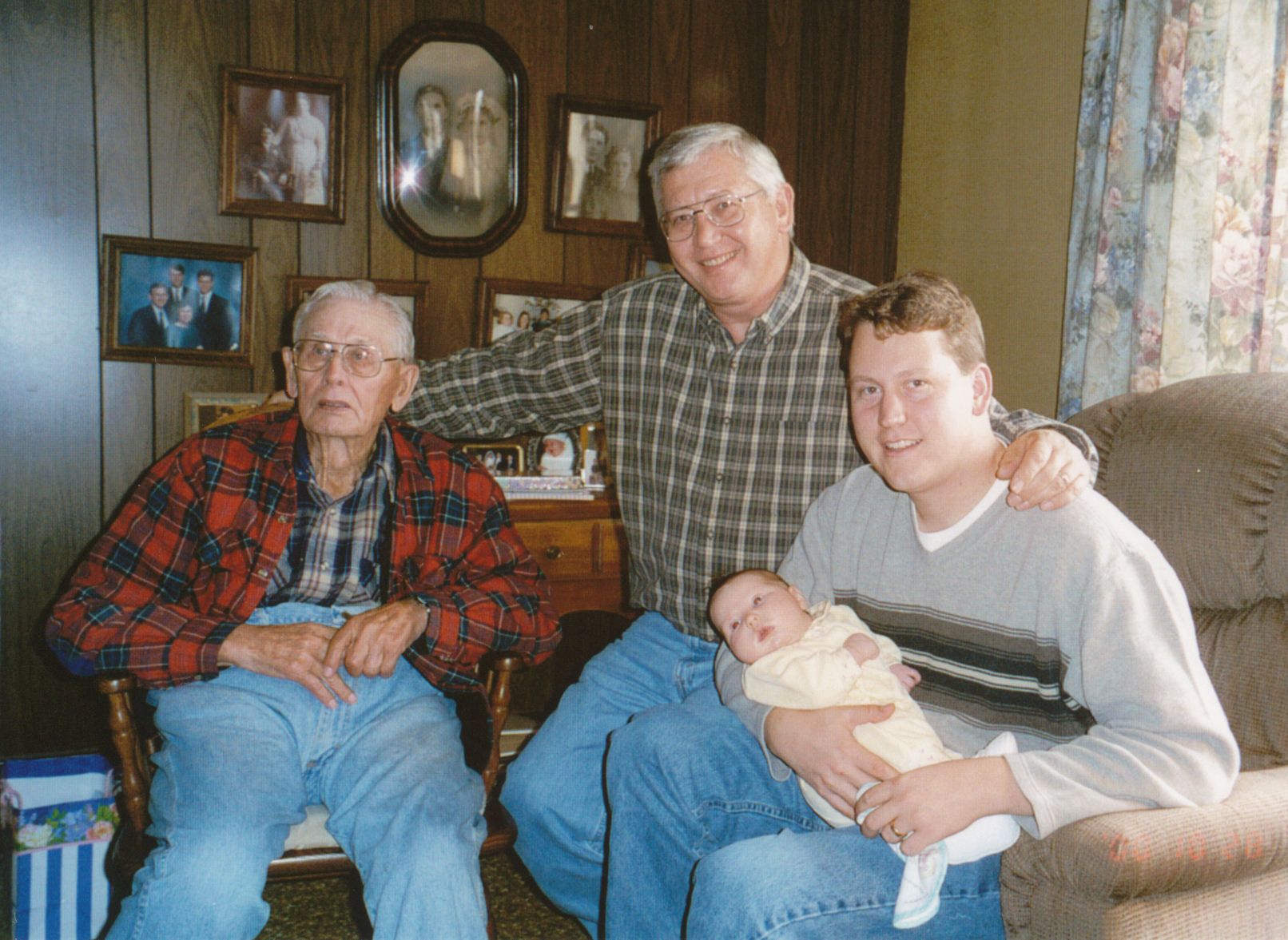
4 Generations. Wilton, Stan, Greg and Maddie Bomsta
A small tornado damaged some buildings and trees in May of 2000. We were all amazed at how nice the crops looked when we celebrated Wilton and Brian’s birthday on July 22 only to be shocked a few days later when a hail and wind storm damaged most of the crops. Two bad storms in one year are too much!

2001 Elaine, LaVonne, Annette and Stan
Wilton was hospitalized for a few days when he became ill in March 2001. After many tests the doctor said he suffered from a virus and dehydration. We were all relieved that no new cancer was found. Violet Madsen came to the farm to stay with Eleanor while Wilton was in the hospital. As they declined in health we scheduled “work days” more frequently. The family came out to the farm prepared to spend the day and do as much as we could on the job list. Even the little children found something they could help with and were proud to be able to help. I think we all rejoiced when they started to hire painters to paint the house and when the insurance company said they could no longer burn wood in their wood burner unless some changes were made
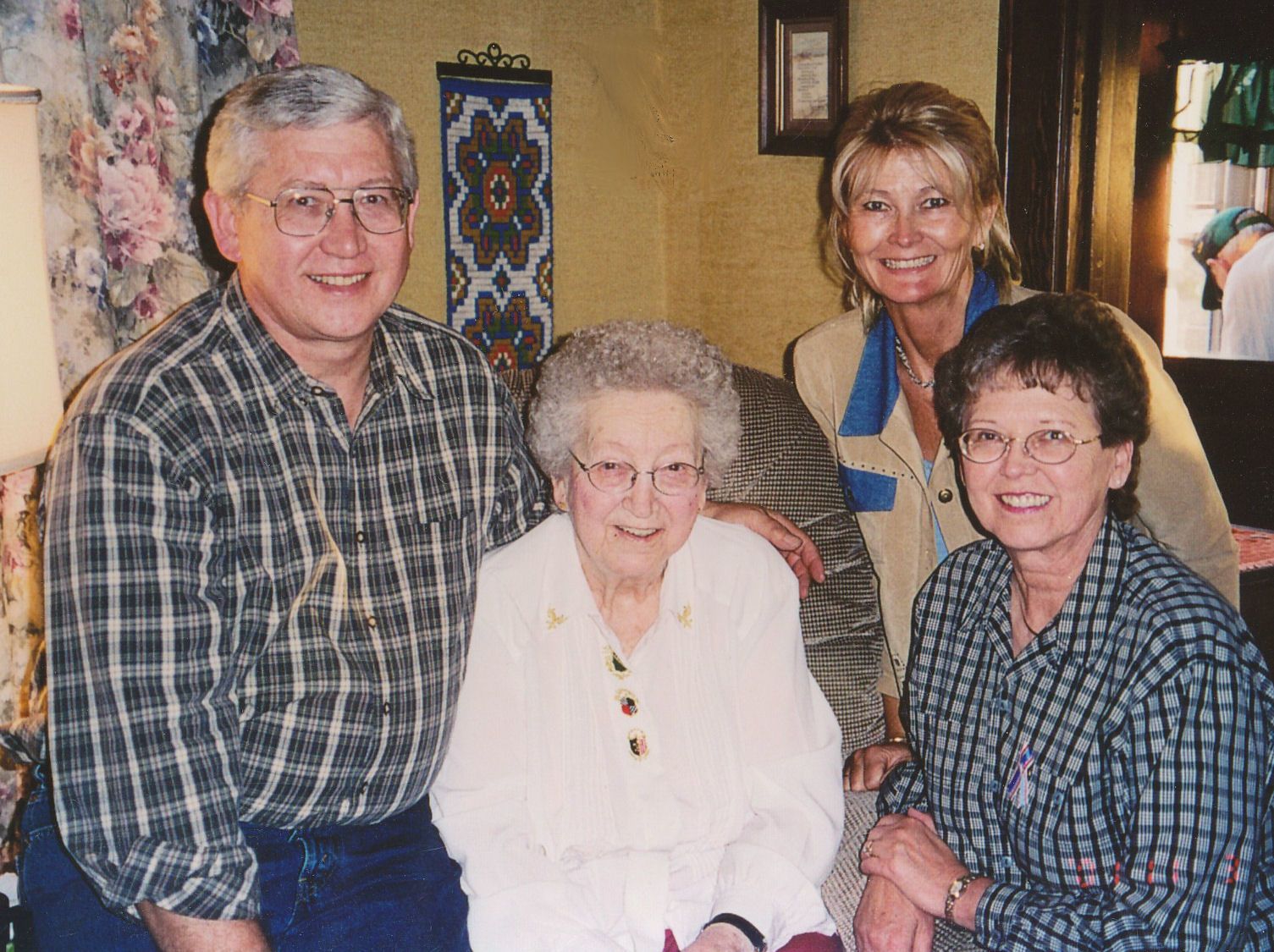
Eleanor birthday Oct. 31, 2001 Stan, Elaine, Mother, LaVonne
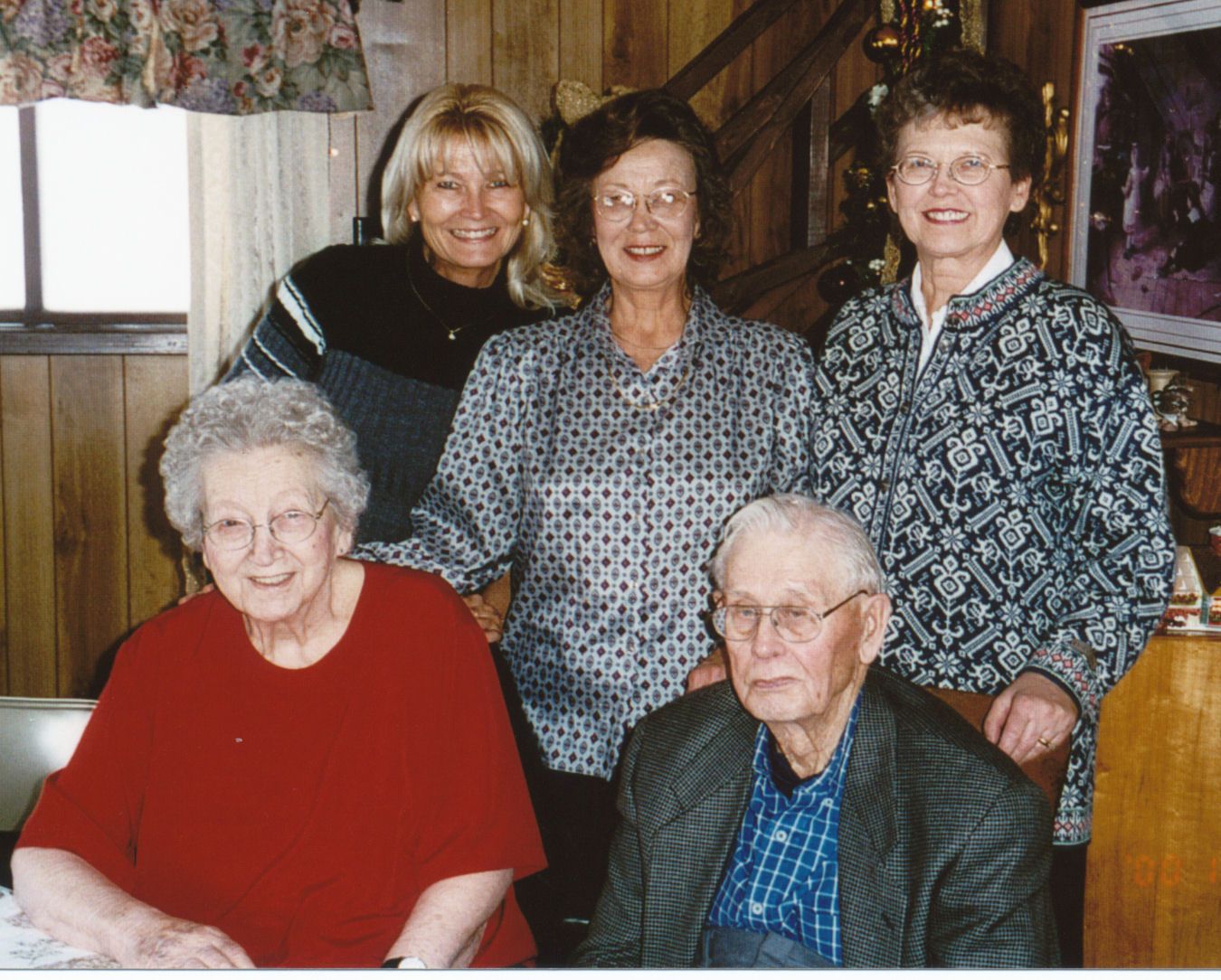
Mom's last Christmas with us 2001. BR - Elaine, Annette, LaVonne, FR - Mom, Dad
Eleanor fell getting up from her chair on January 15, 2002. She was taken by ambulance to the Meeker County Memorial Hospital in Litchfield. She did not have any broken bones and on Monday, January 21 she was transferred to the Cosmos Healthcare Center for Physical, Occupational and Speech Therapy. She had complications due to her diabetes and heart problems. She wasn't able to eat, had trouble swallowing and became very weak and sleepy. On Sunday February 24 she returned to the hospital by ambulance in a snow storm. She had developed a sepsis infection and died on Thursday, February 28, 2002 with many family members by her side. Her funeral was on March 4 at Grace Lutheran Church. She is buried at Tromso Memorial Cemetery.
Eleanor A. Bomsta, age 83, of Lake Lillian, MN died Thursday, February 28, 2002 at the Meeker County Hospital in Litchfield, MN. Funeral services are Monday, March 4, 2002 with Robert D. Johnson officiating. Interment is at Tromso Memorial Cemetery at Lake Lillian. Visitation is Sunday 3-5 p.m. at K-M Funeral Home in Lake Lillian and continues at the church Monday for one hour prior to services.
Eleanor A. Bomsta was born October 31, 1918 at rural Cosmos, MN to George and Lillie (Anderson) Halverson. When she was young her family moved to Litchfield and she was baptized and confirmed there in 1931 at Mission Covenant Church. Eleanor graduated from Litchfield High School in 1936. She then attended Nurses training, afterwards returning to work in Litchfield. On December 1, 1938 she married Wilton M. Bomsta at St. Paul and they have made their home on the farm at Lake Lillian ever since. Eleanor enjoyed reading her Bible and taking care of chickens in earlier years. She was active in Grace Lutheran Church including teaching Sunday School and women’s activities. She was a very loving and supportive farm wife and mother, and thoroughly loved spending time with her grandchildren and great grandchildren. Eleanor died Thursday, February 28, 2002 in Litchfield, MN.
Eleanor is survived by her husband, Wilton her four children; LaVonne (and Robert) Hookom of Willmar, MN, Annette (and Lynn) Schmiedeker of Ottertail, MN, Stan (and Gloria) Bomsta of Woodbury MN and Elaine Gronli of Woodbury, MN; her 11 grandchildren, 13 great-grandchildren, her sister Delores (and Erle) Draxton of Glenwood, MN, her brother Vernon (and Doris) Halverson of Modesto, CA and her sister-in-law Lu Halverson of Apache Junction, AZ. She was preceded in death by her parents, her grandson Donald Schmiedeker and her three brothers Allen, Wesley and Gerald.
Blessed Be Her Memory
These past few weeks have had my mind stirring about the wonderful legacy that my parents have given to their children. We didn't receive fame and fortune, but we have received gifts that have far greater value. We were taught the importance of Christian faith, family and country.
As very young children we were taught that our church was a special place, we had to look our best and were made aware that the church building was God's house and it should be respected. I was given nickels and dimes tied in a handkerchief for my Sunday School offering, which paid for bricks to build this very building. Other offerings went to missions. Dad's cousin was a missionary in Latin America, so we grew up knowing that it important to give to the Lord's work. Mother always helped with youth activities and taught Sunday School for many years. She encouraged me to memorize Bible verses and hymns. While I was sitting quietly at her bedside these past weeks these verses and songs were a great comfort to me as they just came into my head during those reflective moments. Mother's Christian witness was not as verbal as it was by example. Her Bible was always by her chair and it was well marked. She believed in being active in church, kind and helpful to her neighbors and family.
Family was important - we grew up in a house that was filled with family dinners with grandparents, aunts, uncles and cousins as guests. We always celebrated holidays, birthdays and other events with lots of food and fellowship. We have gone thru some dark hours as a family when serious illness strikes, the untimely death of a grandson and other sad times. Somehow mother would receive strength to overcome these burdens by reading her Bible and spending time in prayer.
In 1988, mother and her brother, Wes, recruited me to help them plan a family reunion. I am grateful to them for sparking an interest in Family History, which has provided me with many wonderful experiences. Mother was not a strong person even when she was younger; so most days she had a rest time. This was a favorite time for me because we would read books. This love for reading has been passed on from me to my children and grandchildren. Recently at our Lenten Service the pastor spoke on the 4th Commandment. I was reminded how Mom was a role model to us by honoring her father and mother, George & Lillie Halverson, and also as she cared for Grandpa Henning, Wilton's father, who lived with us.
She was proud to have her granddaughter, Sara Gronli, and her grandson's wife, Kate Bomsta serve our country in the military. We were expected to be good citizens as well as good stewards of our land. As I grow older I began to realize how blessed I have been to have both of my parents for this many years. It has been a joy to be able to spend more time with them after I retired. They have set another good example for all of us with their 63 years of marriage being loyal and faithful to each other and sharing an enduring and steadfast love. Dad has been mother's caregiver for some time. Mother has endured a broken ankle, a couple of strokes, and surgeries for a variety of things and multiple health problems the last 20 plus years. She seldom complained about her plight but as she would say, "She was plugging away." Dad was a devoted husband who came to be at her side day after day while she was in the hospital and nursing home.
Softly and tenderly on Thursday afternoon, Jesus called "Eleanor, come with me" and her spirit fluttered away like a butterfly. Thank you Mom, for everything you have provided for me. Good-bye and I look forward to the day when we will be reunited in heaven.
Dad is doing fairly well. He does break down briefly while talking with friends or neighbors. The planning helped comfort him and the activity of helping Don Boll find the exact burial site was also important to dad. The hospitality of the Grace and Lake Lillian community is emerging with calls and the delivery of an abundance of delicious food.
We all feel blessed to have a mother who took such good care of her four children and hardworking dairy farmer husband. Most importantly she introduced all of us to our Lord and Savior and made certain we attended church at Grace Lutheran. We have fond memories of the services, Sunday School, Bible School, and the wonderful people at Grace.
Each of us has our own memories of our mother. She was able to work so hard at an earlier stage in her life. Mom made five meals a day, took care of a huge garden, usually had chickens, kept her sewing machine busy, canned food, baked, milked cows during the busy harvest season, was involved in church, and raised four children.
Our mom never used anger or harsh words to control her kids. She did have a few words of wisdom to share and did set high expectations. She also was pretty good with that old Scandinavian guilt factor. Mom did not cry often, she could always put a positive spin on life. Even when our crops were destroyed by hail or wind she would always encourage dad and remind him that the Lord will take care of us, and He always did provide. I was a pretty rough and tumble farm boy. My sisters were near perfect or got away with the teasing that didn’t bring out the best behavior from their brother.
Our parents had a tough summer in 1953. I still remember the ambulance ride to Sister Kenny Institute. Mom held me most of the way there and helped me recover from polio by diligently exercising my weakened muscles for weeks and months after I got out of the hospital. That same summer my baby sister had unexplained seizures. She also made a complete recovery. We know that our mother’s prayers were part of the reason our health was renewed.
As you can see we are having many flashbacks about our life and our dear mother and miss her dearly.
I often recall a comment Eleanor made to me after visiting her dad, George, at the Cosmos Nursing Home. I noticed he didn’t recognize her. She said “It wasn’t important. I just came to make him smile and bring some joy in his life!” I also remember long conversations with Eleanor. She was very interested in your life.
What is love??
Love is taking care of most every need of your soul mate for the last 5 years of their life.
Love is going to see her in the hospital or nursing home every day even though it hurts to sit in an uncomfortable chair and eat institutional food and let your household chores slip into oblivion.
Love is doing everything you can imagine or dream of to get her back on her feet so you can be together in the home you were born in and have lived your whole life in.
Love is crying your eyes out after her last breath and wanting everyone to be together to mourn and grieve and give one another support at the time of the celebration of her life.
Love is going up to see her body for the last time on earth, holding the hand as you remember the precious sweet times you both shared together, and bend over and kiss her on the lips and bid her a sweet farewell.
Love is sitting in her chair because you can’t stand to see it empty.
Love is letting her go to be with Jesus and having the hope of being united with her again for eternity.
Love, Mike
My Grandma Bomsta (Eleanor) was the world’s best Grandma! She always knew the right thing to say and most importantly at the right time. I always felt loved and important around her. She had a sparkle in her eye as she would tell me stories or patiently explain answers to questions I had about things whether it be about the farm, things I had heard or saw that day, what was for lunch, dinner, or snack (important topics for young boys). I remember the experience of picking potatoes from Grandma’s garden to get ready for the meal later that day that we would all eat together. I remember being proud of the first time I was big enough to help till Grandma’s garden with the rotor tiller. I was fortunate to spend a week each summer with my grandparents growing up and that time is both cherished and treasured. It was on those extended stays that we got to know each other better and had the opportunity to enjoy life on the farm. I’m sure now as an adult and thinking about what us kids were like at the time that we must have given our Grandma & Grandpa Bomsta quite the laugh each night before bed. I like to imagine the conversation went something like this “Do you know what little Giggy John said today….” Or perhaps it was “You should have seen little Eliseus…..” followed by a good chuckle. I remember as a teenager seeing a picture of my Grandma that had been taken when she was in her mid-20’s to early 30’s, her sense of style and fashion and the quiet confidence that she portrayed was a powerful memory. Having a Grandma like Grandma Bomsta is and was a splendid thing. I will always remember her for her loving way and thoughtful questions as we would talk about things in our lives and the peace I felt during those talks.
I miss my Grandma, but I know she is with me and I know that she and Grandpa are in heaven together which gives me great comfort. Sometimes I wonder if they are still farmers in heaven or if perhaps they switched professions – but something tells me that no matter what, that they still have coffee guests and that they are making everyone around them feel loved. Love you Grandma Bomsta!
*********************************************
Dad’s grief journey began with several bumps in the road. On March 22, 2002 he fell and was in the hospital a few days. He was bruised and sore but made a good recovery. After this hospitalization he decided to switch to a doctor in Willmar. LaVonne set up an appointment with Dr. Kendall Bos. Wilton had seen Dr. Bos one time before he became sick with pneumonia. He was hospitalized at Rice Memorial Hospital in Willmar on May 8, 2003. After a few days he was transferred to Rice Care Center for physical therapy and recuperation. His heart went into atrial fibrillation, which requires him to be on Coumadin to thin his blood. He went home to his farm on May 24.
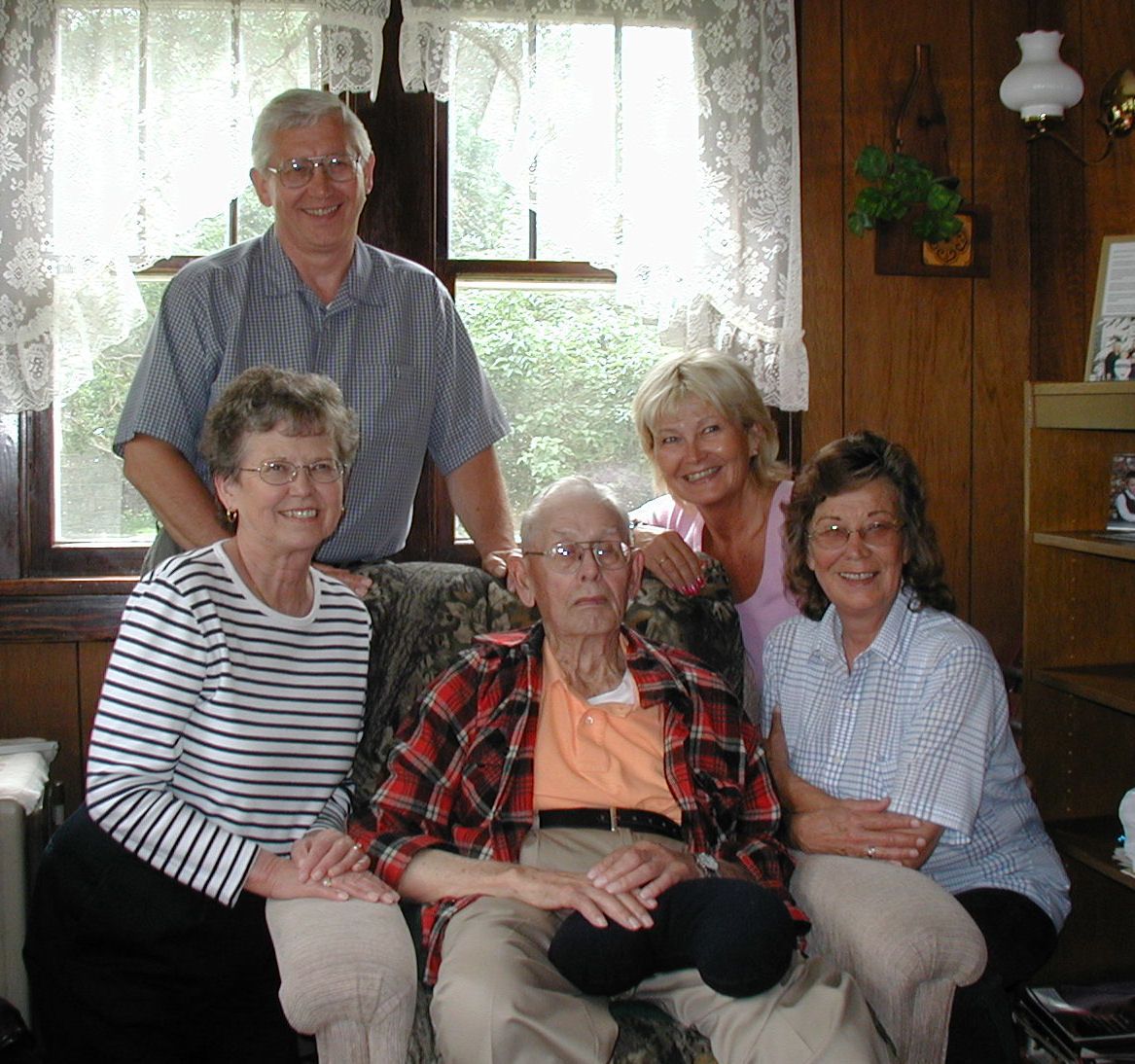
2004 - Father's Day - Stan, Elaine, LaVonne, Dad, Annette
Dad became ill again and was taken by ambulance to Rice Hospital on November 22, 2004. After a few days he was transferred to Rice Care Center again. After this siege of illness he was a high risk for falling, the doctor and therapists didn’t want him to drive anymore or go outside by himself. They also recommended that he have Home Health Care. Spectrum Community Health was hired plus he wore a Health Watch button. On December 14 he returned home and had to accept many changes. Dad didn’t think he would like having “helpers” come to his house to help him with cooking, cleaning, bathing, etc. It didn’t take long before he realized that he enjoyed having someone come each day. They would chat about all kinds of topics. The kids and grandkids pitched in to help with many tasks to keep dad on the farm. He didn’t go out much during the winter. Arrangements were made to have the mail and newspaper brought to the house. Dad missed driving but later said how nice it was to get into a warm car with whoever was his driver. Mike brought him to Calvary for the Dec. 23 Norwegian Service which he had wanted to attend for a long time. Dad enjoyed listening to the Norwegian language and the treats served after the service. Stan and several grandsons would go pick him up for family events
This was a difficult time of transition for dad but he was elated when Kate and Lyle told him they were expecting a baby in 2005 and if the baby was a boy, he would be named after him. He was one proud great-grandpa when the news came that the baby was a boy. Lyle and Kate came to the farm for a visit after little Wilton was born. Dad held him and said “I think the child likes me”.
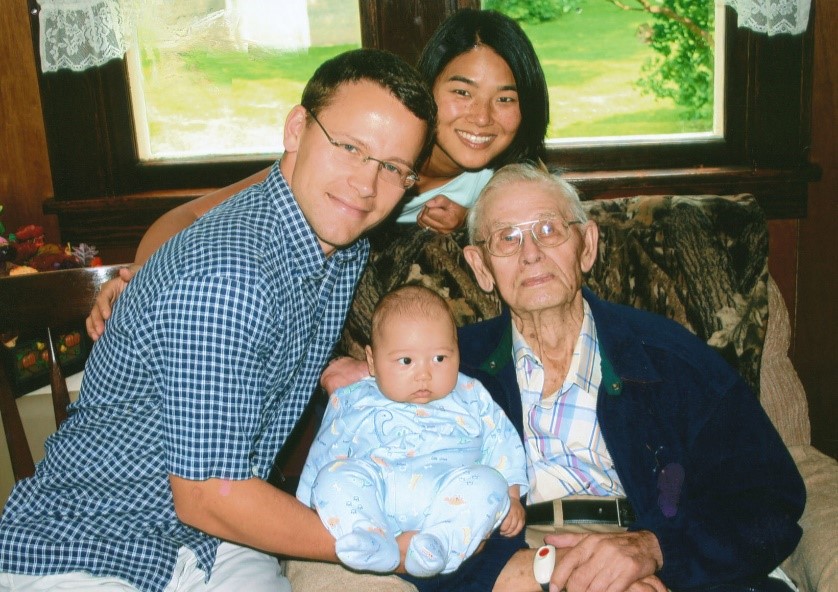
Notes from Kate: When Lyle and I found out we were pregnant it was around the time Wilton was getting ill and we had this sense of urgency to tell Wilton that we wanted to name our child after him. Of course we had NO idea if we were having a boy or girl and Lyle and I joked around how premature we were by telling him this.
When we broke the news to Wilton the family joked about our impending inheritance going up but it was all in good fun. Wilton was sitting in his chair and Lyle and I told him and he didn't have much of a reaction. Later we learned how proud he was from Stan and Gloria. He always said to them, during my pregnancy, I know she's having a boy I can feel it.
When the two Wiltons met again in September it was fun. Although Grandpa Wilton was in the hospital he let great grandson Wilton crawl all over him and eat his hospital food. It was so fun to watch. He thought he was a husky baby, and he was right Wilton was and is a husky baby/boy.
He tried to stay well but he became sick again in April. Once more he was a patient at Rice Hospital with pneumonia and dehydration problems. This time he went to Bethesda Heritage for his recuperation and therapy. This was a wonderful place for him. He went back to live at the farm on June 6.

2005 - Birthday - Stan, Annette, LaVonne, Dad, Elaine
On July 25, 2005 dad was admitted again to Rice Hospital with his stomach problems. He remained stronger this time and he thought he could manage if he could return home to the farm.
The barn was torn down in 2005
Annette and Dad watch the barn come down - a very sad day!
He became afraid to be alone and after a few days we made an appointment for him to check Alterra Sterling House which is an assisted living facility. Dad thought it was a very nice place. LaVonne and Annette made the arrangements and the next day Stan moved him into Willmar. This meant downsizing but he was content. The staff was very friendly and kind to him. They served a large, hot breakfast and cooked real potatoes which he enjoyed. His room faced the street, he could watch cars and busses coming and going from Roosevelt School. He also knew who was coming to see him before they entered the building.
His health problems recurred and he was back in the hospital the end of September, 2005. The doctors didn’t think he would make it. He was too weak to go through the required tests and scans which meant that surgery was out of the question. A family meeting was set up early one morning with the doctor and the children. The day before this meeting, we were with him and feeling very sad that nothing could be done to get him well; we were giving him permission to die, reassuring him that we would be OK and kept telling him we didn’t want him to suffer, etc. He didn’t like our answers and was very relieved when Sara told Grandpa that she didn’t want him to die. The next morning we had to wake Dad at 7 AM for our meeting which is unusual. Dr. Bos went over the options again and dad looked him in the eye and told Dr. Bos that he was going to get well and get out of the hospital and he did! He spent a few weeks at Rice Care before he could return to Alterra. He was able to enjoy getting out at Thanksgiving and Christmas for the family celebrations.
He was admitted to Rice Hospital again the end of January, 2006. Many tests were performed and every effort made to get him back on his feet. This time he lost his will to fight and get well. He was able to move into Bethesda Heritage Center to the Transitions Unit across the hall from his son-in-law, Bob Hookom who was very ill with a rare lung disease.
Bob died on March 6 and one month later the call came that Dad was slipping away. LaVonne, Annette and Stan were with him when he took his last breath and went to heaven to be with Jesus. He died on April 8, 2006. The funeral was held on April 12 at Grace Lutheran Church. He was buried next to his beloved wife at the Tromso Memorial Cemetery. (Dad’s funeral was the last one held at Grace before they moved to the south end of town and became United Lutheran Church. He and Deloris talked about how they hoped they would die before the move came so that they would have their funeral at Grace.)

Wilton - the happy farmer
Wilton M. Bomsta, age 88 of Lake Lillian, MN died Saturday, April 8, 2006 at Bethesda Heritage Nursing Home in Willmar. Funeral services are Wednesday, 11:00 a.m. at Grace Lutheran Church in Lake Lillian with Rev. Art Wiese officiating. Interment is in Tromsø Memorial Cemetery at Lake Lillian. Visitation is Tuesday 5-7 p.m. at K-M Funeral Home in Lake Lillian and continues at the church Wednesday for one hour prior to services.
Wilton Malcolm Bomsta was born July 22, 1917 on the family farm in Lake Elizabeth Township, rural Lake Lillian, MN to Henning and Hattie (Flann) Bomsta. He was not only raised on this farm, but was blessed to live there his entire life. Wilton attended School District #43, rural Lake Lillian, and then assisted on the family farm. On December 1, 1938 Wilton married Eleanor A. Halverson at St. Paul, MN and this marriage was enriched by the birth of their four children. Wilton and Eleanor farmed together for many years and also had dairy cows, hogs and chickens. Wilton served on the School Board, the Lake Lillian Creamery Board, and as a member of the Tromsø Memorial Cemetery Board for 20 years he had helped dig many graves by hand. He was a faithful and active lifelong member of Grace Lutheran Church where he had ushered for 37 years and served on several Boards. Eleanor and Wilton enjoyed going for drives to check on the crops and their hospitality was marked through their sharing of meals and conversation with neighbors and friends. Wilton’s faith and sense of community was evident in his encouraging all to attend church, and to vote, and he truly believed in justice for all. Wilton’s children fondly remember the great joy he found in spending time with his family.
Wilton is survived by his four children; LaVonne Hookom of Willmar, MN, Annette (and Lynn) Schmiedeker of Lake Lillian, MN, Stan (and Gloria) Bomsta of Woodbury MN and Elaine (and Brent) Hogberg of Maplewood, MN; his 11 grandchildren; Mike (Jeanie) Hookom, Brian Hookom, Ross (Sheryl) Hookom, David (Kathy) Schmiedeker, Cheryl (Earl) Nelson, Greg (Ruth) Bomsta, Lyle (Kate) Bomsta, Mary (Jamie) Hagen, Derek Gronli, Sara Gronli and Seth Gronli and his 16 great-grandchildren; Nicole and Emily Hookom, Amber and Andrew Hookom, Zachary, Amanda and Benjamin Hookom, Kerin Christiansen, Adam and Matthew Schmiedeker, Maddie and Margaux Bomsta, Wilton Bomsta, Cole and Katie Hagen and Matthew Gronli, his sister Deloris Nelson of Willmar, MN, his sister-in-law Gerry Bomsta of Bird Island, MN and several nieces and nephews. He was preceded in death by his parents, his wife, Eleanor, his son-in-law Robert Hookom, his grandson Donald Schmiedeker and his three brothers; Harlan Bomsta, Emery Bomsta and Orville Bomsta.
Blessed Be His Memory
At our wedding, Mike gave me a long enthusiastic kiss, and grandpa leaned forward and whispered to Mike’s parents “he kisses like his grandpa.” Grandpa always had questions about our lives in Illinois, most of all making sure I was taking care of his oldest grandson.
He was all about family; the steadfast love he had shown to grandma will never be forgotten. He was a man of devotion and was sincerely dedicated to her.
We will miss you sweet grandpa – rest and peace to you, love, Jeanie
My grandpa Bomsta (Wilton) was one of the greatest people I’ve had the pleasure of knowing. His abilities to set people at ease, enjoy their company, listen, do whatever it takes to help, and to provide sound advice are just some of the talents that I think made him a great man. His love and enthusiasm for his wife Eleanor, his kids, and grandchildren was unsurpassed and unwavering. The sense of community he had for his neighbors and friends was strong and something I noticed even when I was a young child. My grandpa always made me feel safe, welcomed, valued, cherished, loved, and could make me laugh no matter what was going on in my head over the years as I grew up in front of him. Through his actions, words, and deeds he instilled many valuable traits in my person that I think have helped me personally and professionally. I am a better person, father, and husband because of his influence on my life. These are some of the reasons I call him one of the greatest men I’ve ever known.
I am very proud and thankful that he was part of my life. He will be missed and it gives me great comfort that in many ways his love and spirit will continue through the many people he has touched in his 88 years on this planet. Love you Grandpa! Gregory John Bomsta
One of my fondest memories of grandpa was, as a child, riding on the tractor while plowing the field. I remember grandpa describing a few things or giving directions but you couldn’t really hear because of the noise of the tractor, but grandpa was smiling. I remember watching in amazement the movement of the black soil being overturned by the plow, the brisk air and sunshine. I remember holding on tightly.
I have many more memories of the farm, family events, the hayloft, and riding in grandpa’s pickup holding on as grandpa would rev the engine and laugh.
Yes, I remember fondly when I first met Wilton and Eleanor. They took Lyle and I out for dinner at the new restaurant. First Wilton tossed the car keys to Lyle and Wilton and I sat in the back. He cracked jokes the whole drive there (5 minutes). His sense of humor was dry but very sharp. He teased Lyle and asked if he fed me and if he took good care of me. At the restaurant I had some shrimp and we had a good laugh at how he made me shrimp for our first meeting. Every once in a while Grandpa Wilton would call us in California --- very early -- 6 or 7 am California time so 8 or 9 am Minnesota time. Lyle always said he knows what time it is here. He just thinks we should be up - which we always were. If I answered the phone he just simply asked for Lyle. His conversations with Lyle were very short but it was cute to receive a call from him checking up on us. Throughout the years Lyle has always shared with me how much he respected his Grandpa Wilton and how he felt they had much in common. He loved his sense of humor, his knack for nicknames, just as Lyle does, and his strength and determination.
I have many good memories of my great grandpa Bomsta. Probably one of my favorites would have to be going to his farm and driving his pickup truck through the field roads. I can remember that every time I would ask him if I could drive it or every time I would go back inside and tell how good I drove and to say thank you he would always have the biggest smile on his face. He would always call me Speedy; he also named a field road after me. He called it ‘Emily Road’. He loved it when I drove his truck. And so did I. That would always be the first question my parents would hear, “Do I get to drive grandpa Bomsta’s truck when we go to the farm?” I also remember his great humor. He would always make me laugh. Another moment I will never forget was when I would feed him dinner/lunch at Bethesda. It made me feel proud that he would eat more when I would feed him, than when the nurses would feed him. So every chance I could get while I was there, I would feed him. There never was a doubt in my mind, that I loved my grandpa and spending time with him. I will always miss him.
We often came home from school to the smell of freshly baked delicious brown bread made by mom while we were gone. What a treat! As Mom aged it became too hard for her to mix and knead the dough, she used frozen bread dough which tasted good and smelled wonderful when it was baking. She also baked a variety of cookies, bars, cakes and desserts. Donations of food were brought to church regularly for pot luck dinners, circle, Ladies Aid and Luther League. Later she brought food for the chicken supper the church had each fall as a fund raiser. Food from the garden needed to be canned or frozen, she was happy when her brothers, Wes & Vernon lived close enough to come out and help clean the garden. Emery also came to the farm to help after he retired. Dad was always anxious for the first meal of new potatoes. We grew up eating butter and whipped cream on everything. If Mom needed a quick dessert, she would sandwich canned peaches or apple sauce between two graham crackers and top with whipped cream. She made wonderful chicken. First she browned it, made gravy from the drippings and then slowly baked it. I remember how Mom was always willing to entertain relatives who were celebrating a birthday or had an event at church and needed a place to continue the visiting afterwards. Grandpa Henning lived with us so we often had extended Bomsta relatives visit the farm. As her health declined she would recruit her children to help. She liked hosting people at the farm. To have kids playing on the yard was a delight for her.
Another favorite thing for her was to feed and watch the beautiful birds that came to her feeders. She loved to read novels about the pioneer women and their struggles. She kept up her Bible Studies and would have her church circle meeting at the farm every month after it became too difficult for her to do steps. Dad would cook coffee and the ladies all brought some goodies. When she could no longer quilt, she contributed money for the quilting supplies at church.
She enjoyed going to Shorewood for Zach’s birthday parties in October and viewing the lovely display of fall colors on the trees along Highway #7 as we approached the cities.
She was happy and content with the simple things in life. After writing this story and thinking about how hard she worked it is no wonder when her body started to wear out, she enjoyed spending the day in her reclining lift chair with her feet elevated.
Many people have told me or have written e-mail messages or letters telling about the good experience they had coming out to the farm to help with baling hay. They felt Wilton taught them how to become good workers and somehow they thought the job was fun and they looked forward to the meals Eleanor was preparing for them plus all the ice cream they could eat!! Rick Nordin wrote these words on his sympathy card sent to Dad when Mother died. Wilton – “Just want to let you know we are thinking of you during this difficult time. You truly are an inspiration to all who know you.” Faralyn and Allan Erickson, Willard Elliot, Larry Hanson told Wilton nice things about working on the farm and ways he helped them when they were young. Wilton taught them to be good workers. The Erickson kids were appreciative of their help after their mother died at a young age. Mother helped them with their 4-H projects whenever they needed assistance and guidance.
Bob and I drove them to many family events. Sometimes, Maurice, Deloris and Verna came along. It was always a good day visiting with family. We stayed overnight at Stan & Gloria’s when Greg graduated from Augsburg. Mom & Dad would be exhausted when they got home but I always appreciated the fact that they would make an effort to go. I started driving them to doctor appointments in 1990 making numerous trips plus the driving during hospital stays.
After Mom died, Dad still would like to attend the grandkids birthday parties. We usually combined a trip to visit Harlan in Andover before the party in Elk River. He was able to attend Stan’s Retirement Party and Andrew’s graduation party. He enjoyed riding along looking at the crops, new cars & trucks.
Dad required a monthly blood check after he started taking Coumadin for a few years before his death. I would drop him off and go to park the car and when I got back in the clinic, he was usually ready to leave. He liked the fast service! He enjoyed talking with a couple of the nurses who had Lake Lillian connections. During the summer we would stop at Culver’s for a delicious strawberry sundae. This was a good outing for him. I heard him tell many people that “I never give up” and with this good attitude he was able to recover from many serious illnesses.
Bob and I would bring dad with us to church at Calvary after he moved to Willmar. It was easy for him to walk with his walker from the front door. We sat in the overflow area on chairs which was more comfortable than the pews and people can hear well in this area. The pastor and assistants bring Holy Communion to the people who have trouble walking up front. I have nice memories of dad extending his hand to receive the sacraments. One time I noticed a tear flowing down his cheek.
Annette & Lynn moved out to the farm to live after dad moved to Willmar. Lynn died in December, 2006. Annette found the farm place to be too far from her children and she felt isolated living alone out there. In 2007 she bought a cute house in Spicer. The farm site was sold to Kyle Whitcomb in May, 2008. We had already sold the productive crop land to Dean Nelson and Harlan Madsen. We still have some acreage in CRP.
We all miss the numerous fun gatherings out at the farm during the summer & fall. Maybe it is the people we miss more than the place.
As a young boy I remember all the Christmas’s with all the “Bomstas” (Henning’s whole family) with a house full of adults and kids. I don’t know how we all fit, but we did. There was always laughter and good stories and good food to share.
As a kid it was fun to stay out at the farm to work, hopefully drive the tractor (it seemed as though there was a price to pay- hard work, before we could get the reward), and play if there was time. There were the woods, old cars and tractors, the barn, granary and corn bin to explore and pretend play in. And when by chance we ever got injured, we got an application of “black salve” to heal our hurts. When we would stay in the winter, there would often be frost on the walls of the west bedroom in the morning, but we would be warm under grandma’s quilts (3-4 to a bed David, Don, Brian and myself). We would always wake up to the wonderful smells of grandma’s hearty farm breakfasts. Grandpa Henning always had his eggs poached. Grandma also baked the best homemade breads (white and dark) which she always loaded up with strawberry jam. Grandpa tried to keep us busy and use up our youthful energy. He was a good teacher and was usually very patient with me (all the Grandkids). He taught us all to work hard and do the best we can and to treat the land responsibly. It seemed most farm people used a lot of colorful language. I don’t remember him using any except when the cows weren’t co-operating, and even then it was not that bad. His walk was a very slow paced, but steady gate. I think he had foot problems and wore special shoes. I was amazed at how fast he could move when he had to chase or corral a cow or even scarier a bull. I used to get homesick after a couple of days to the point of being nauseous, and my parents would have to pick me up. I did grow out of that thankfully.
Grandpa had nick-names for everyone except my mom, and all the cousins used to argue about who grandpa would call “Barnsmell” as that would be his favorite grandson that day. It changed all the time as there were no favorites – he had no favorites, he treated everyone the same, but wanted us all to feel special in his own way. He would have us sit on his lap and he would tease us and ask a million questions. Then when we grew impatient and try get away, he would wrap his legs around us and have us in the “skunk trap”. I recently noticed that I find myself interacting with small children the same way, and they love it. Grandma always snuggled us and loved us, too. She would always have treats (cookies, ice cream, etc.) for us. She always cautioned us that “if we ate too much, we would get a belly ache.” If we were there on Sunday, we would go to church with them and go to Sunday school in the basement with Grandma as she was in charge of that at Grace Church. I remember when we all came out to Grace as adults for their 50th wedding anniversary and filled a pew or two. Grandma was overwhelmed with tears of joy. That was one of the only times I saw her cry.
One summer when I was early 20’s, grandpa needed help baling hay, so Jeanie and I went out to help. Grandpa was about 60-65. He drove the tractor, I don’t remember who was pulling the bales out of the baler, but I was up high stacking them on the wagon. We hit a rut in the field which jostled the load, and a few bales under me gave way and I fell off the front of the wagon and was almost run over by the wagon. After we all settled down, he had me drive the tractor and he did all the “young man’s work.” As an adult, they always had little projects to help out with around the house. They were very loving and accepting people, even though they had what some would say a very narrow world view with very specific values and opinions. Hospitality and respect were very important to them.
One of the few times he ventured out of the state, he was able to join us for our wedding. He loved being there on our wedding day. On Sunday morning after the wedding, everyone was going to head back to Minnesota. He was all ready to go at 5:00 am and wondering where is everyone – we have to get going!
I was also able to know my Great Grand Parents before they died. Henning always told us stories about politics or neighbors. He would not drink the water in Willmar because it had poison in it. He talked a lot and bought us 3 Musketeers bars when he came home from town if we were out at the farm. He had a 1963 Ford Galaxy 500 that he drove around in (quite slowly I might add). We (cousins) would drive it around the yard sometimes when no one was home. The Halvorson’s always had bottles of Pepsi for us. It was a treat as pop was not always served like it is today. Cool-aid or “nectar” would be what was served.
Growing up in the 60s and 70s the farm was headquarters for the Bomsta clan. Most of the Holiday parties were located there as well as birthday parties for Wilton and Eleanor. It was a great place to spend time with family. There were many things done at the farm that I may not have experienced otherwise. I have many memories of staying at the farm in my youth. I feel fortunate to have gotten a taste of farm life that many people never get.
Grandpa Wilton’s birthday was a special day for me, it was also my birthday. We were at the farm celebrating his birthday when man landed on the moon July of 1969. My parents always made sure to get a picture of the birthday boys together every year.
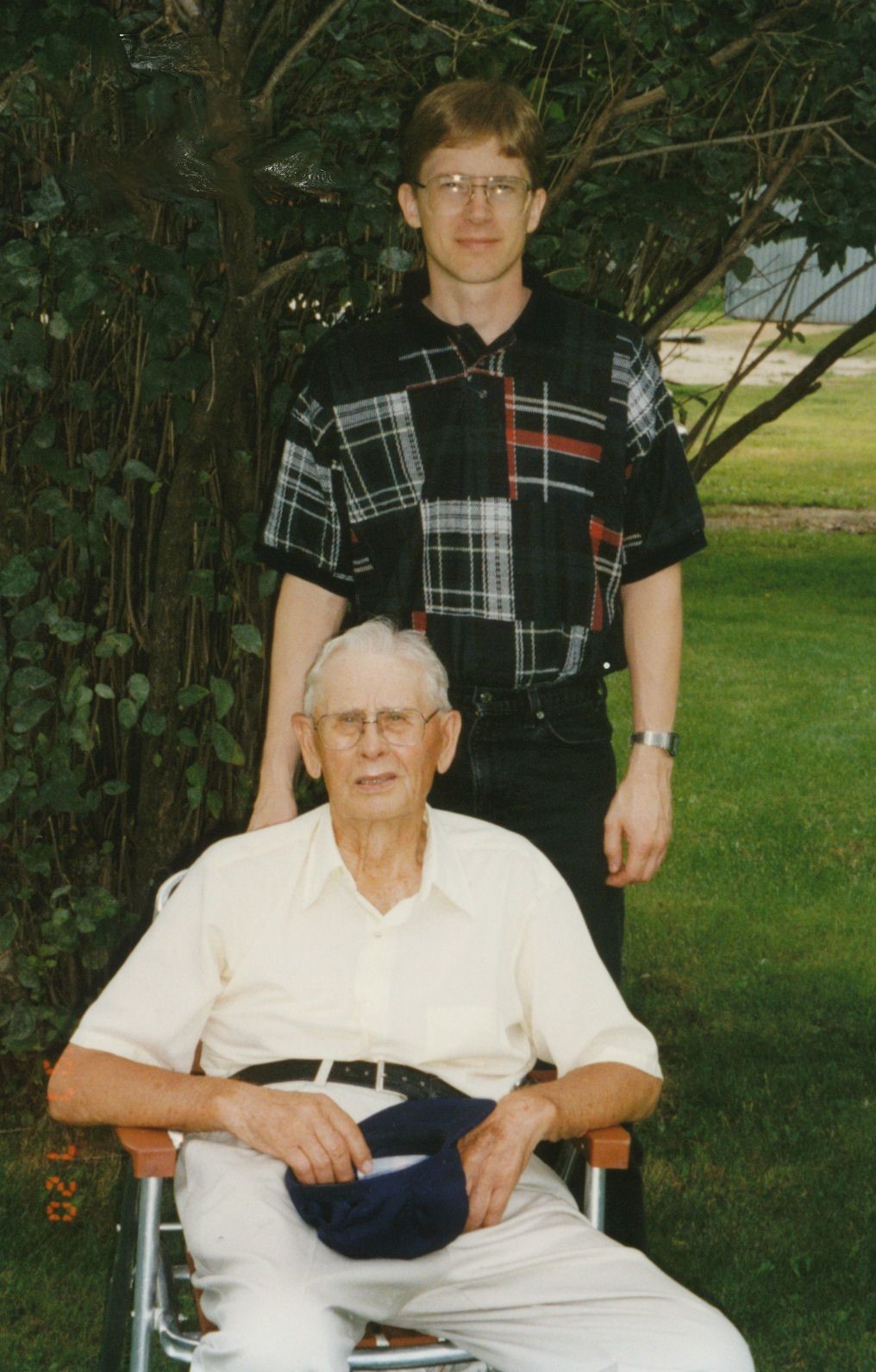
Brian Hookom born on his Grandpa's birthday
Grandpa’s brothers and sister and their families would also come to visit. Maurice and Deloris Nelson and some others where quite the talkers. Wayne Nelson would bring out a couple of the old style Honda 3 wheelers with the balloon tires, some were injured but nobody died. Gary Nelson would often bring a little motorcycle that we would take turns riding on the field trails. One time Ronny Bomsta rolled in driving a souped up VW Beetle. The backseat was stocked with various interesting weapons, some may have been illegal. We often shot guns at the farm but they were just 22 cal rifles or shotguns.
For any summer gathering at the farm we would play ball on the east side of the house. Uncle Stan impressed all us kids by hitting homers over the border trees of the main yard. My brother Mike and I would have wrestling matches with cousins Dave and Donald. We would make forts in the hay loft of the barn. The barn seemed in tough shape back in the 60s even though it stood until knocked down 40 years later. It was also great fun to explore in the woods. There were old cars, tractors and machinery to play on. Years later when all the junk was removed from the woods and the barn was knocked down I felt like the farm was gone for me.
Grandpa and Grandma had all of the grandchildren take turns staying for a week. This was when we got a better idea of life on the farm. We would help with chores but also got to spend time having fun. We got to meet some of the neighbors as it was common for people to help each other out. Russell Hanson would stop by at lunch or snack time and tell WWII stories. Grandpa’s buddies would stop by to visit and they would speak Lake Lillian Norwegian and swear. I quickly learned that I was not allowed to.
When I was very young I was playing on the Farmall B tractor. I started it by accident and it just took off. I didn’t know how to stop or shut it off so I just kept turning in circles trying to avoid running into anything. Grandpa came running and was able to get on board and shut it off. At the time I thought he probably saved my life. If Grandpa was out in the field you spent your time with Grandma. Grandma would make lunch to bring out to him. When I was old enough (maybe 10?) Aunt Elaine would let me drive the ‘68 Ford Galaxy out to the field to deliver lunch. When there was a breakdown Grandpa would fix it himself. He had an old dark shed filled with tools, parts, and junk. Sometimes he would go into the shed and come out with what he needed but sometimes we had to go to Atwater. We would get in the ‘56 light blue Mercury and drive on gravel roads with the windows down and maybe holes in the floor. I remembered wishing I could hold my breath longer; it was hard to breathe all of that dust.
Baling hay was one of my favorite things as a child. I remember riding the rack with Gary Nelson when we were just big enough to throw the bales 4 high. We thought we were really tough when we got a bale up 5 high. At break time in the field Grandpa would take out 2 ice water jugs. I think he had 2 so he didn't have to share with Johnny. Johnny's nickname was Snoose, for obvious reasons.
Since Grandpa was a dairy farmer you had to help out with the cows. It was fun to go out to the pasture with Grandpa and the dog to get the cows. You would get their attention and then these huge animals would just kind of head to the barn. I always worried they might attack me. I hated going into the barn when the cows were there, cows are big and there were always stories of people who had been kicked. The thing about the cows I liked is that they pooped. This meant that I got to help spread manure which meant I got to drive the tractor for real.
I remember as a little girl lying in the back seat watching the power line go by as mom drove us there.
I stayed over a lot in the summer. There was always so much to do. I could lie in bed and hear the morning routine in the kitchen. It often was Russell Hanson with the latest stories.
When we went to town I could pick out a cold cereal but I would rather have grandma’s pancakes or poached eggs. There were hot drinks like Russian tea, cocoa or cider.
I would help grandma the most. There was always something to do - baking, sewing, cleaning. As I got older we would do spring and fall cleaning, paint and varnish, and every year plant and weed the garden and pick raspberries.
Grandma and I would go shopping to Willmar, Hutchinson or Litchfield. Sometimes it was for clothes at Avalon’s or Habicht’s. There were times we went to Hennen’s for furniture she picked out and paid for with her own money.
I would help make fabric strips and roll into balls so we could take them to the rug lady. I still have several rugs that I had made when we first got married.
She taught me how to patch grandpa’s work clothes as I got older and help with quilts. Once she took me to her church quilting group to show them how I sewed my edges and turned the quilt inside out for a quick finish.
I enjoy having cookbooks where Grandma has written if she liked the recipe and what changes she would make next time. I am one of the lucky ones who got to have a lesson on Norwegian lefse making with Grandma and Ethelyde. Now Earl is the master.
I got to go with grandma to work at the nursing home in Cosmos sometimes. Once I had my friend Paula with and there was a little lady in a wheelchair that kept chasing us down the halls. Paula was very frightened by this and remembers the experience vividly.
Grandma would ask a lot of questions and give advice if we needed. She would talk about life situations or people that were challenging in her life and share how she was dealing with it.
I loved when we would ride out in the truck to bring lunch …how fun to have a picnic every day. I think that field road drive was where many had their first behind the wheel experience.
I was scared of the bull and did not like the billy goat! Some chickens were nasty. I hated chicken butchering day with mom but I am not afraid to touch raw meat like some of my friends because of that experience.
I would visit grandpa in the barn and ask a lot of questions. I was nicknamed Tissy Ann by grandpa. I loved the kitties and would give them milk. When I was older I could help give each cow their ration of feed and hay. Oh yeah and scrape their recycled business into the gutter. This training helped me later in years when Earl and I were dating. I was very helpful on their family farm…earned some major points. One difference was grandpa didn’t let me drive the tractor much where Earl did. When we were farming Ethelyde’s land I remember grandpa was not really thrilled of Earl’s decision to let me plow but I did a good job I think…but grandpa never had me help plow his land so maybe it wasn’t as good as I thought.
I loved how grandpa and grandma just adored Earl. Earl loved grandpa in a special way having lost his dad he felt very close to grandpa and appreciated being loved by him. They were good for each other.
I remember them making it to many grandkids special events and always happy to see family and be together.
I am very blessed to have had such a wonderful relationship with them both and to have them so much a part of my early years of marriage.
I have to say the most valuable thing that my grandparents taught me was a strong work ethic. They told me to be a great worker. I've done my best at any job and took their advice.
I remember days and nights spent at the farm as an adventure. I experienced things that just never seemed to happen at home. I think it was a prequel to my life now; living close to wild life sometimes can really bring on the un-expected or un-foreseen. When spending the night at the farm, Grandma and Grandpa would often let us stay on the sofa-bed in the living room. We (as in the Gronli kids) could stay up late and watch the news with Grandma when we slept on the sofa-bed. Grandpa never made it past 8 PM. He was an early to bed, early to rise kind of man. Grandma really liked to stay up to date on current affairs, so she always watched the 10 PM news. As a guest in the living room, so did I. One night, after the news had wrapped up and Grandma was about to start heading to bed, we had a strange fluttering buzzing by our heads. Grandma immediately knew what was going on. We had A BAT!!! Quickly Grandma located that tennis racket we kids had always been playing with, rubbing on our heads, and probably gnawed the edge of it a time or two. Well, to my surprise the tennis racket was used for much more than tennis. Grandma quickly turned into a skilled bat killer. I remember hiding my head under the covers for most of the action. I did catch one key detail that kept me awake for most of the night. That feisty bat, when Grandma made her final fatal blow landed dead on my pillow. Yes, on my pillow. When I asked Grandma for a new pillow, she just used her wise motherly skills and flipped it over for me. Yes, she just flipped it over saying "just use this side." Did I ever share with you I had a keen sense of smell as a kid? I was sure I could smell dead bat guts on my pillow. A moment of adventure and heeby- jeebies all in the same night.
Yes, I the granddaughter #2 of the most beloved Grandparents on the planet am recalling some of my favorite memories of the life on the farm and some early lessons. Am proud to claim I did own a set of the famous Wonder Woman Underoos. Underoos were a shiny set of spandex under wear tank and bottoms with the prints to match the Wonder Woman character from a TV program back in the early 1980’s. At the farm I had freedom to wear them at the farm, as my outfit. One day while I was out in the yard and around the barn. I was running around the yard being the best Wonder Woman imposter I could imagine. I ended up at the barn, not paying attention to any real potential dangers I flopped my body back against the barn door... only to shout out in pain. Horrified to find out what a barn nail felt like piercing through my Wonder Woman Underoos own skin, I wheeled into the house as fast as my legs could run. Luckily, Grandma was able to apply first aid to my wound. She helped stop the bleeding and soothed me with kind words. I do remember once I had calmed down, a brief scolding “to be careful by the barn.” After that day I stuck to wearing jeans for a better layer of protection when playing in the yard and in the barn.
I have many good memories of grandma and grandpa Bomsta--bird watching and eating cookies around the dining room table, lutefisk at Christmas. Coaxing a smile from grandpa for holiday photos, grandpa teaching Emily how to drive on the farm roads, family gatherings at the farm, grandpa in his overalls and grandma always smiling.
Grandpa taught us how to have a good sense of humor, always giving nicknames and teasing-smiling all the while like he was up to no good.
He teased Emily and me that Max wasn't a real dog... but when no one was looking, he would smile and pet him. Grandpa definitely had a soft side too. During a visit to the farm, I remember sitting with grandma in the living room when the phone rang. Grandma answered and quickly said, "Wilton isn't here--if you want to reach him, write him a letter" and promptly hung up. I remember being a little stunned. I had not seen this no-nonsense side of grandma before! Coincidentally, this must be where my dad inherited his impatience for telemarketers.
Grandma and grandpa were hardworking, caring and strong. Most importantly, they were devoted to each other. Many people don’t have the opportunity to meet their great grandparents. I recognize and greatly appreciate the strong values they set and feel very blessed to have known them.
Things that I remember about Grandma and Grandpa Bomsta are going to the farm and playing in the barn, riding on the tractor, that time we all went and painted the house, he always called Andrew 'Oscar', and more recently I remember going to the nursing home and spending time with him in that last month. Before that I never really had time with just him and it was very special to have that time with Grandpa Bomsta. I remember when he had the cancer surgery and someone told me that they were taking an inch out of his stomach and for years after that I thought they had literally made him an inch shorter. I feel pretty silly about that now. (Amber would have been almost 8 years old)
After reading many memories from you and our extended family plus family friends I began to wonder what the big drawing card to the farm was. Most people mention that they enjoyed working at the farm. The saying “A family that sweats together – stays together” must be true. How could picking rocks or baling hay on a hot day be fun or cleaning the chicken house in the spring be considered exciting? Food and fun family times, softball games, playing in the hay mow or the woods were also mentioned frequently.
Could it have been the special feeling you get when you are in the wide open spaces or the sounds of the birds and animals or the rustle of the wind in the trees: the smells of freshly cut alfalfa, tilled soil, a summer rain shower and yes, there were some unpleasant odors; the sights of spring flowers, garden produce and crops ready for harvest, rainbows, sunrise and sunsets; the excitement to see a deer walking close by? Many of you spent hours sitting quietly in a duck blind or deer stand or went on a long walk on the back field road. In our busy world we all need a place of quiet refuge.
Mom and Dad carried emotional scars from their youth and knew the importance of faith, family and friends to carry them through life. They never achieved great monetary wealth but knew they were very rich because of the loving support from their family and neighbors. When adversities come our way, let us look back to the strong heritage we have been given by all of our ancestors.
We have been very fortunate to have had the farm to gather for many years. It is wonderful to have this written word to trigger memories and take some time to remember days gone past. I am glad that we have a story now to share with family members who didn’t get the chance to know Grandma and Grandpa Bomsta. Thanks again for your participation.
The words from the first line of hymn “Near to the Heart of God” describe our enjoyment and blessings of the farm. “There is a place of quiet rest, Near to the heart of God,” and the last line “Hold us, who wait before thee, Near to the heart of God.”